Walking Machine Technology: Medical Field – Disabled Patients


Walking Machine Technology: Medical Field – Disabled Patients Planetary Exploration Undersea Dredging/Salvage Radioactive Environments (power plants, etc.) Military Support
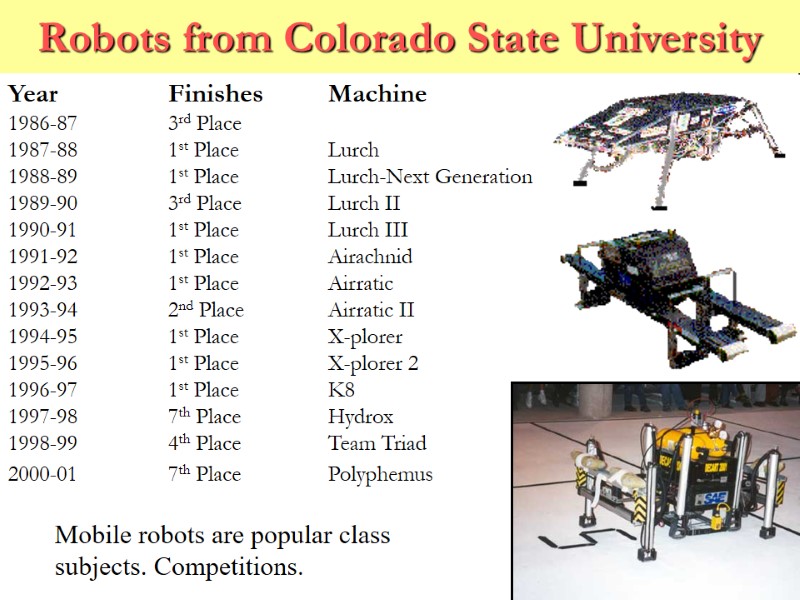
Robots from Colorado State University Year Finishes Machine 1986-87 3rd Place 1987-88 1st Place Lurch 1988-89 1st Place Lurch-Next Generation 1989-90 3rd Place Lurch II 1990-91 1st Place Lurch III 1991-92 1st Place Airachnid 1992-93 1st Place Airratic 1993-94 2nd Place Airratic II 1994-95 1st Place X-plorer 1995-96 1st Place X-plorer 2 1996-97 1st Place K8 1997-98 7th Place Hydrox 1998-99 4th Place Team Triad 2000-01 7th Place Polyphemus Mobile robots are popular class subjects. Competitions.

Design of a Rough Terrain Vehicle (RTV)
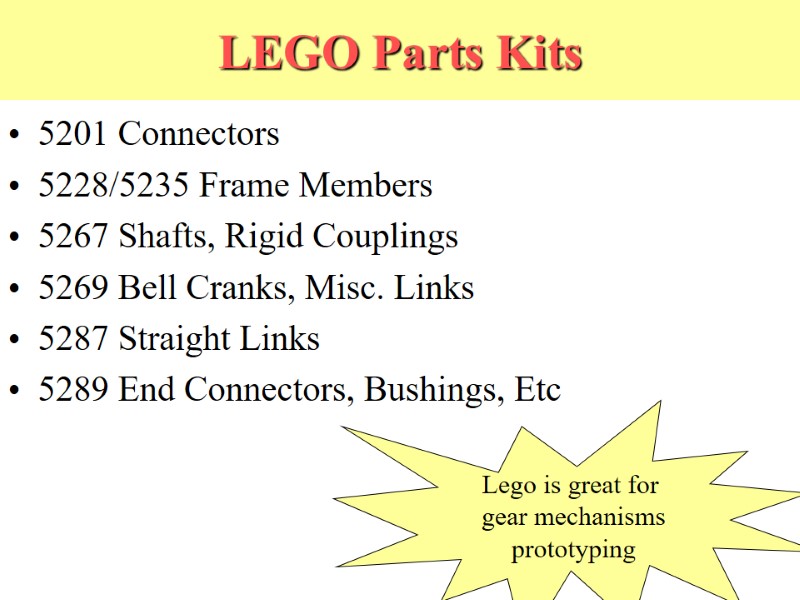
LEGO Parts Kits 5201 Connectors 5228/5235 Frame Members 5267 Shafts, Rigid Couplings 5269 Bell Cranks, Misc. Links 5287 Straight Links 5289 End Connectors, Bushings, Etc Lego is great for gear mechanisms prototyping

LEGO Parts Kits 9854 Rack & Pinion Gears 9965 Two sizes, small spur gears 9966 Two sizes, larger gears 9966/67 Appear to have same Pitch 9967 Bevel & Planetary Gears
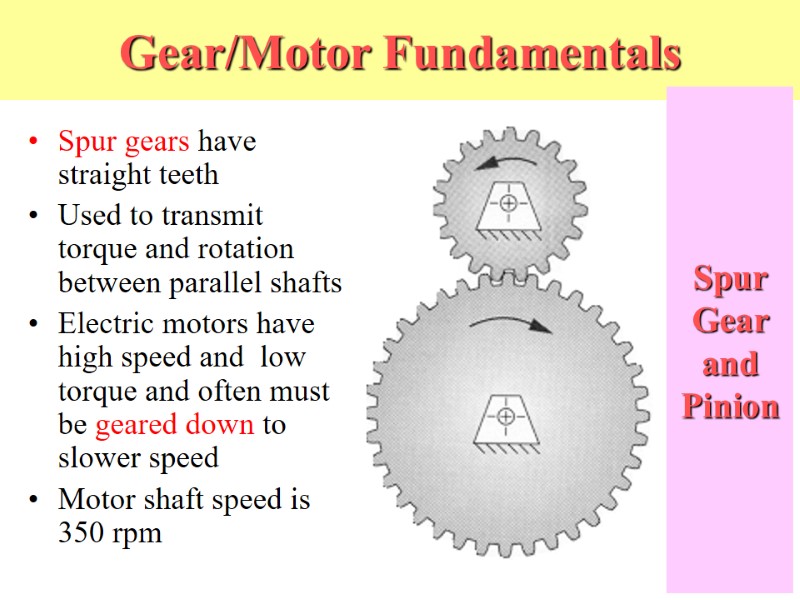
Gear/Motor Fundamentals Spur gears have straight teeth Used to transmit torque and rotation between parallel shafts Electric motors have high speed and low torque and often must be geared down to slower speed Motor shaft speed is 350 rpm Spur Gear and Pinion
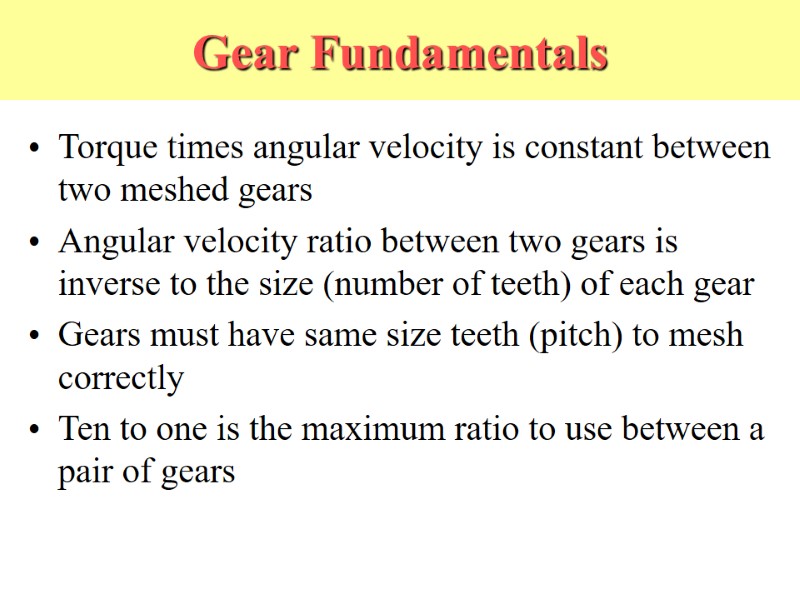
Gear Fundamentals Torque times angular velocity is constant between two meshed gears Angular velocity ratio between two gears is inverse to the size (number of teeth) of each gear Gears must have same size teeth (pitch) to mesh correctly Ten to one is the maximum ratio to use between a pair of gears
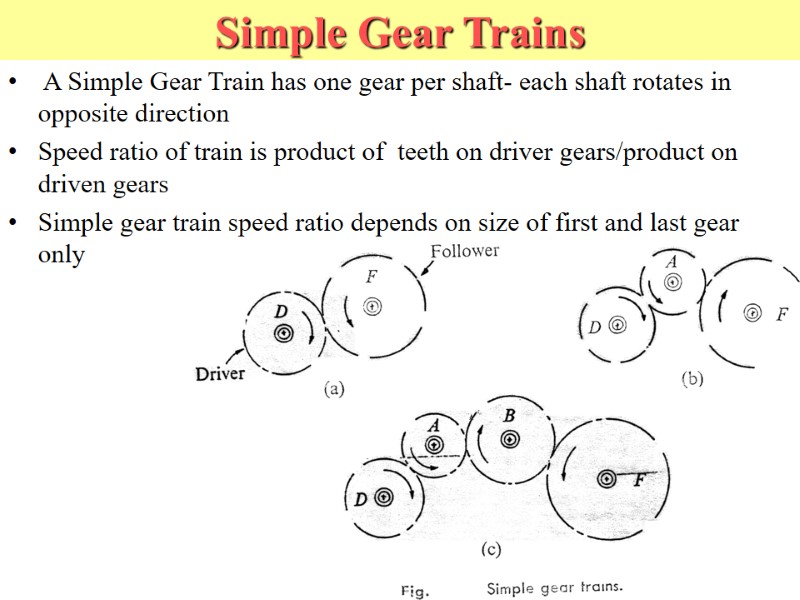
Simple Gear Trains A Simple Gear Train has one gear per shaft- each shaft rotates in opposite direction Speed ratio of train is product of teeth on driver gears/product on driven gears Simple gear train speed ratio depends on size of first and last gear only
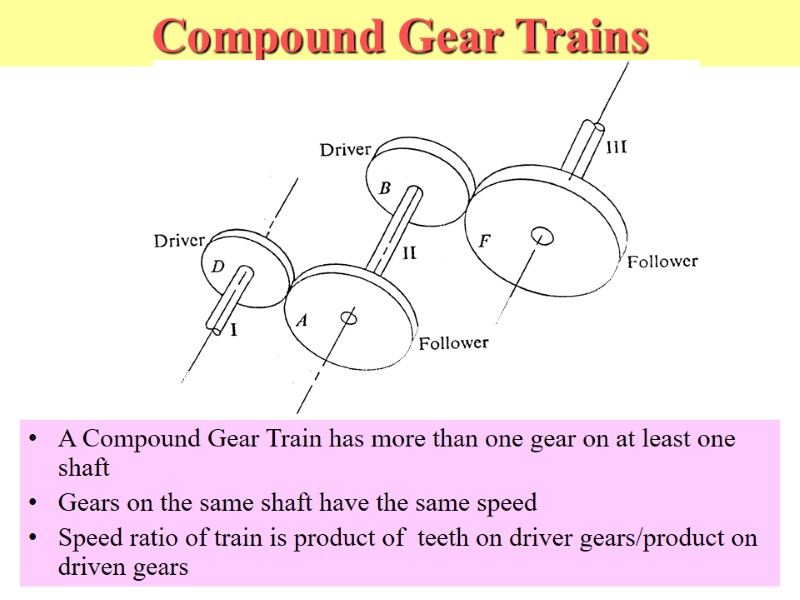
Compound Gear Trains A Compound Gear Train has more than one gear on at least one shaft Gears on the same shaft have the same speed Speed ratio of train is product of teeth on driver gears/product on driven gears
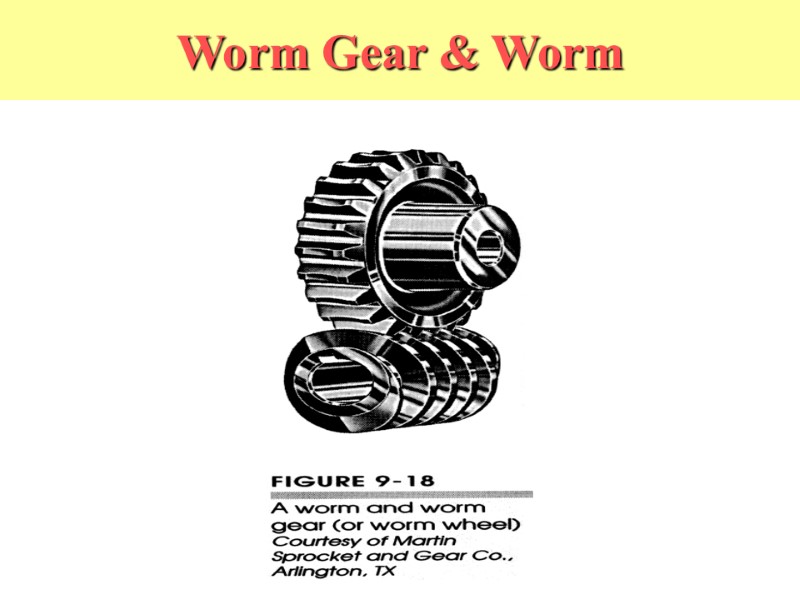
Worm Gear & Worm
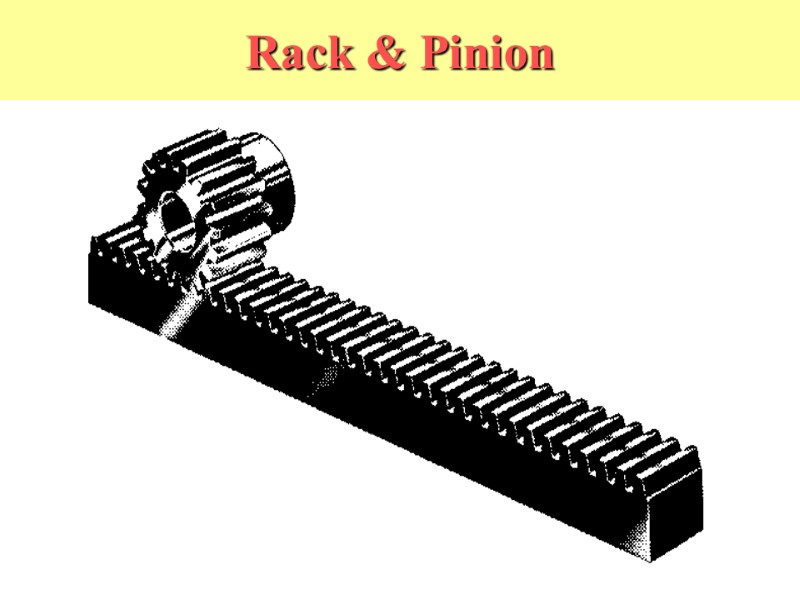
Rack & Pinion

Straight Bevel Gears
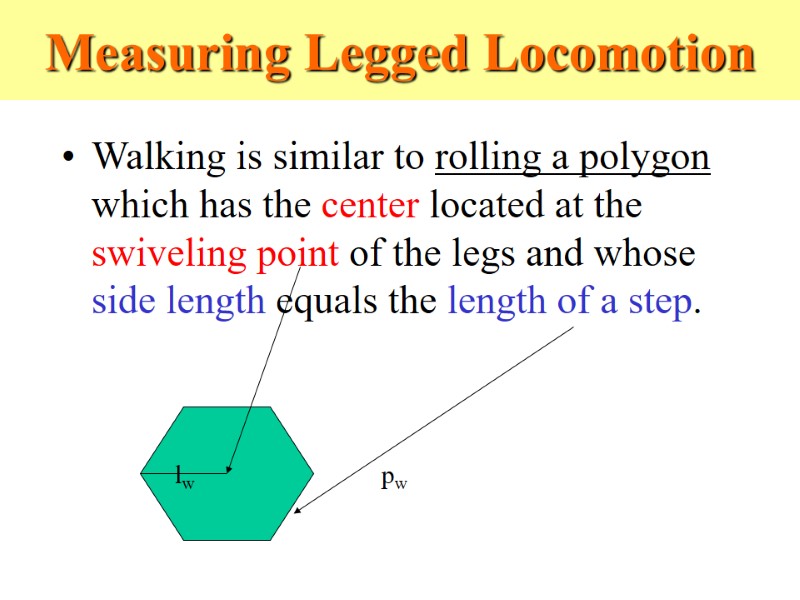
Measuring Legged Locomotion Walking is similar to rolling a polygon which has the center located at the swiveling point of the legs and whose side length equals the length of a step. lw pw
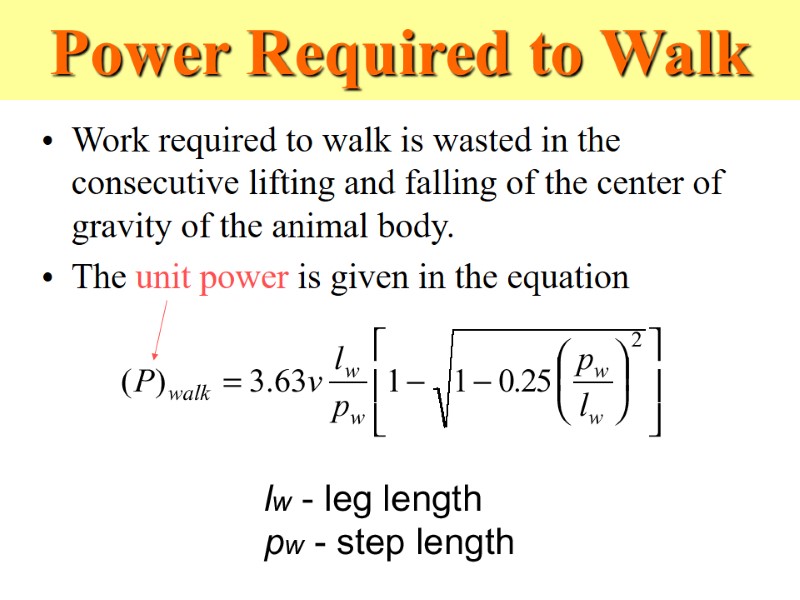
Power Required to Walk Work required to walk is wasted in the consecutive lifting and falling of the center of gravity of the animal body. The unit power is given in the equation
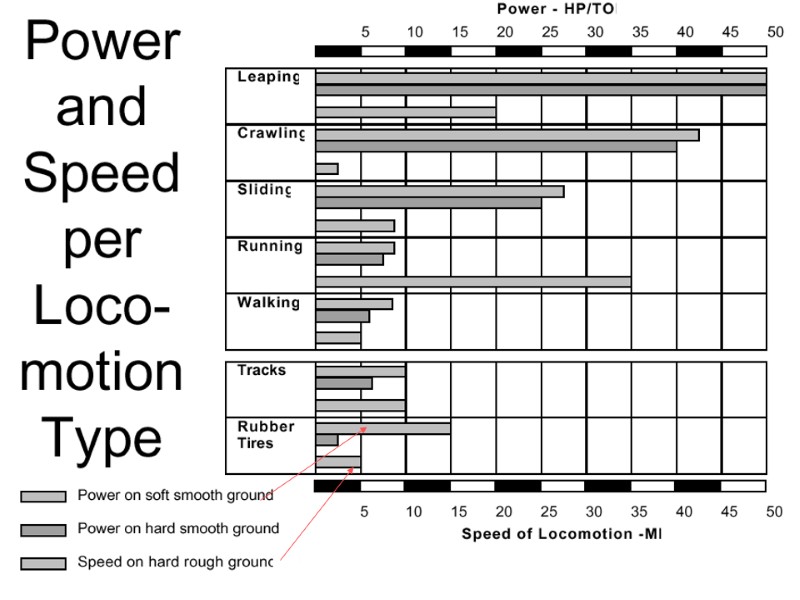
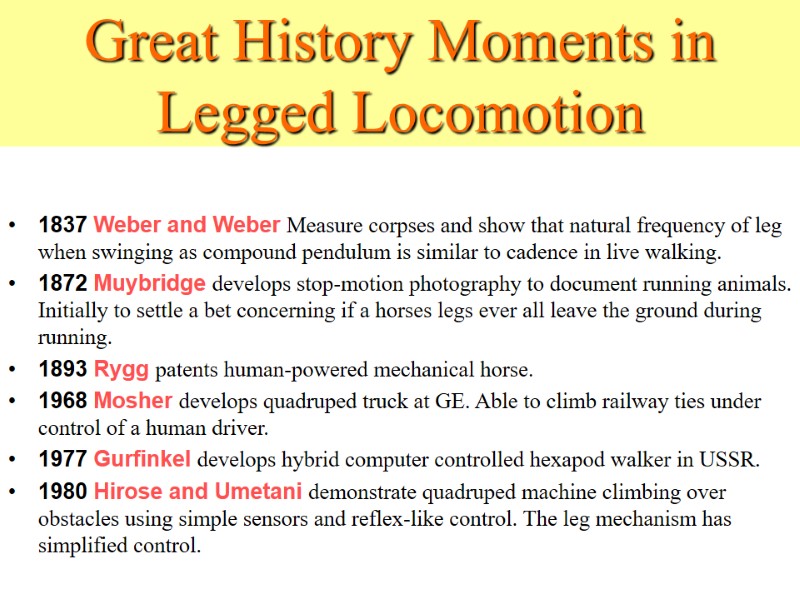
Great History Moments in Legged Locomotion 1837 Weber and Weber Measure corpses and show that natural frequency of leg when swinging as compound pendulum is similar to cadence in live walking. 1872 Muybridge develops stop-motion photography to document running animals. Initially to settle a bet concerning if a horses legs ever all leave the ground during running. 1893 Rygg patents human-powered mechanical horse. 1968 Mosher develops quadruped truck at GE. Able to climb railway ties under control of a human driver. 1977 Gurfinkel develops hybrid computer controlled hexapod walker in USSR. 1980 Hirose and Umetani demonstrate quadruped machine climbing over obstacles using simple sensors and reflex-like control. The leg mechanism has simplified control.
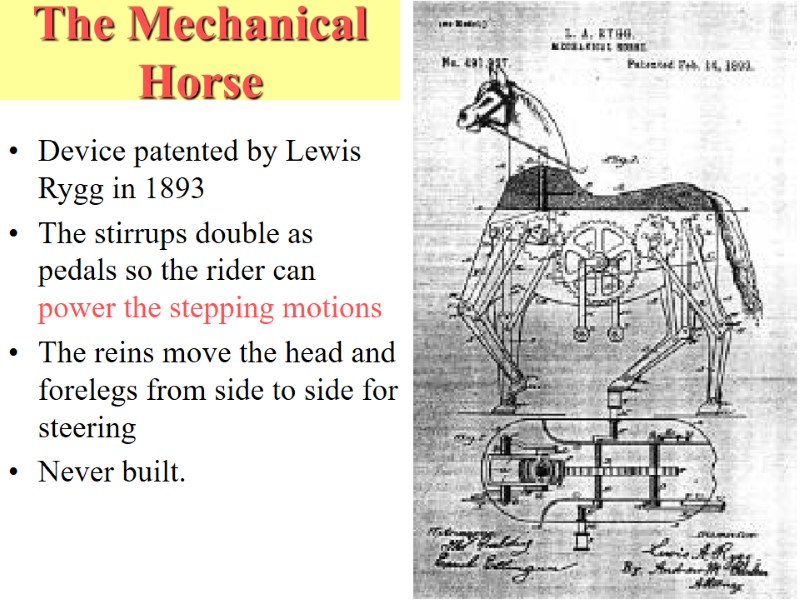
The Mechanical Horse Device patented by Lewis Rygg in 1893 The stirrups double as pedals so the rider can power the stepping motions The reins move the head and forelegs from side to side for steering Never built.
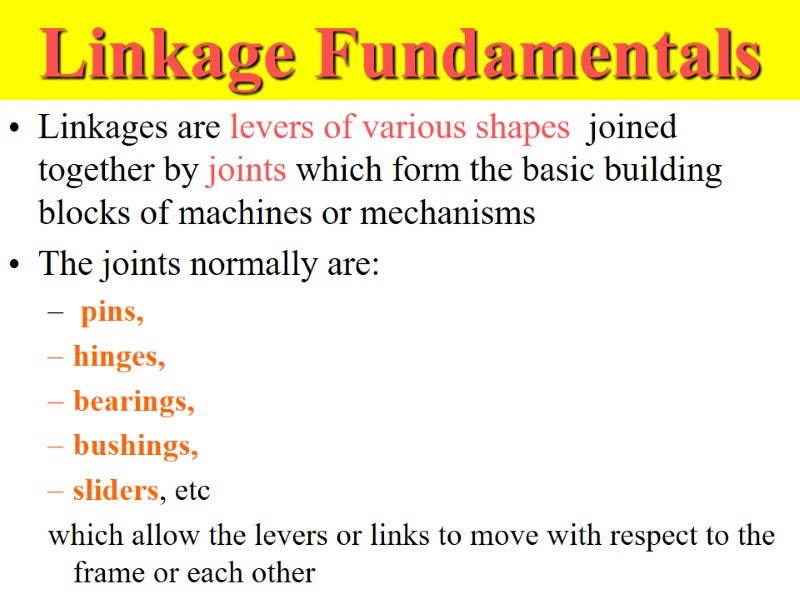
Linkage Fundamentals Linkages are levers of various shapes joined together by joints which form the basic building blocks of machines or mechanisms The joints normally are: pins, hinges, bearings, bushings, sliders, etc which allow the levers or links to move with respect to the frame or each other

Linkage Fundamentals Linkages are normally driven by a short lever This level is also called a crank Crank is connected to the motor or gear train shaft A hole in a gear body that is connected to the shaft can define the length of the crank Linkages are interesting and challenging to work with They are used in many devices used every day
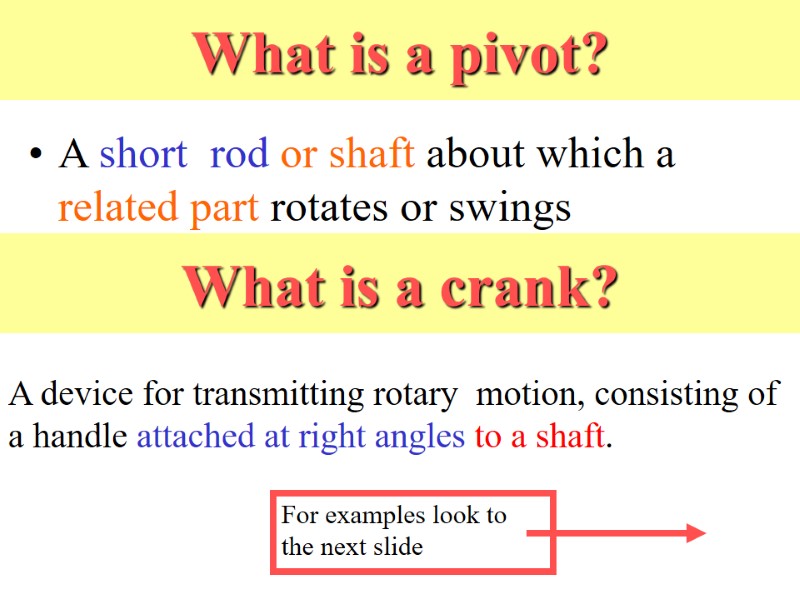
What is a pivot? A short rod or shaft about which a related part rotates or swings What is a crank? A device for transmitting rotary motion, consisting of a handle attached at right angles to a shaft. For examples look to the next slide
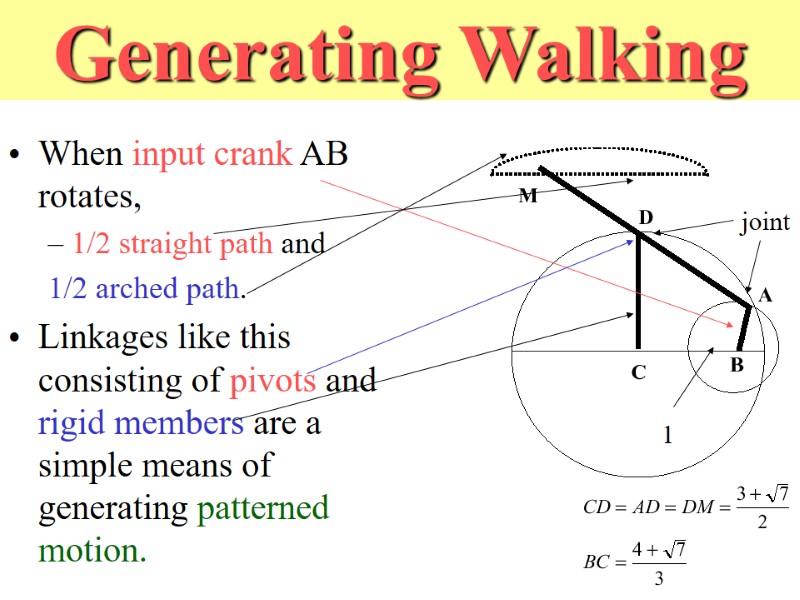
Generating Walking When input crank AB rotates, – 1/2 straight path and 1/2 arched path. Linkages like this consisting of pivots and rigid members are a simple means of generating patterned motion. 1 joint
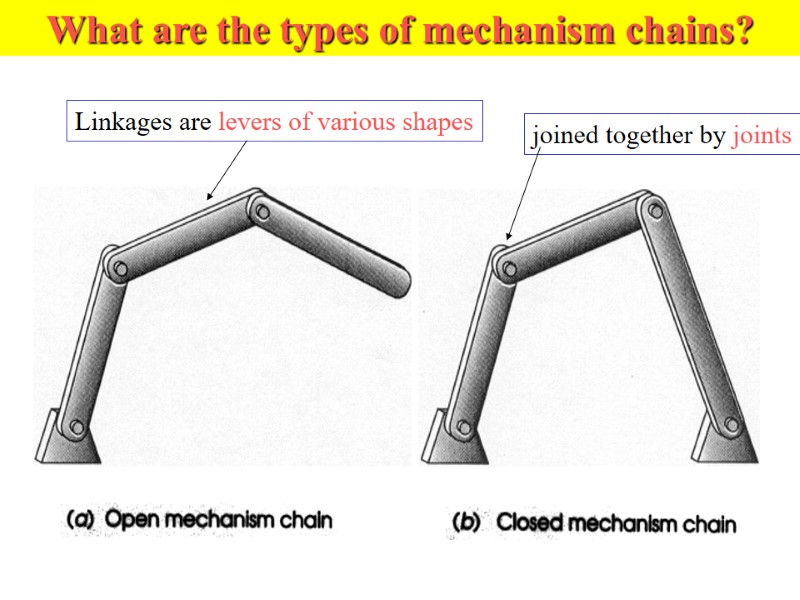
What are the types of mechanism chains? Linkages are levers of various shapes joined together by joints
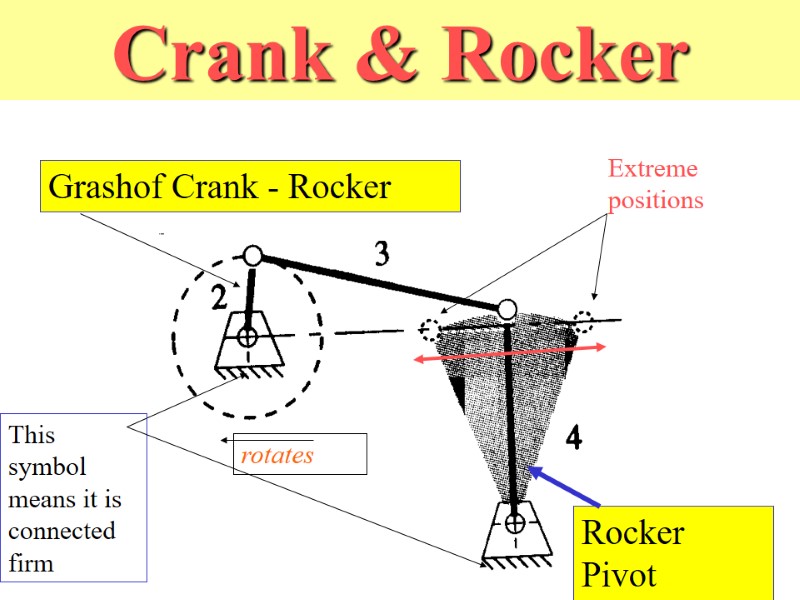
Crank & Rocker Rocker Pivot Grashof Crank - Rocker rotates Extreme positions This symbol means it is connected firm
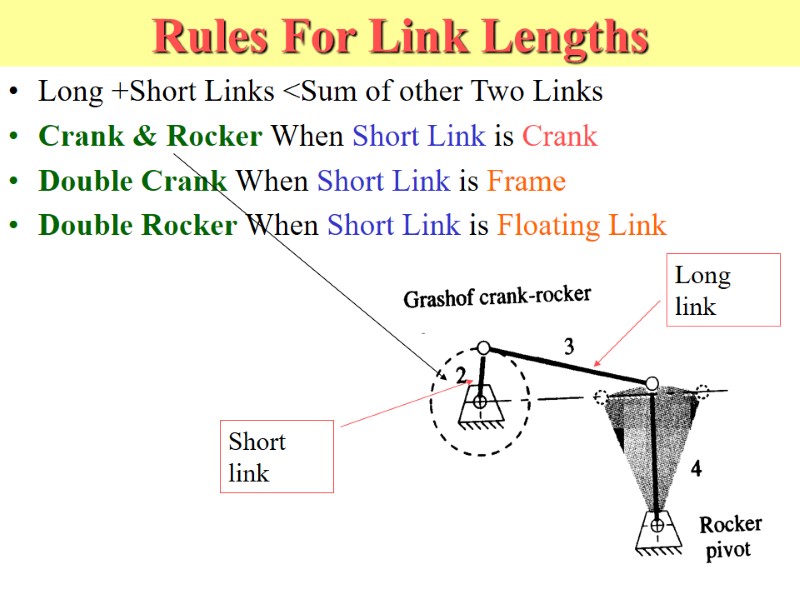
Rules For Link Lengths Long +Short Links
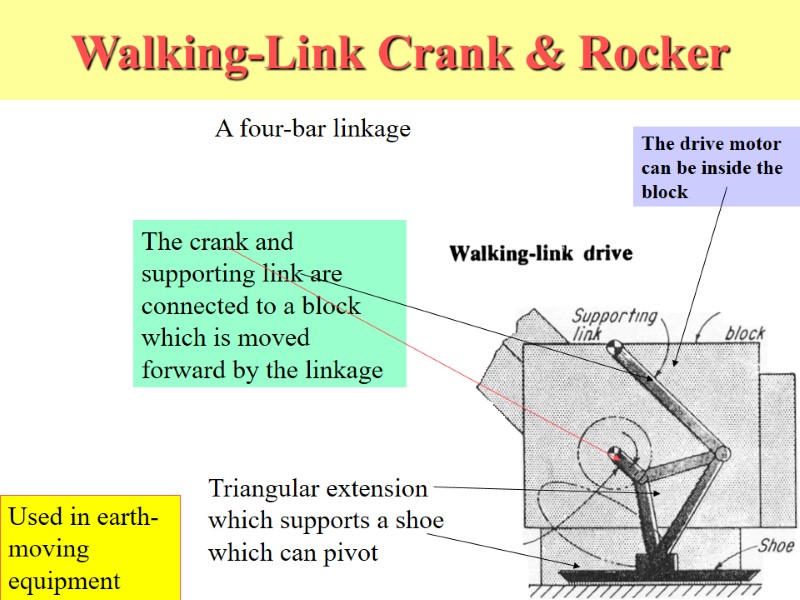
Walking-Link Crank & Rocker A four-bar linkage Triangular extension which supports a shoe which can pivot Used in earth-moving equipment The drive motor can be inside the block The crank and supporting link are connected to a block which is moved forward by the linkage
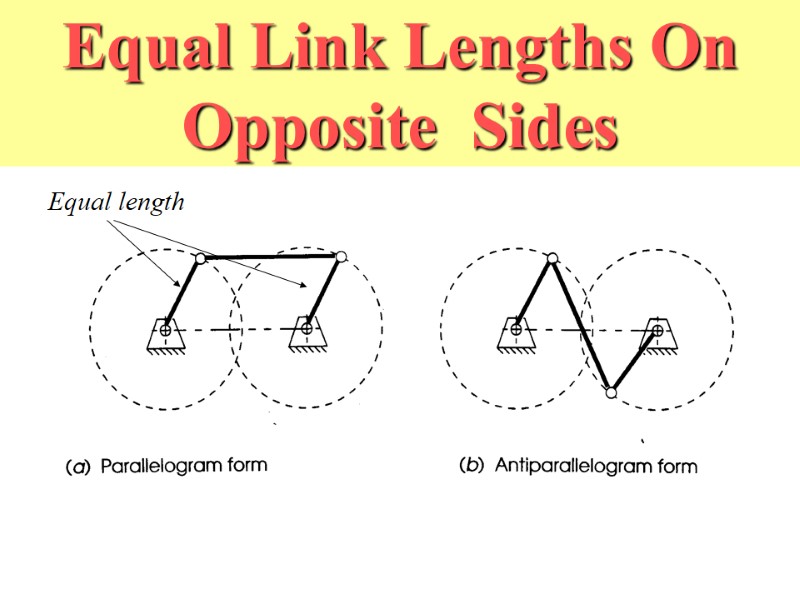
Equal Link Lengths On Opposite Sides Equal length
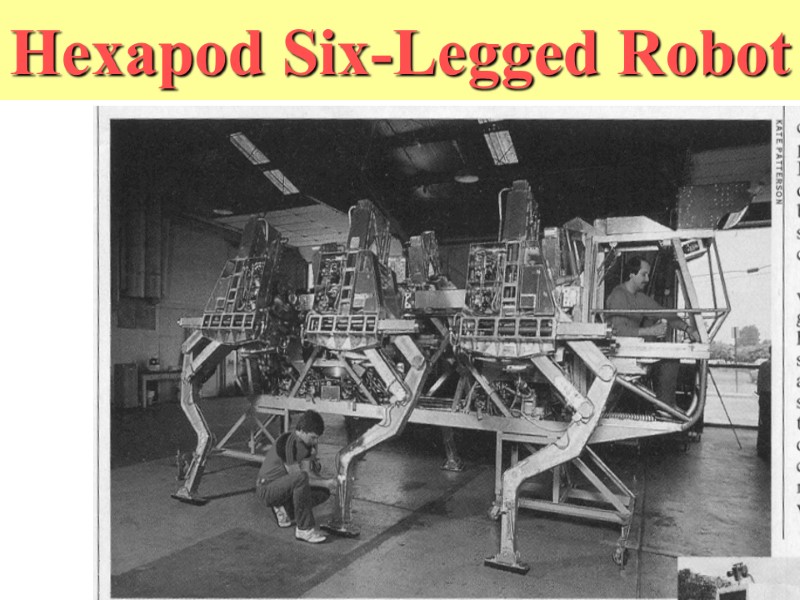
Hexapod Six-Legged Robot

Another Hexapod
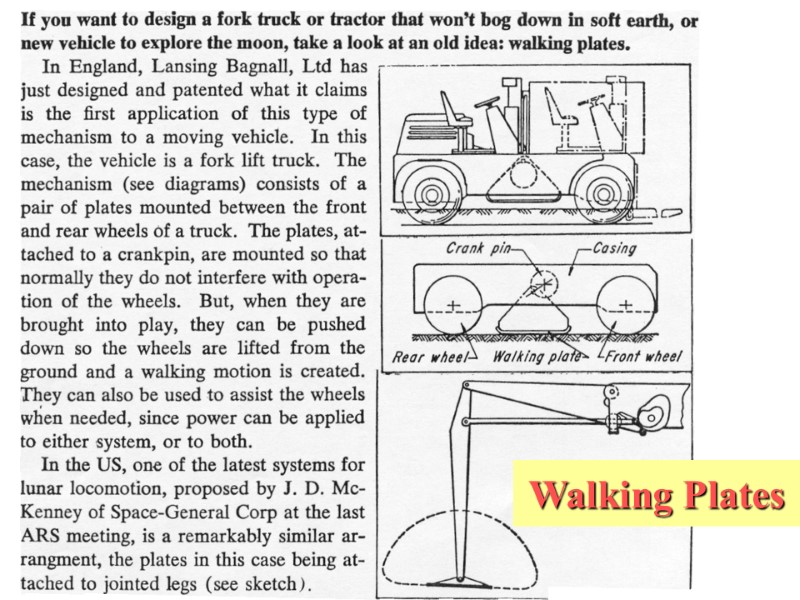
Walking Plates

More Great History Moments 1983 Odetics demonstrates a self-contained hexapod which lifts and moves back end of pickup truck. 1983 Raibert demonstrates one-legged machine which hops in place, travels at a specified rate, keeps its balance when disturbed and jumps over small obstacles. 1987 Waldron and McGhee demonstrate 3 ton self-contained hexapod carrying human driver which moves at 5 mph over irregular terrain and pulls a load. 1988 Hodgins and Koechling demonstrate biped which climbs short stairways, jumps over obstacles and sets speed record of 13.1 mph. 1997 Honda announces its bipedal walking project which has resulted in an autonomous humanoid.
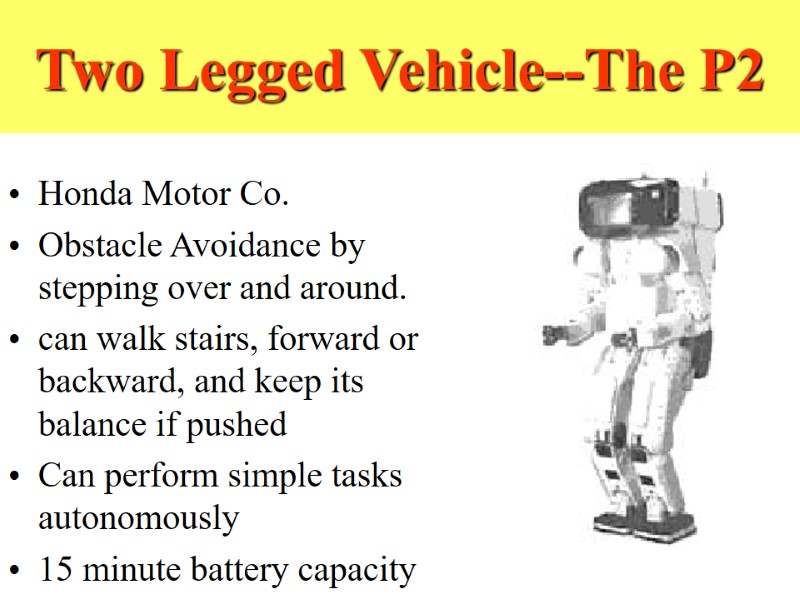
Two Legged Vehicle--The P2 Honda Motor Co. Obstacle Avoidance by stepping over and around. can walk stairs, forward or backward, and keep its balance if pushed Can perform simple tasks autonomously 15 minute battery capacity

Hexapods from Lynxmotion

Lynxmotion Kits Hexapods Cars Arms Quadrupeds Lynxmotion Hexapods
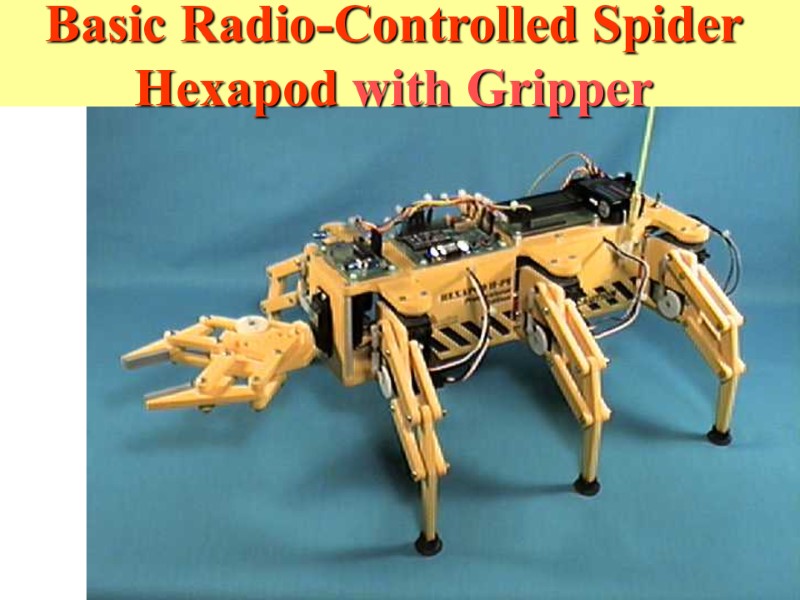
Basic Radio-Controlled Spider Hexapod with Gripper
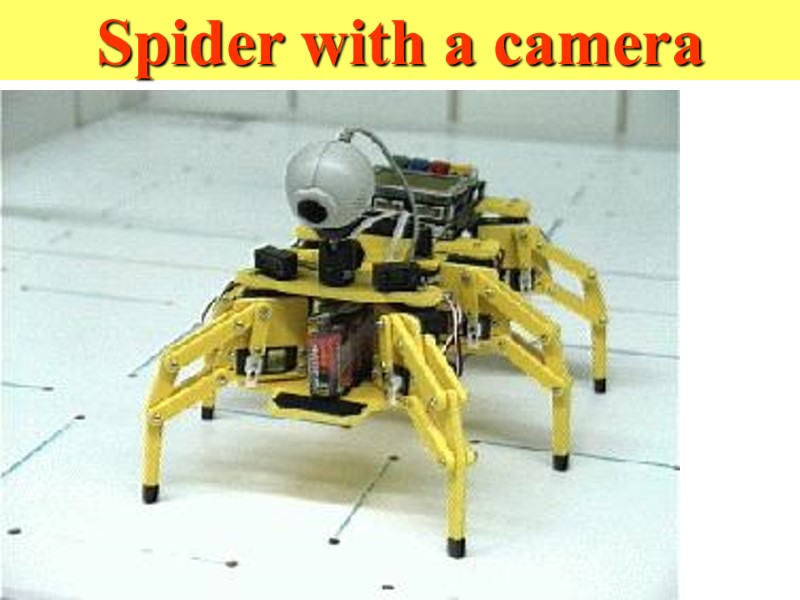
Spider with a camera
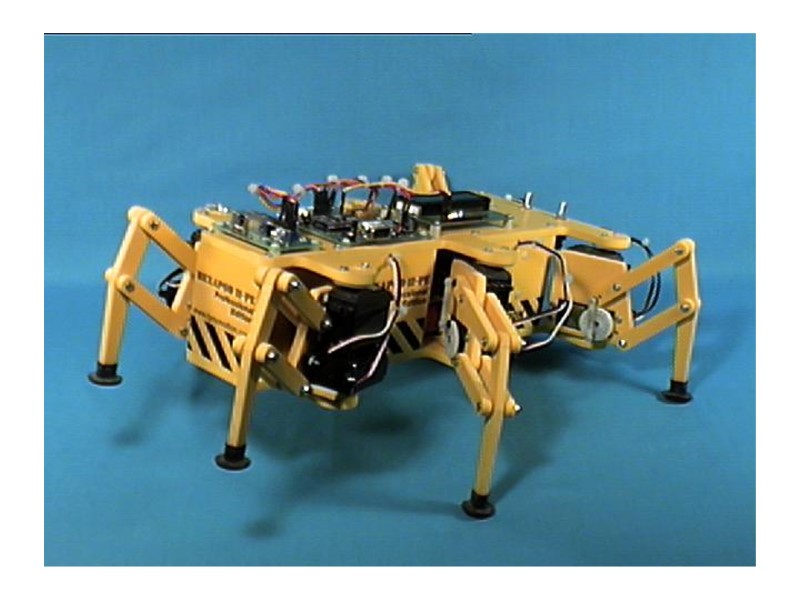
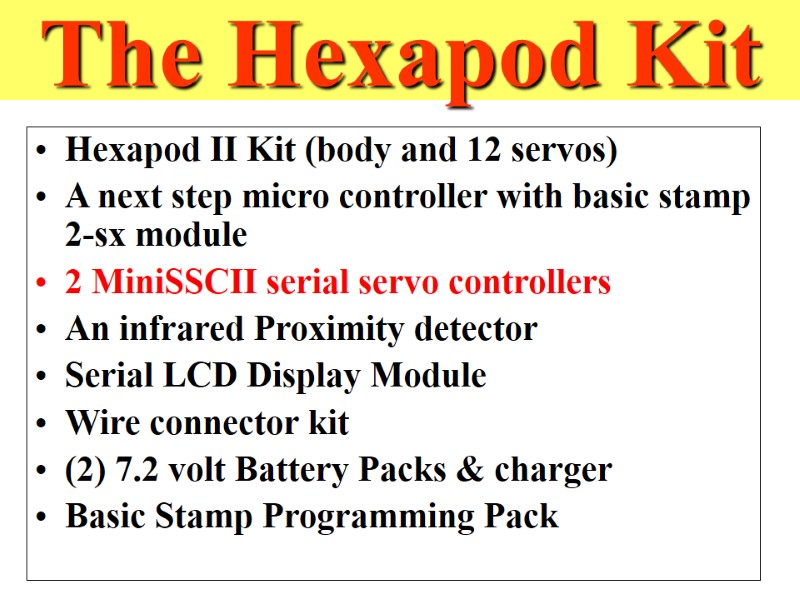
The Hexapod Kit Hexapod II Kit (body and 12 servos) A next step micro controller with basic stamp 2-sx module 2 MiniSSCII serial servo controllers An infrared Proximity detector Serial LCD Display Module Wire connector kit (2) 7.2 volt Battery Packs & charger Basic Stamp Programming Pack

Added Wireless Video Camera Called the XCAM2 Purchased from X10.com It costs $99.99 with a battery pack $79.99 otherwise
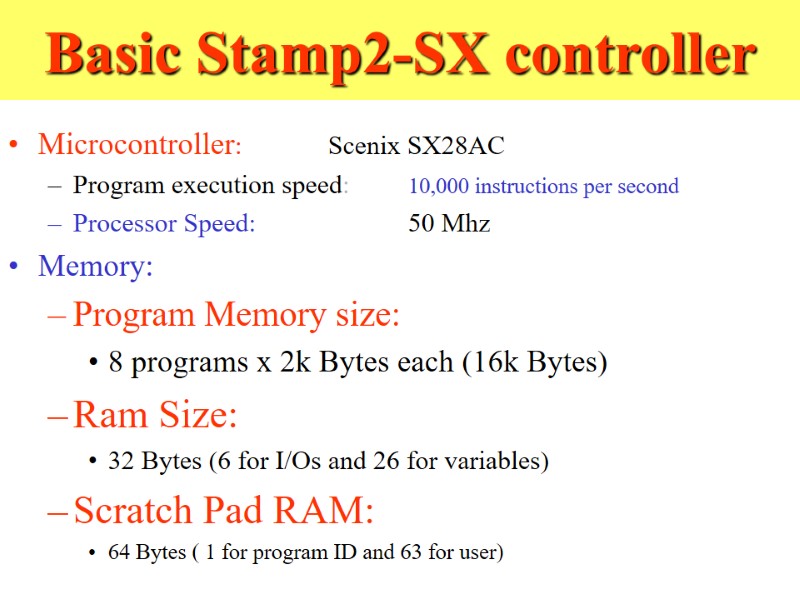
Basic Stamp2-SX controller Microcontroller: Scenix SX28AC Program execution speed: 10,000 instructions per second Processor Speed: 50 Mhz Memory: Program Memory size: 8 programs x 2k Bytes each (16k Bytes) Ram Size: 32 Bytes (6 for I/Os and 26 for variables) Scratch Pad RAM: 64 Bytes ( 1 for program ID and 63 for user)
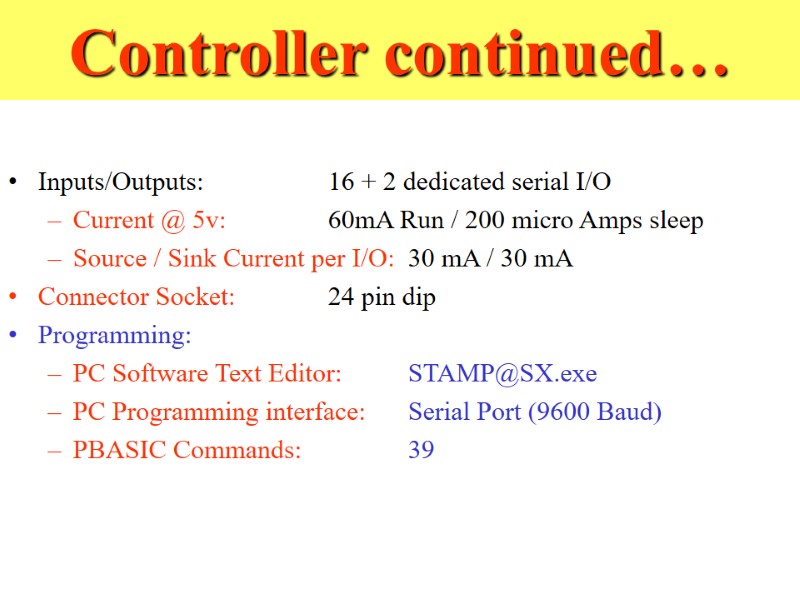
Controller continued… Inputs/Outputs: 16 + 2 dedicated serial I/O Current @ 5v: 60mA Run / 200 micro Amps sleep Source / Sink Current per I/O: 30 mA / 30 mA Connector Socket: 24 pin dip Programming: PC Software Text Editor: [email protected] PC Programming interface: Serial Port (9600 Baud) PBASIC Commands: 39
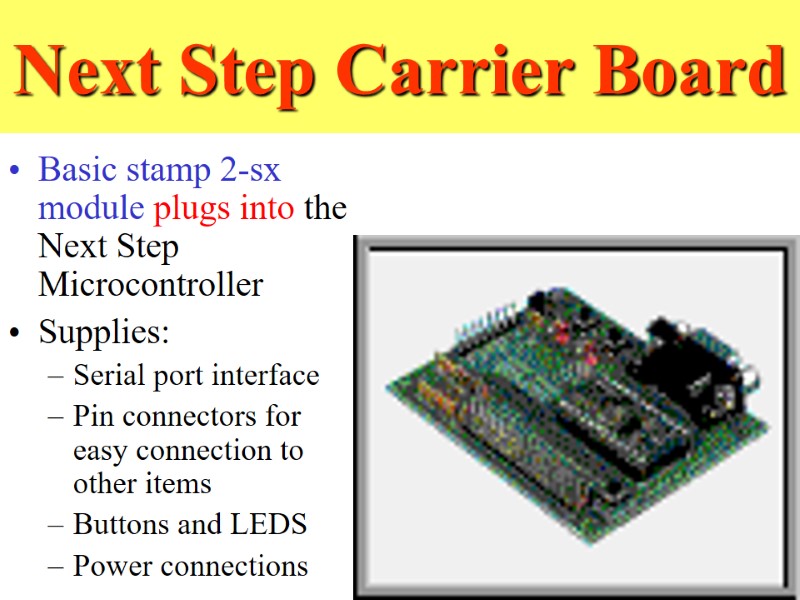
Next Step Carrier Board Basic stamp 2-sx module plugs into the Next Step Microcontroller Supplies: Serial port interface Pin connectors for easy connection to other items Buttons and LEDS Power connections
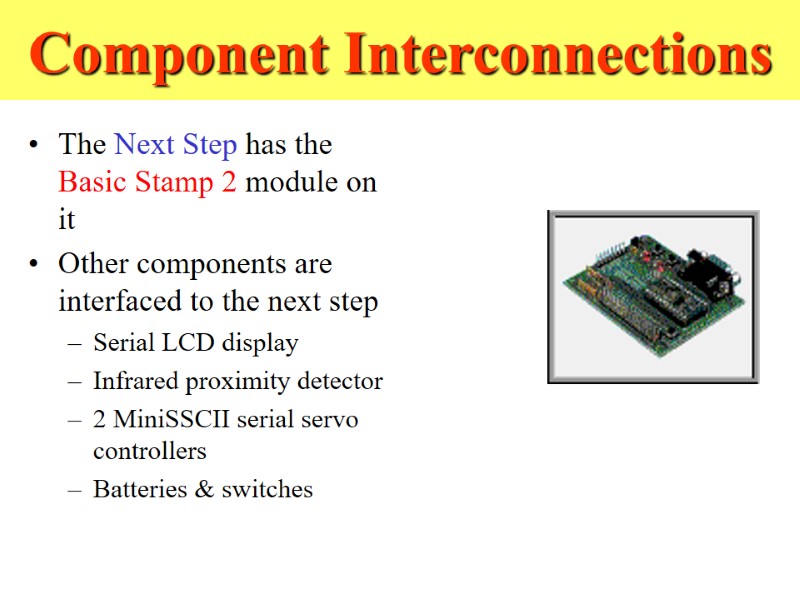
Component Interconnections The Next Step has the Basic Stamp 2 module on it Other components are interfaced to the next step Serial LCD display Infrared proximity detector 2 MiniSSCII serial servo controllers Batteries & switches

Serial LCD Display Power, ground and a single data connection Serial information is sent via the data line The serial display is back lit and displays 16 characters on two lines. ( total of 32 characters)
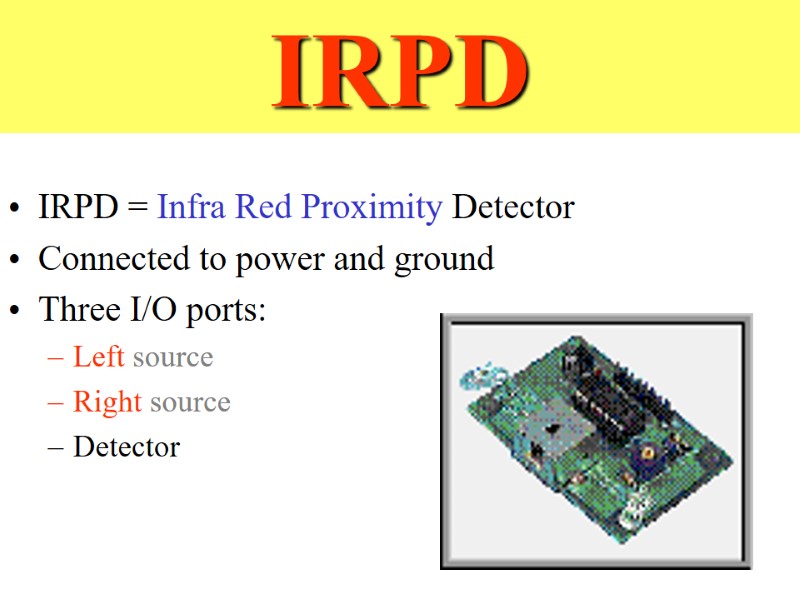
IRPD IRPD = Infra Red Proximity Detector Connected to power and ground Three I/O ports: Left source Right source Detector
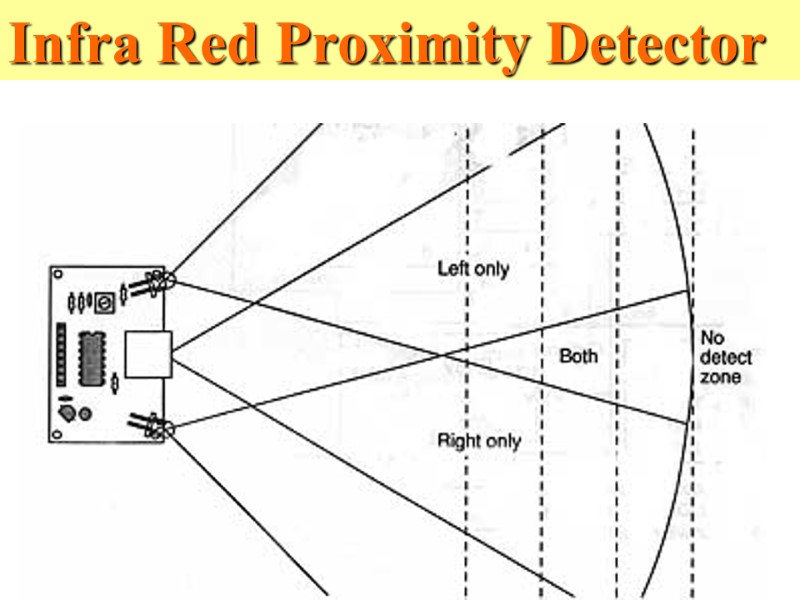
Infra Red Proximity Detector
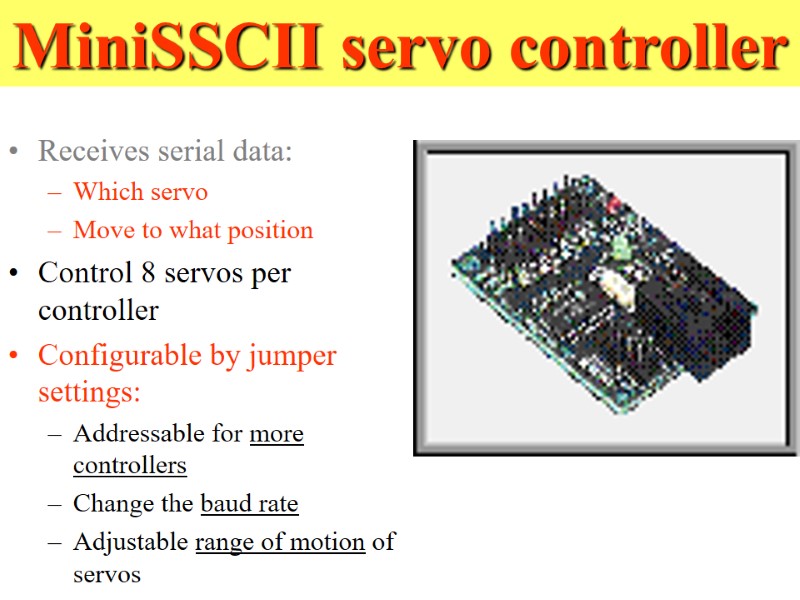
MiniSSCII servo controller Receives serial data: Which servo Move to what position Control 8 servos per controller Configurable by jumper settings: Addressable for more controllers Change the baud rate Adjustable range of motion of servos
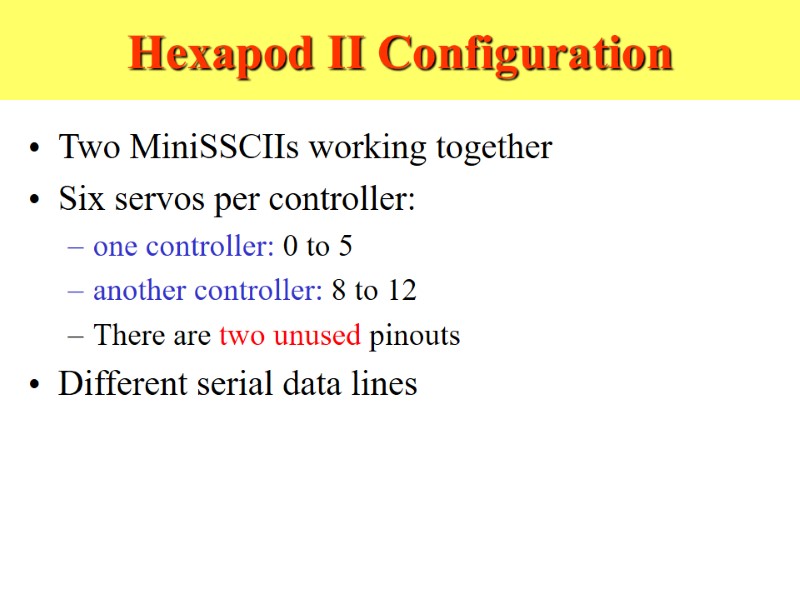
Hexapod II Configuration Two MiniSSCIIs working together Six servos per controller: one controller: 0 to 5 another controller: 8 to 12 There are two unused pinouts Different serial data lines
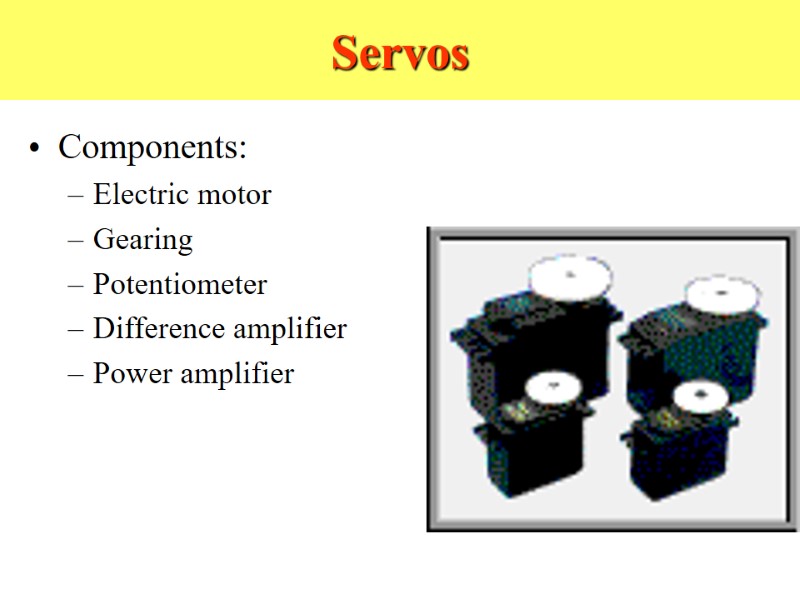
Servos Components: Electric motor Gearing Potentiometer Difference amplifier Power amplifier
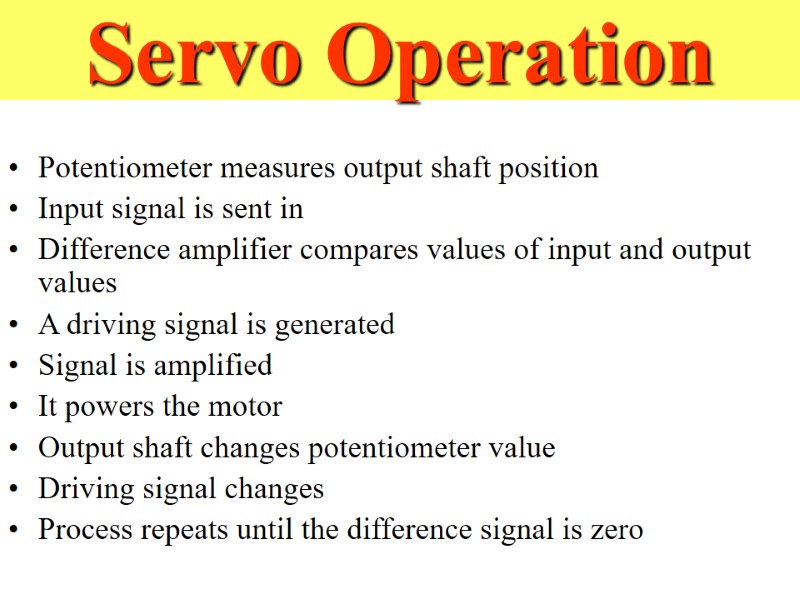
Servo Operation Potentiometer measures output shaft position Input signal is sent in Difference amplifier compares values of input and output values A driving signal is generated Signal is amplified It powers the motor Output shaft changes potentiometer value Driving signal changes Process repeats until the difference signal is zero
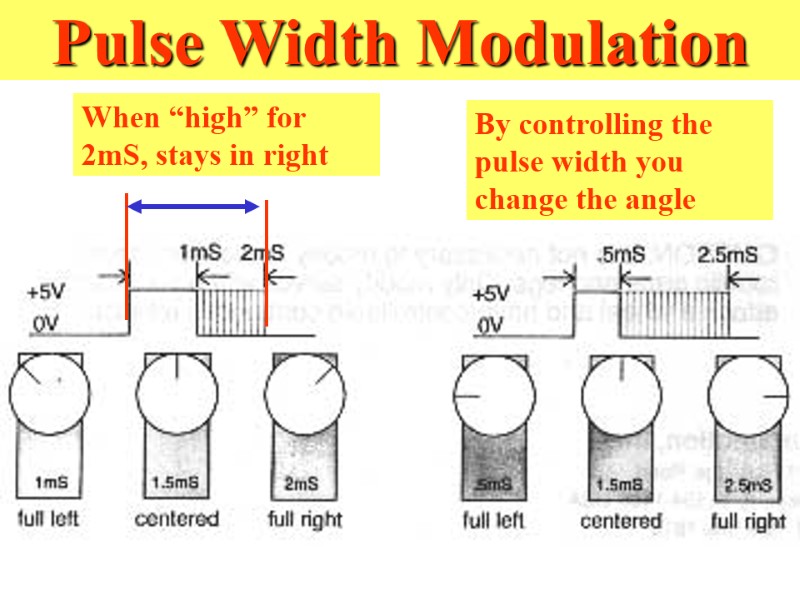
Pulse Width Modulation When “high” for 2mS, stays in right By controlling the pulse width you change the angle

Notable Features Variable speed Input signal is pulse width modulation Pulses ranging from 1 to 2 milliseconds long repeated 60 times a second
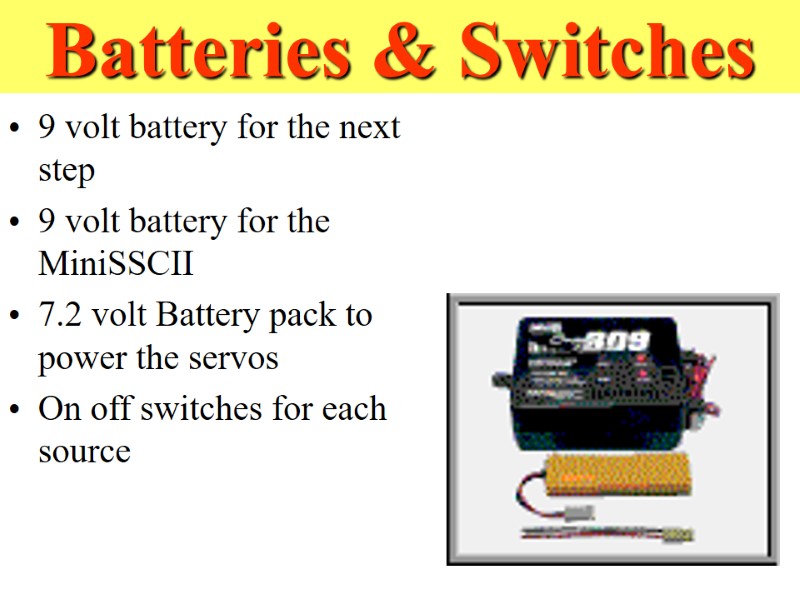
Batteries & Switches 9 volt battery for the next step 9 volt battery for the MiniSSCII 7.2 volt Battery pack to power the servos On off switches for each source
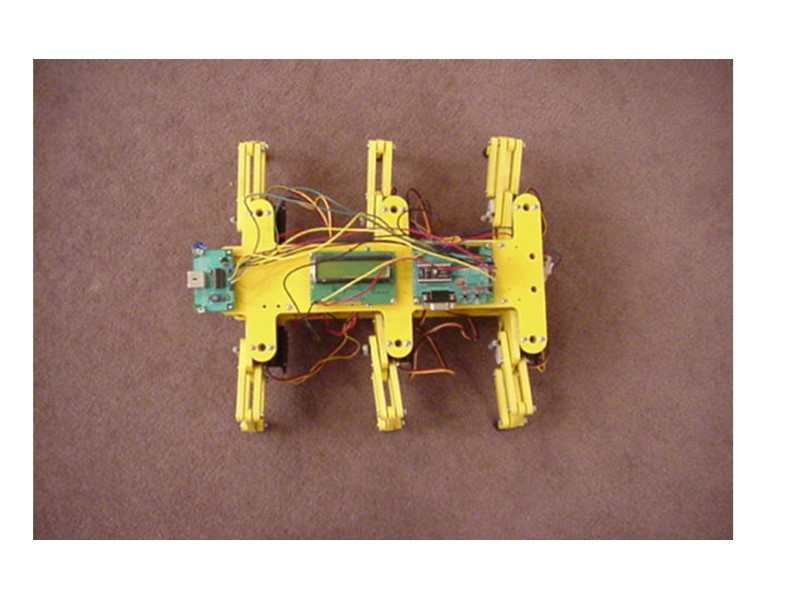
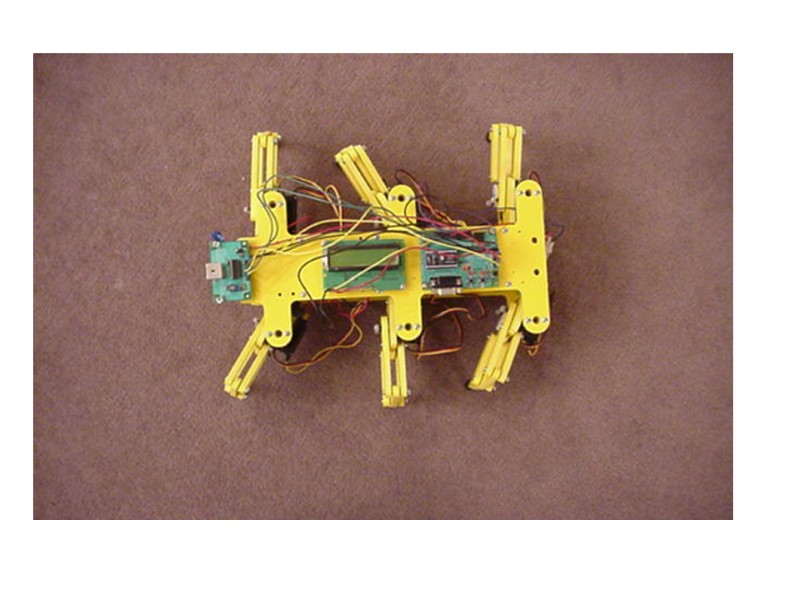
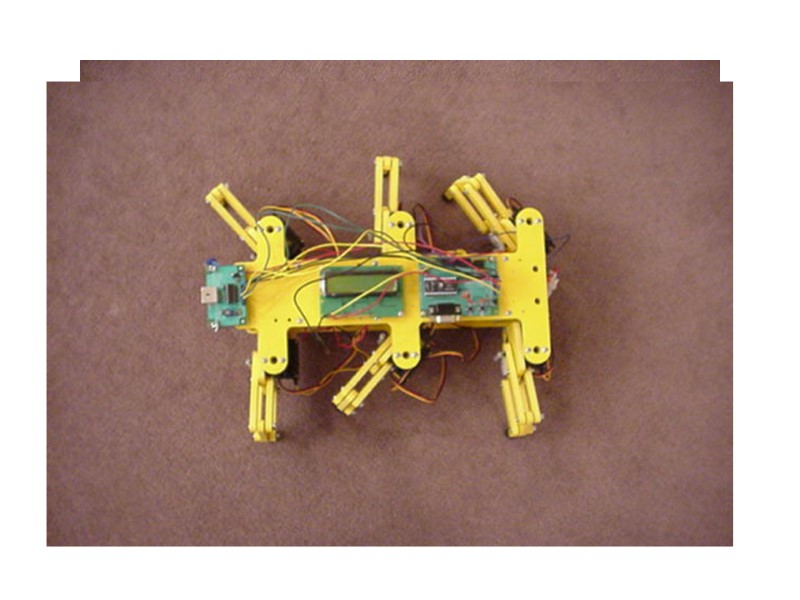
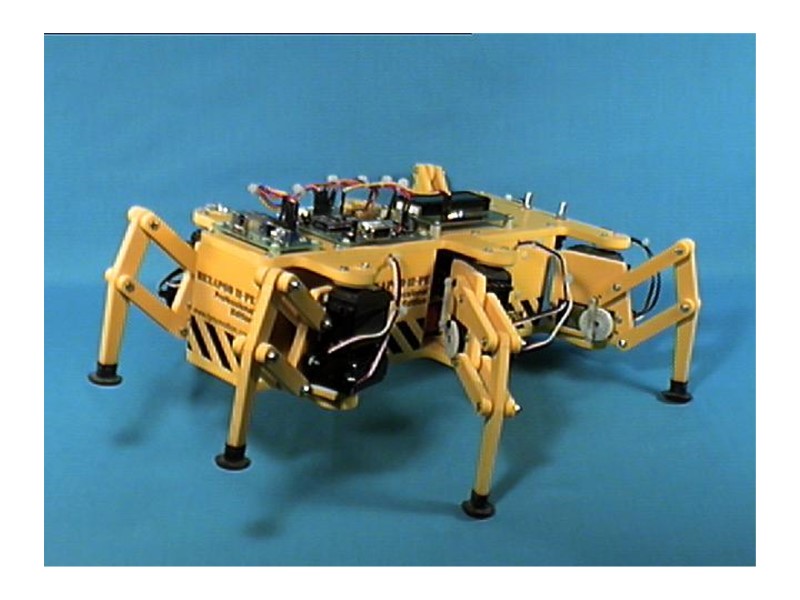

Programming PBasic programming language Syntax described in book Provided text editor Compiles on PC and downloads via serial port
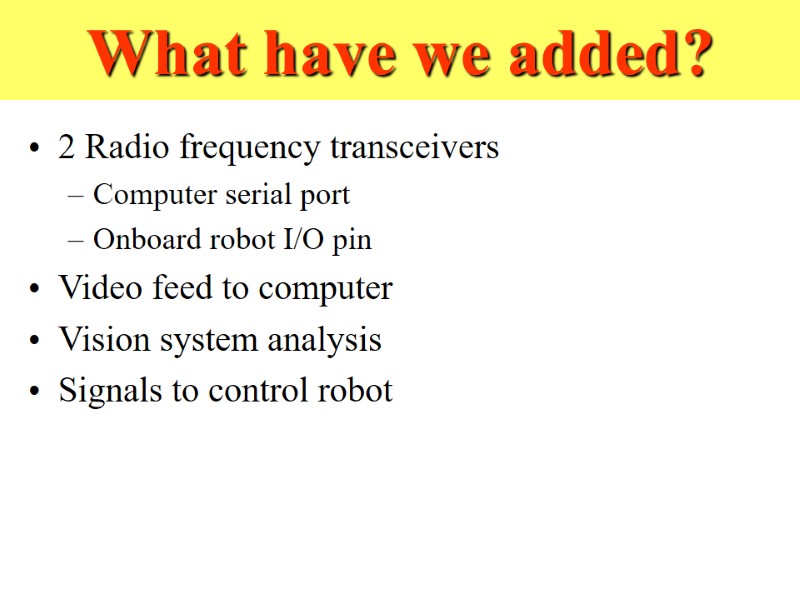
What have we added? 2 Radio frequency transceivers Computer serial port Onboard robot I/O pin Video feed to computer Vision system analysis Signals to control robot

Hexapod Kit Purchasing The Lynxmotion Hexapod II Professional Edition Combo kit Their company web page www.lynxmotion.com The Mondotronics Robot Store at www.robotstore.com Current street price: $766.35

Problems with Lynxmotion hexapods Weight Servos make the vehicle quite top heavy and may add to instability. Is there a way of replacing servo with muscle? Turns How? Sensing There ain’t any! What happens on uneven ground? Speed – Unstable at higher speeds

RHex Other Hexapods
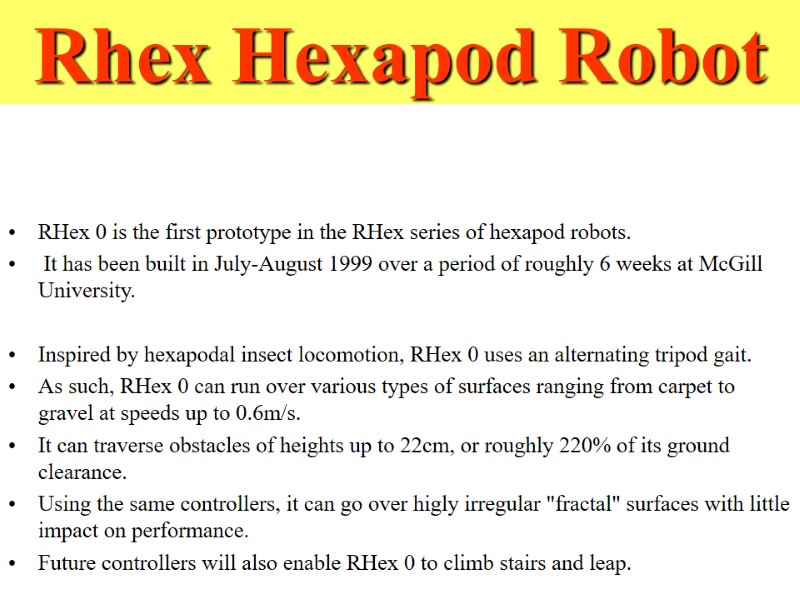
RHex 0 is the first prototype in the RHex series of hexapod robots. It has been built in July-August 1999 over a period of roughly 6 weeks at McGill University. Inspired by hexapodal insect locomotion, RHex 0 uses an alternating tripod gait. As such, RHex 0 can run over various types of surfaces ranging from carpet to gravel at speeds up to 0.6m/s. It can traverse obstacles of heights up to 22cm, or roughly 220% of its ground clearance. Using the same controllers, it can go over higly irregular "fractal" surfaces with little impact on performance. Future controllers will also enable RHex 0 to climb stairs and leap. Rhex Hexapod Robot
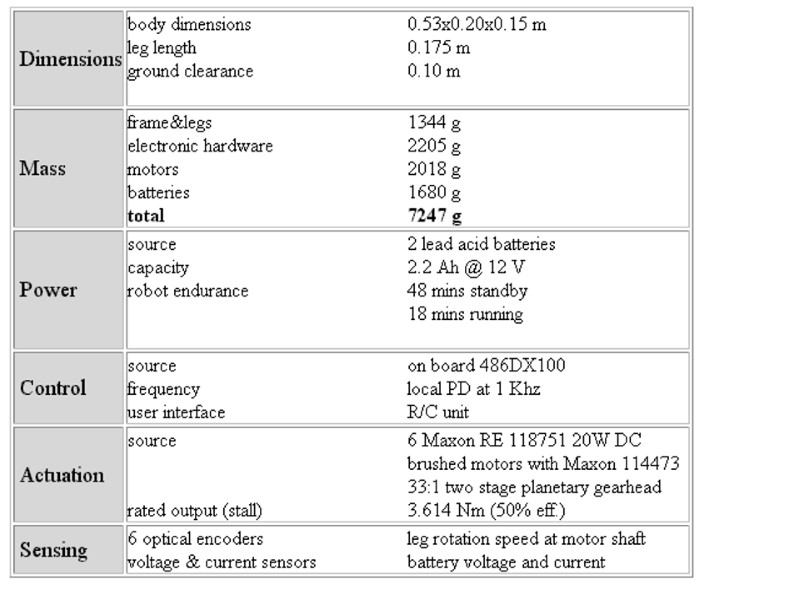
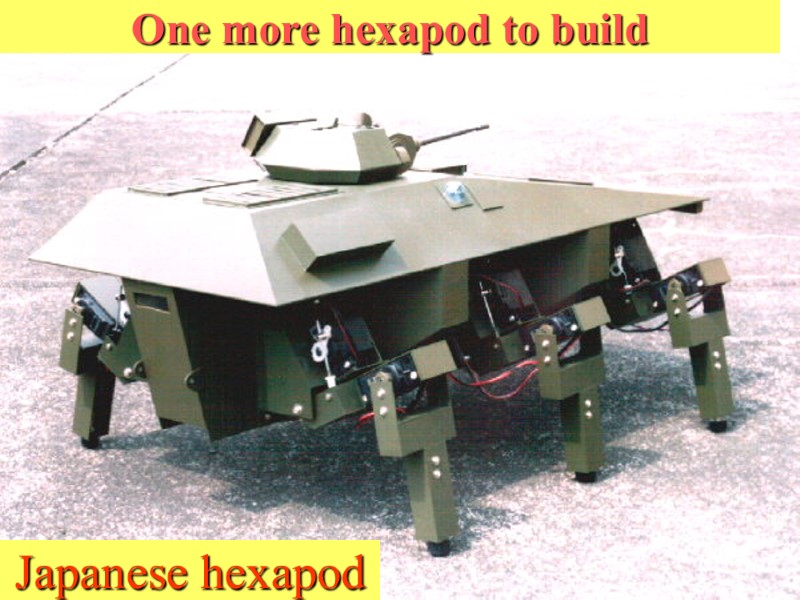
One more hexapod to build Japanese hexapod
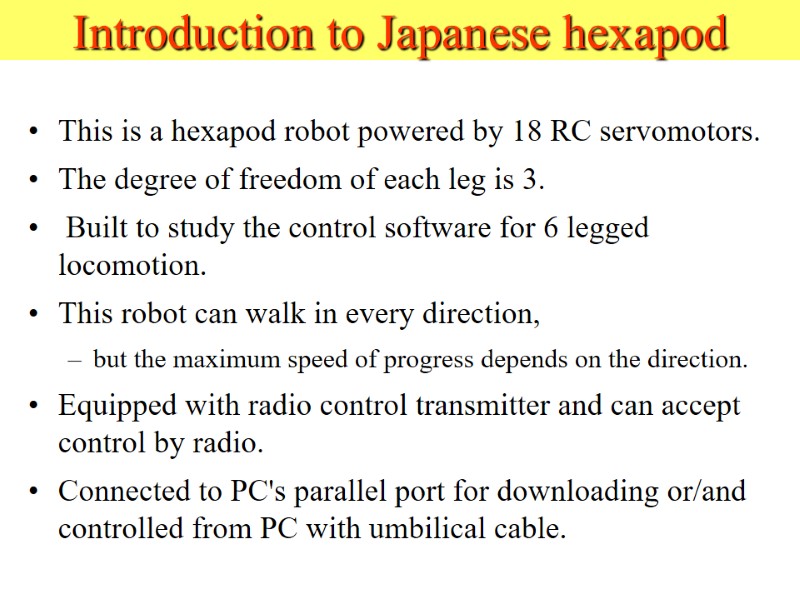
Introduction to Japanese hexapod This is a hexapod robot powered by 18 RC servomotors. The degree of freedom of each leg is 3. Built to study the control software for 6 legged locomotion. This robot can walk in every direction, but the maximum speed of progress depends on the direction. Equipped with radio control transmitter and can accept control by radio. Connected to PC's parallel port for downloading or/and controlled from PC with umbilical cable.
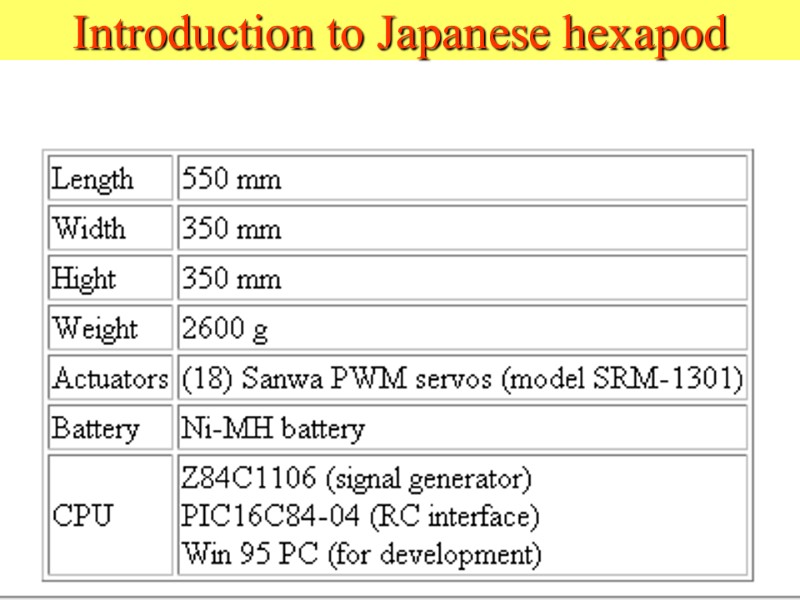
Introduction to Japanese hexapod

Mechanical Structure and Arrangement The robot consists of 3 major parts: 1. "The Cover", 2. "The Frame", 3. "The Leg-unit". Built to have enough strength and reduce the weight. Introduction to Japanese hexapod
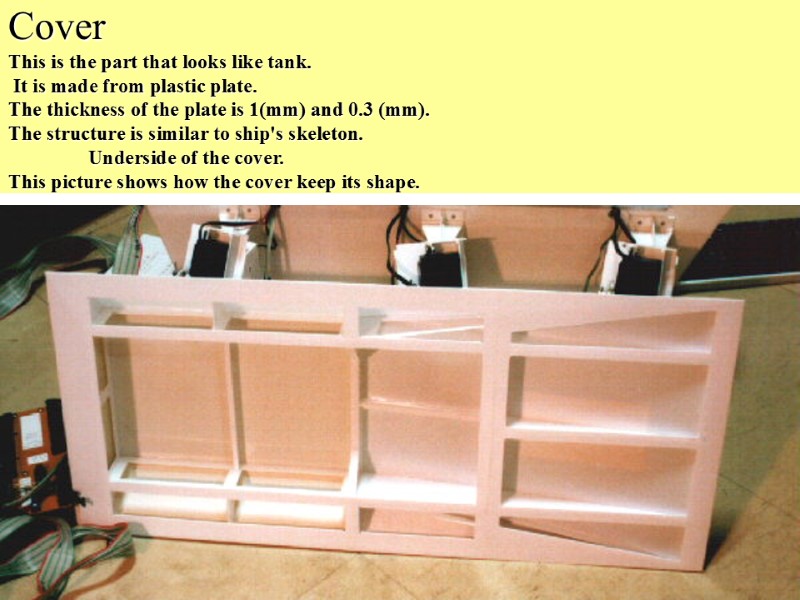
Cover This is the part that looks like tank. It is made from plastic plate. The thickness of the plate is 1(mm) and 0.3 (mm). The structure is similar to ship's skeleton. Underside of the cover. This picture shows how the cover keep its shape.
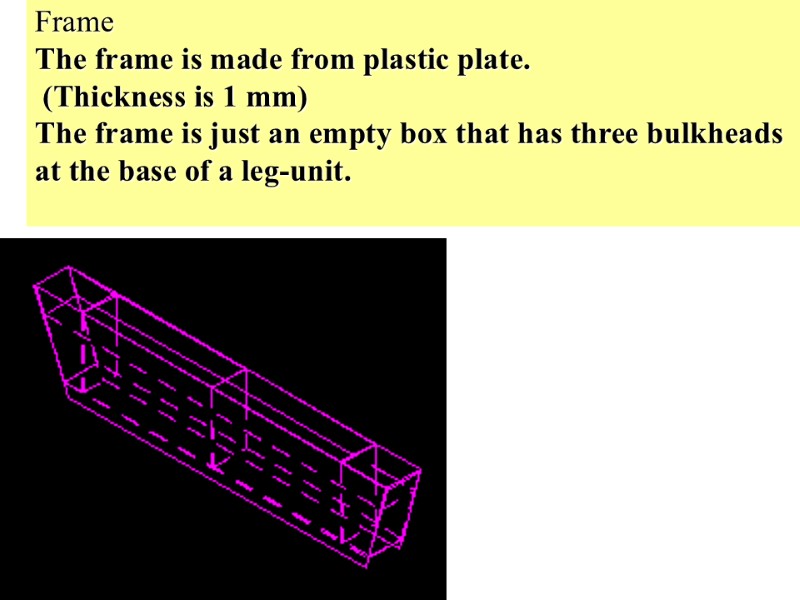
Frame The frame is made from plastic plate. (Thickness is 1 mm) The frame is just an empty box that has three bulkheads at the base of a leg-unit.
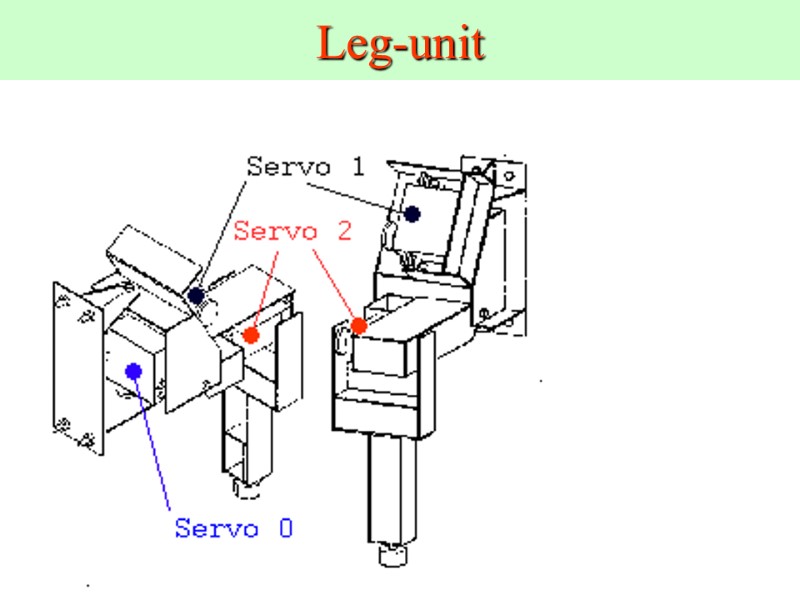
Leg-unit
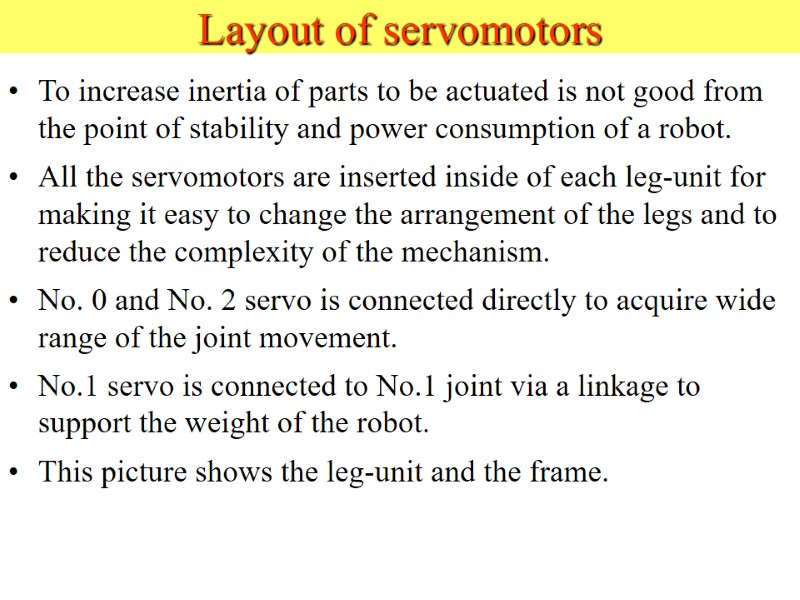
Layout of servomotors To increase inertia of parts to be actuated is not good from the point of stability and power consumption of a robot. All the servomotors are inserted inside of each leg-unit for making it easy to change the arrangement of the legs and to reduce the complexity of the mechanism. No. 0 and No. 2 servo is connected directly to acquire wide range of the joint movement. No.1 servo is connected to No.1 joint via a linkage to support the weight of the robot. This picture shows the leg-unit and the frame.
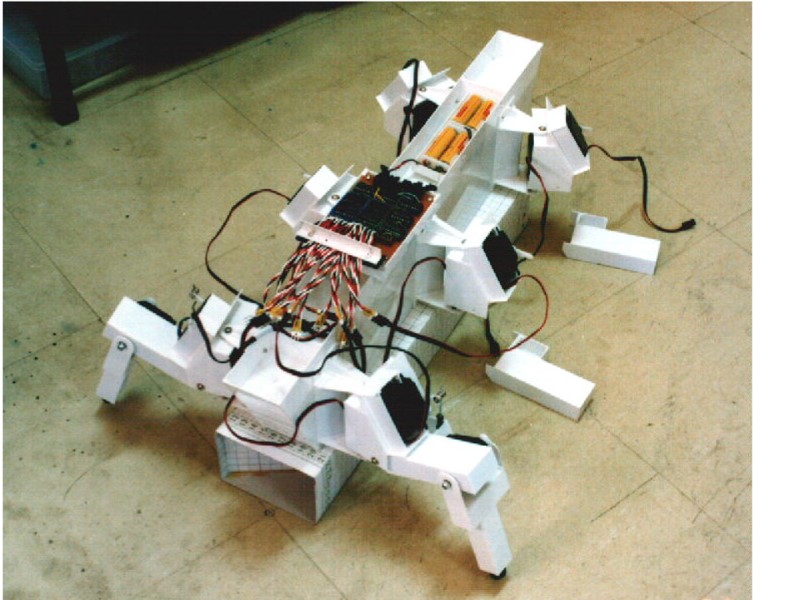
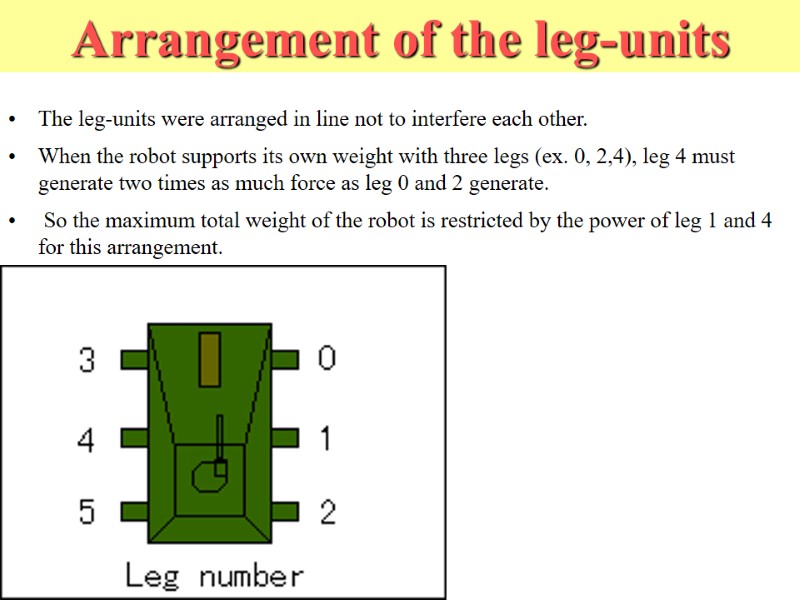
The leg-units were arranged in line not to interfere each other. When the robot supports its own weight with three legs (ex. 0, 2,4), leg 4 must generate two times as much force as leg 0 and 2 generate. So the maximum total weight of the robot is restricted by the power of leg 1 and 4 for this arrangement. Arrangement of the leg-units
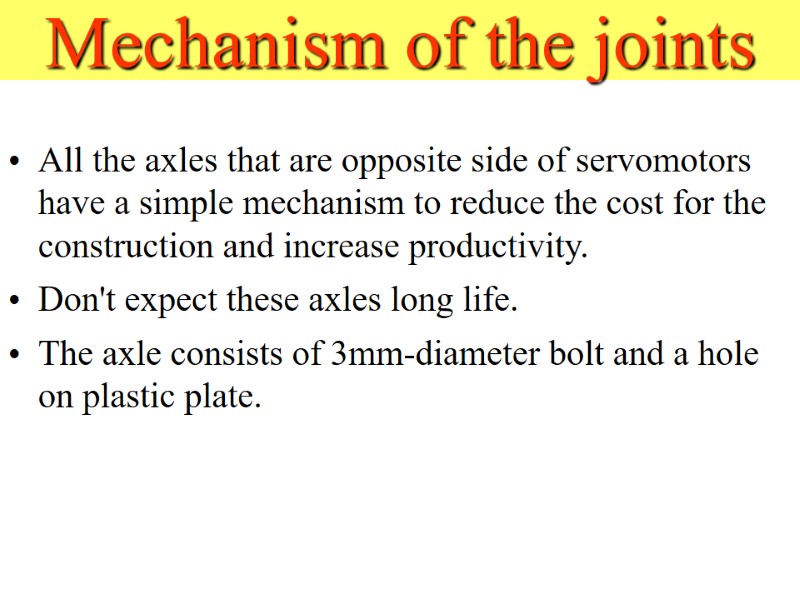
All the axles that are opposite side of servomotors have a simple mechanism to reduce the cost for the construction and increase productivity. Don't expect these axles long life. The axle consists of 3mm-diameter bolt and a hole on plastic plate. Mechanism of the joints
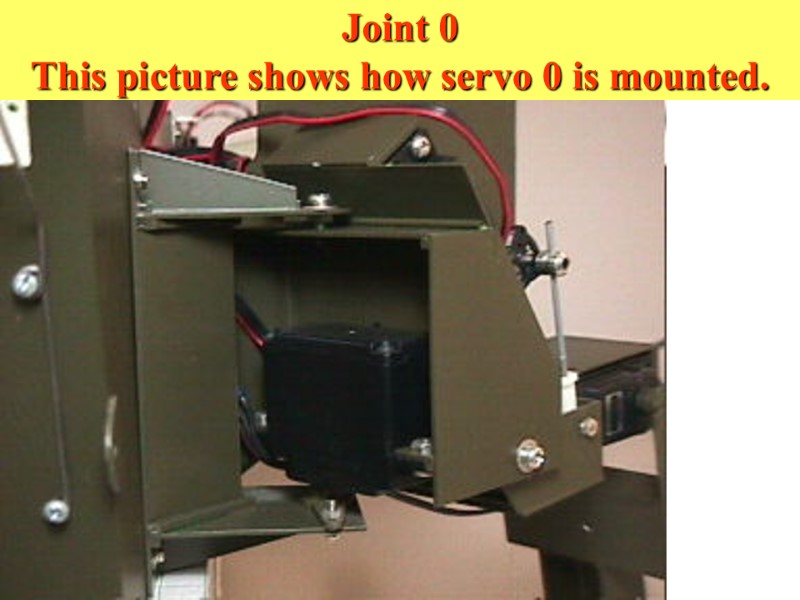
Joint 0 This picture shows how servo 0 is mounted.
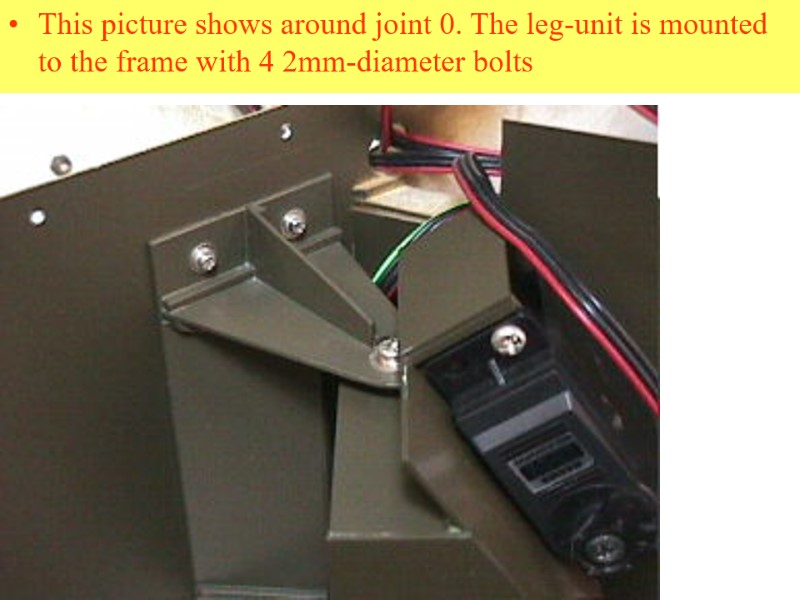
This picture shows around joint 0. The leg-unit is mounted to the frame with 4 2mm-diameter bolts
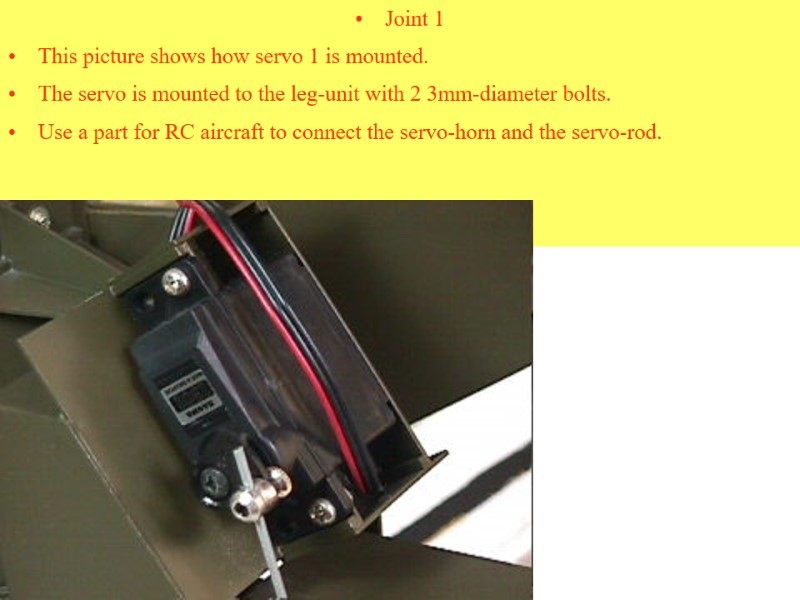
Joint 1 This picture shows how servo 1 is mounted. The servo is mounted to the leg-unit with 2 3mm-diameter bolts. Use a part for RC aircraft to connect the servo-horn and the servo-rod.
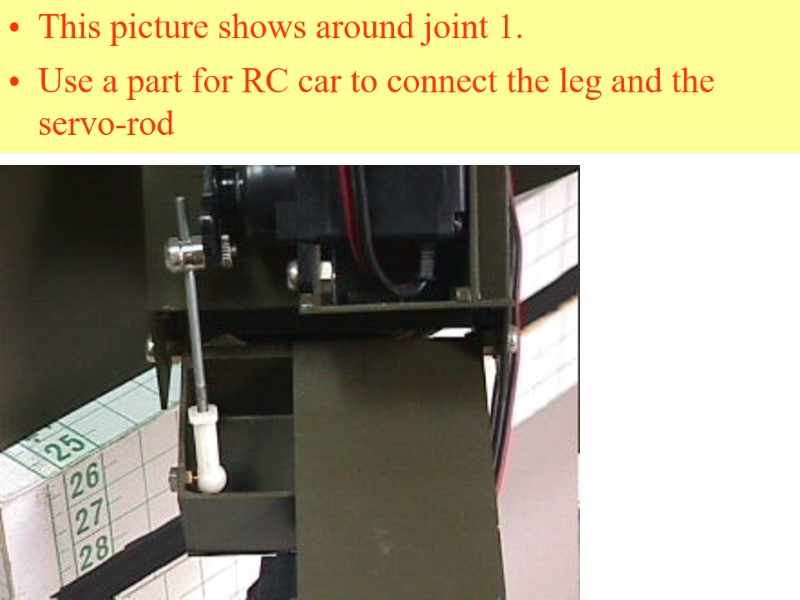
This picture shows around joint 1. Use a part for RC car to connect the leg and the servo-rod
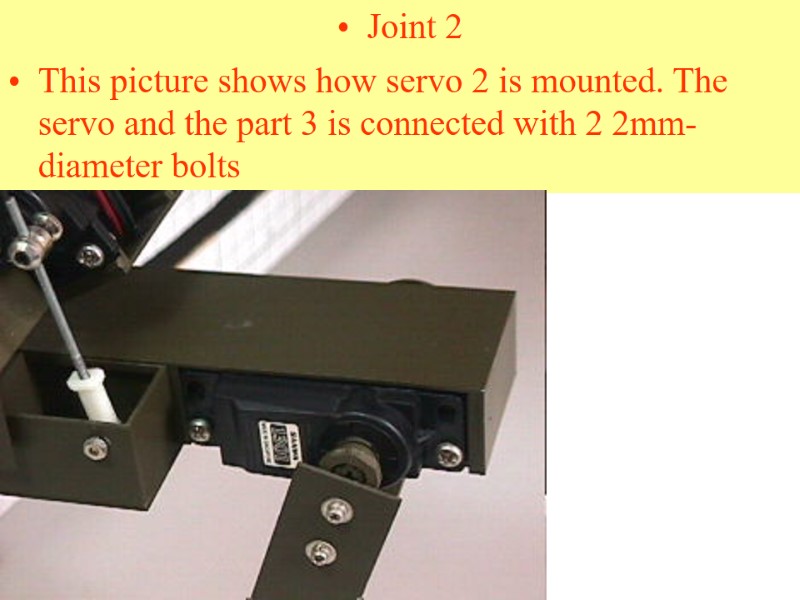
Joint 2 This picture shows how servo 2 is mounted. The servo and the part 3 is connected with 2 2mm-diameter bolts
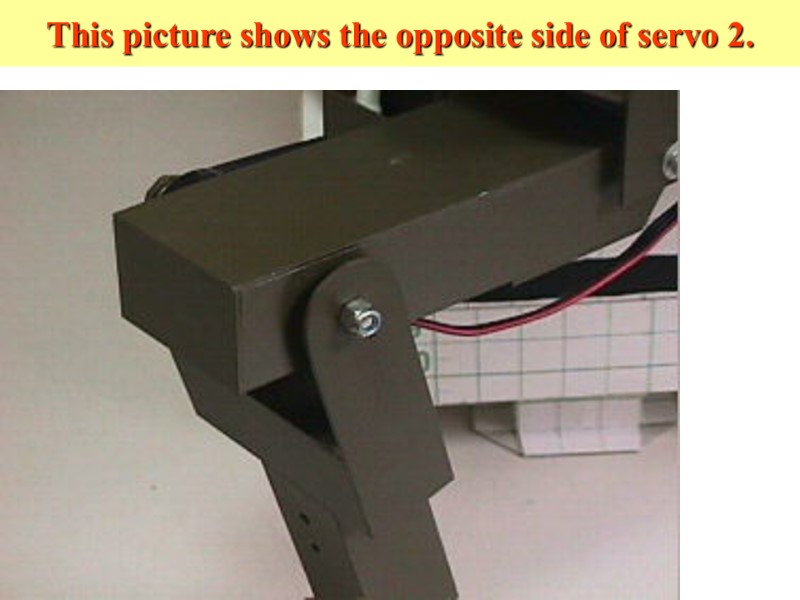
This picture shows the opposite side of servo 2.
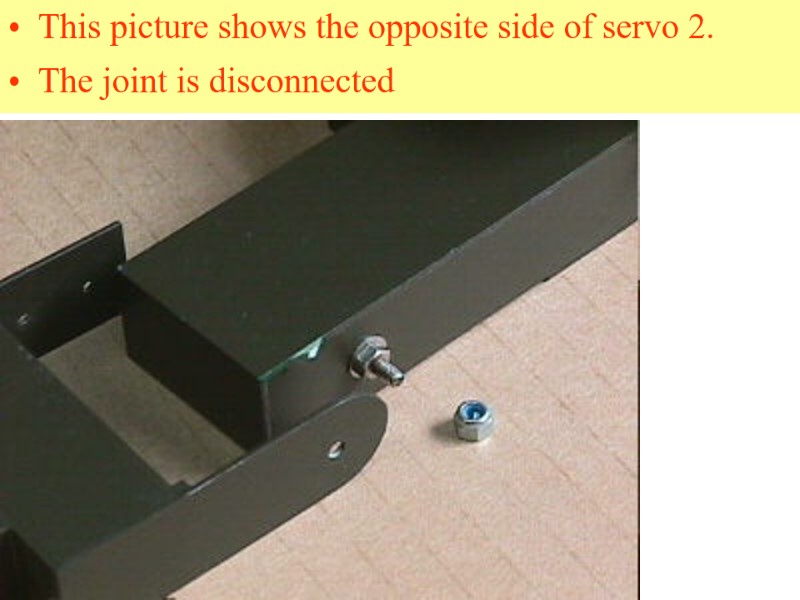
This picture shows the opposite side of servo 2. The joint is disconnected
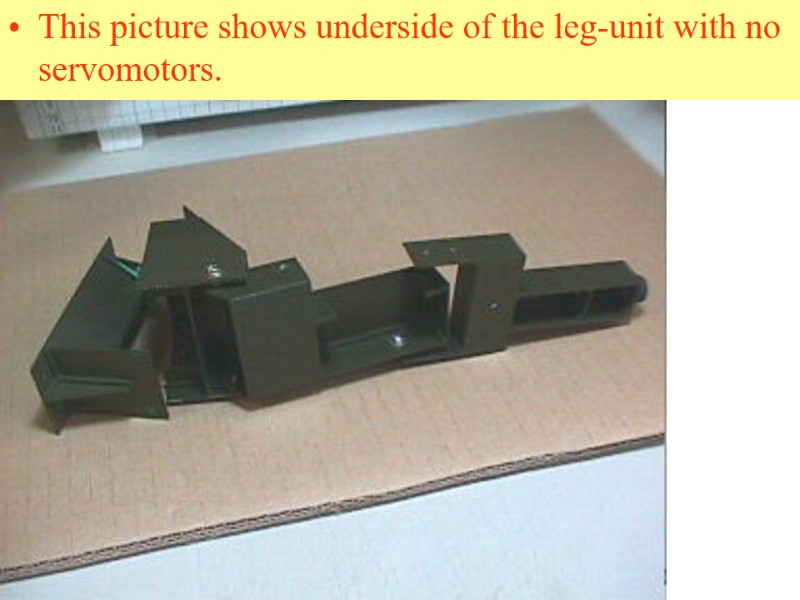
This picture shows underside of the leg-unit with no servomotors.
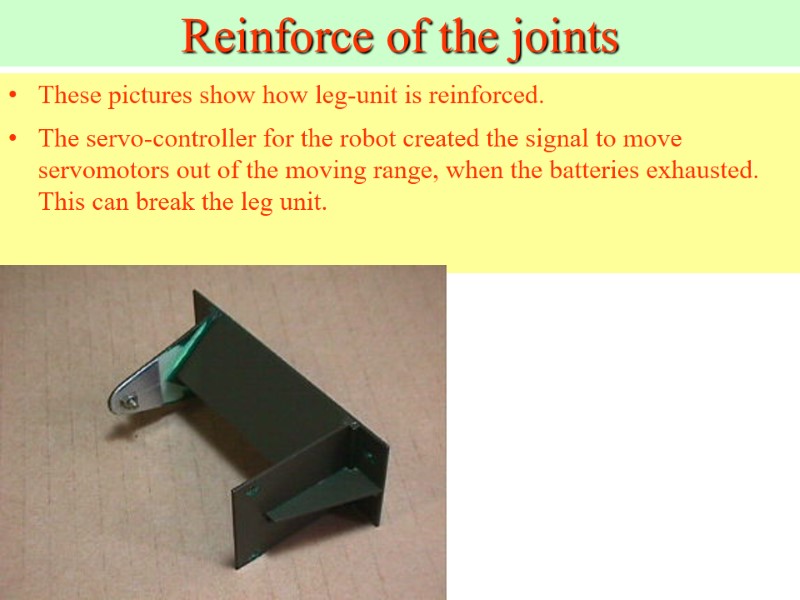
Reinforce of the joints These pictures show how leg-unit is reinforced. The servo-controller for the robot created the signal to move servomotors out of the moving range, when the batteries exhausted. This can break the leg unit.
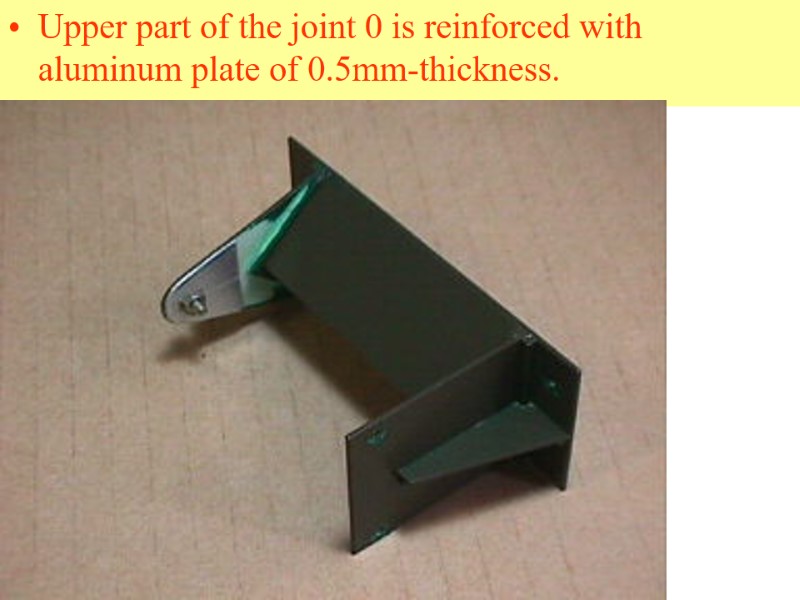
Upper part of the joint 0 is reinforced with aluminum plate of 0.5mm-thickness.
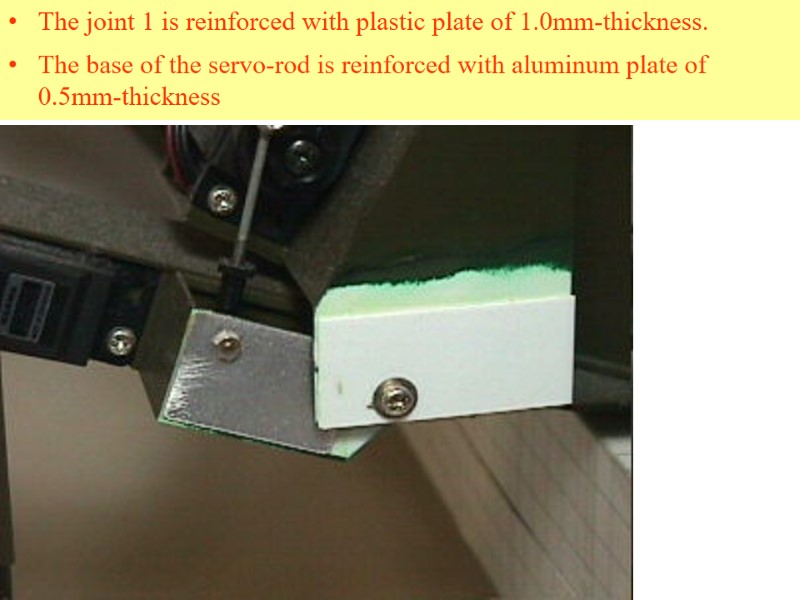
The joint 1 is reinforced with plastic plate of 1.0mm-thickness. The base of the servo-rod is reinforced with aluminum plate of 0.5mm-thickness
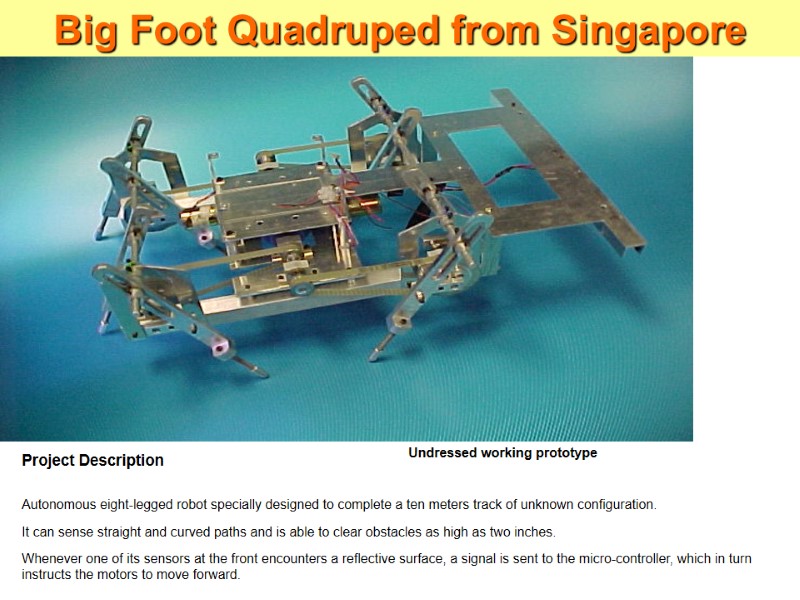
Project Description Autonomous eight-legged robot specially designed to complete a ten meters track of unknown configuration. It can sense straight and curved paths and is able to clear obstacles as high as two inches. Whenever one of its sensors at the front encounters a reflective surface, a signal is sent to the micro-controller, which in turn instructs the motors to move forward. Undressed working prototype Big Foot Quadruped from Singapore
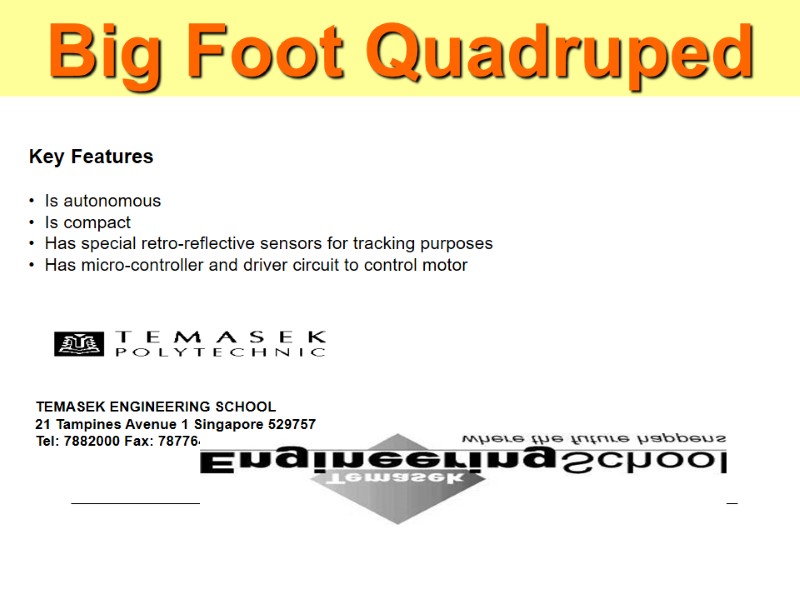
Key Features Is autonomous Is compact Has special retro-reflective sensors for tracking purposes Has micro-controller and driver circuit to control motor TEMASEK ENGINEERING SCHOOL 21 Tampines Avenue 1 Singapore 529757 Tel: 7882000 Fax: 7877641 Big Foot Quadruped
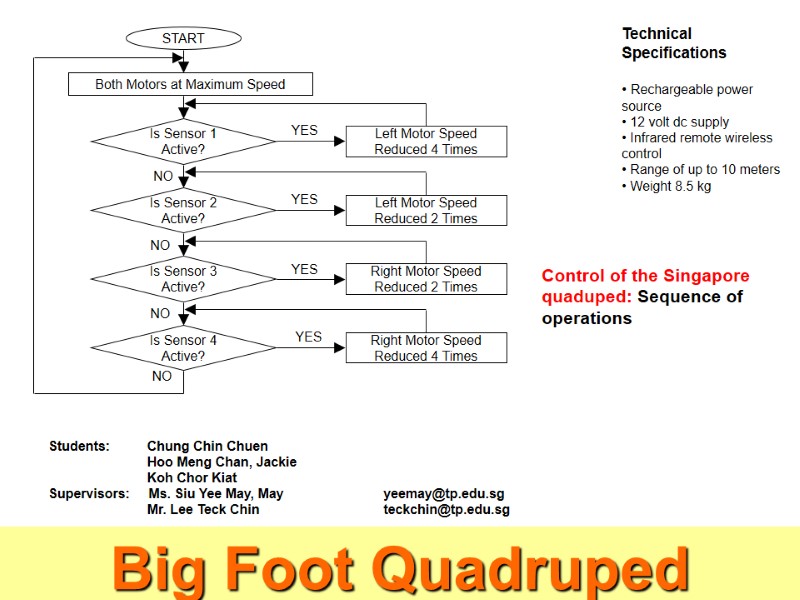
Technical Specifications Rechargeable power source 12 volt dc supply Infrared remote wireless control Range of up to 10 meters Weight 8.5 kg Control of the Singapore quaduped: Sequence of operations Students: Chung Chin Chuen Hoo Meng Chan, Jackie Koh Chor Kiat Supervisors: Ms. Siu Yee May, May [email protected] Mr. Lee Teck Chin [email protected] Big Foot Quadruped

Multi-legged Mobile Robot Design of the Control System Adaptation of Mekatronix Hexapod

Main Purpose
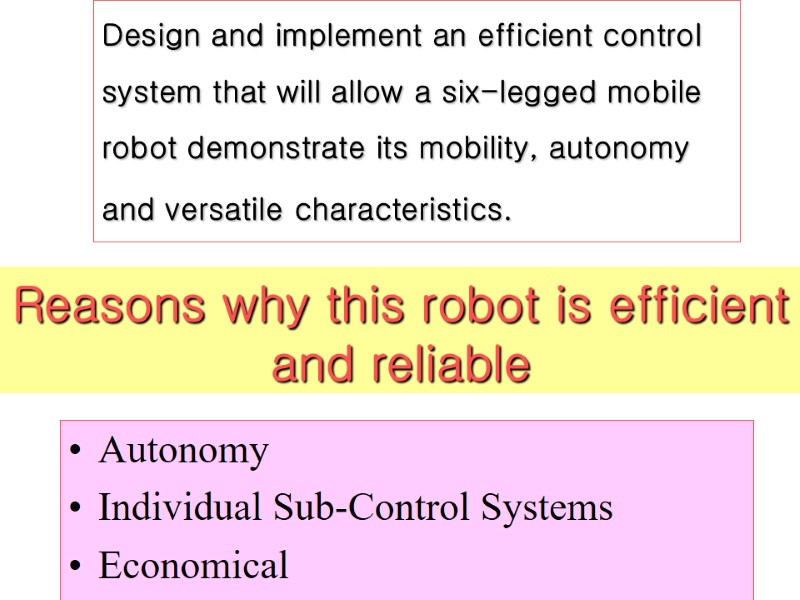
Design and implement an efficient control system that will allow a six-legged mobile robot demonstrate its mobility, autonomy and versatile characteristics. Reasons why this robot is efficient and reliable Autonomy Individual Sub-Control Systems Economical

The Robot Main Purpose
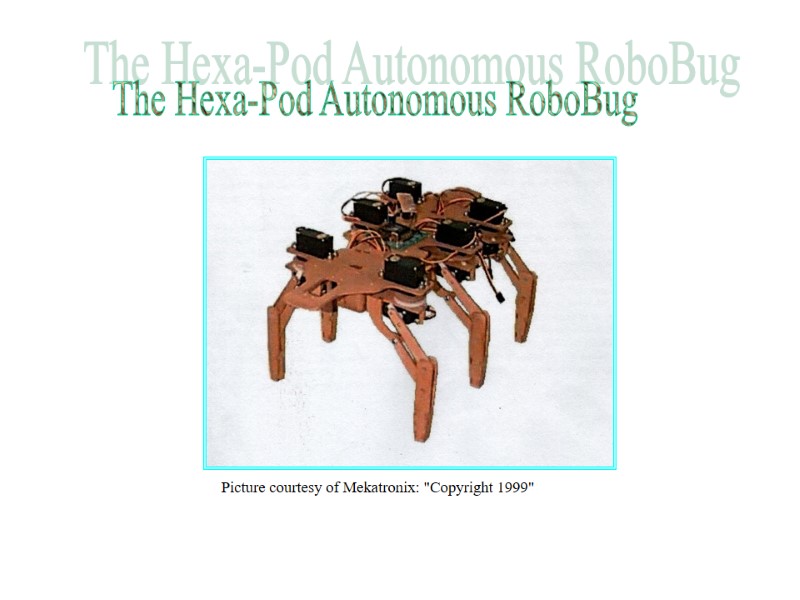
The Hexa-Pod Autonomous RoboBug Picture courtesy of Mekatronix: "Copyright 1999"
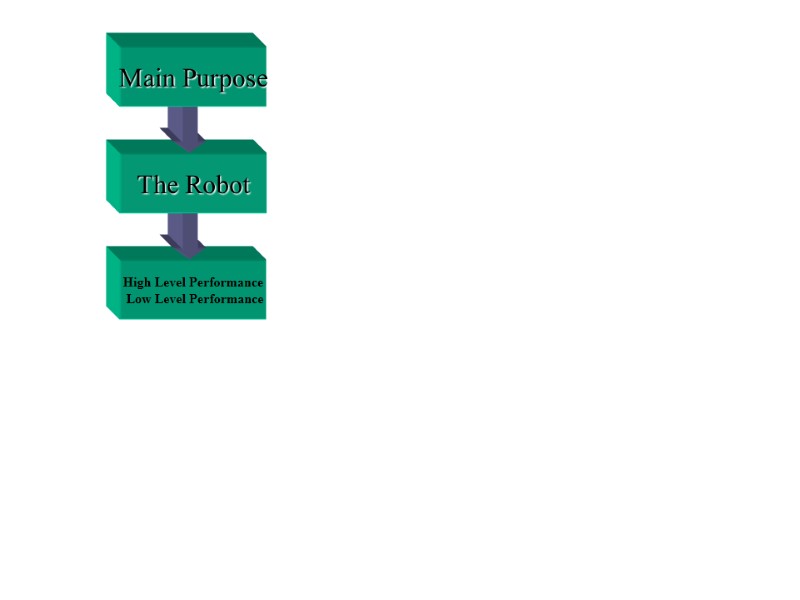
High Level Performance Low Level Performance The Robot Main Purpose
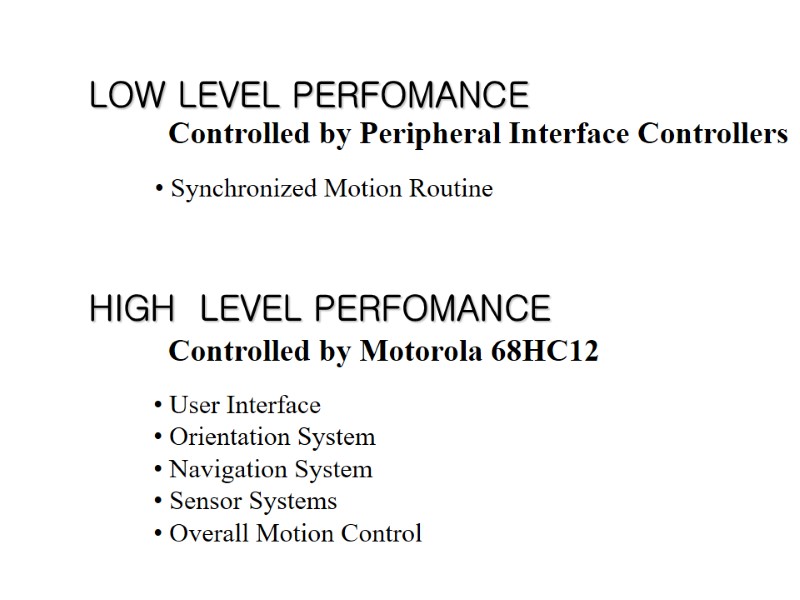
LOW LEVEL PERFOMANCE Controlled by Peripheral Interface Controllers HIGH LEVEL PERFOMANCE Controlled by Motorola 68HC12 Synchronized Motion Routine User Interface Orientation System Navigation System Sensor Systems Overall Motion Control
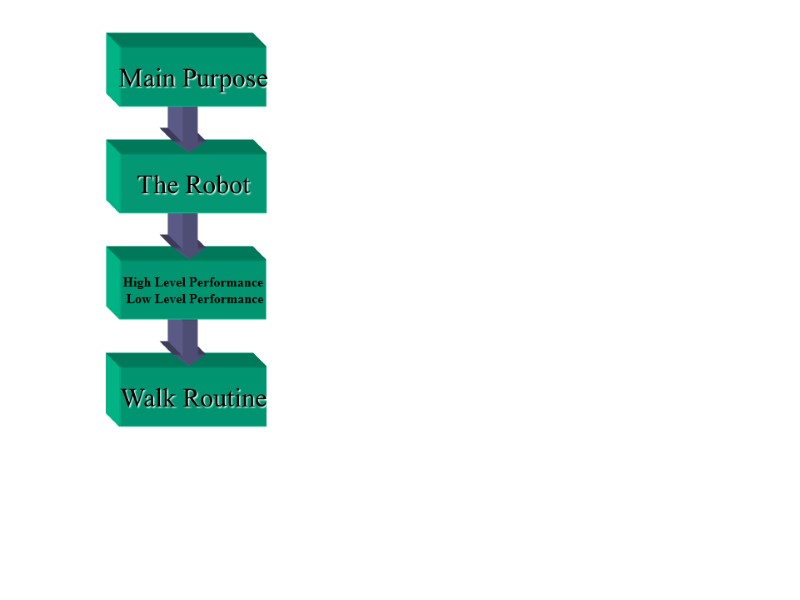
Walk Routine
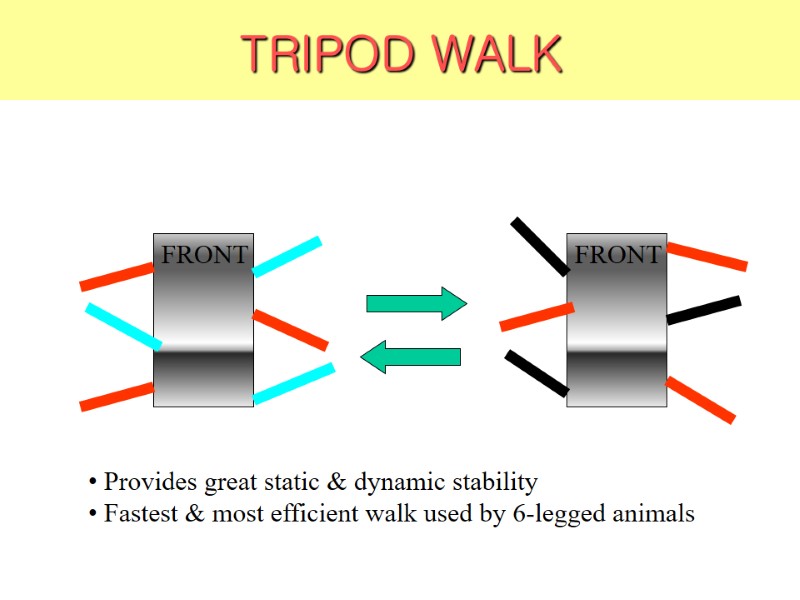
TRIPOD WALK FRONT FRONT Provides great static & dynamic stability Fastest & most efficient walk used by 6-legged animals
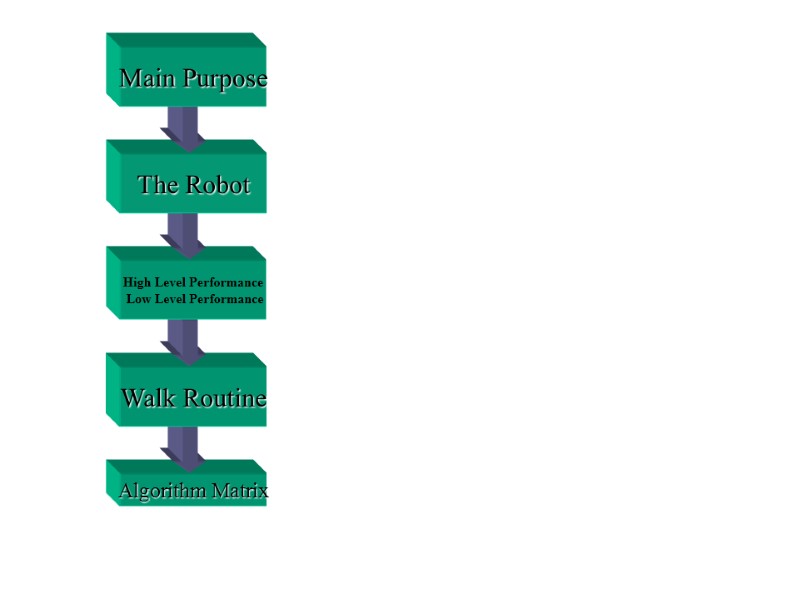
Algorithm Matrix
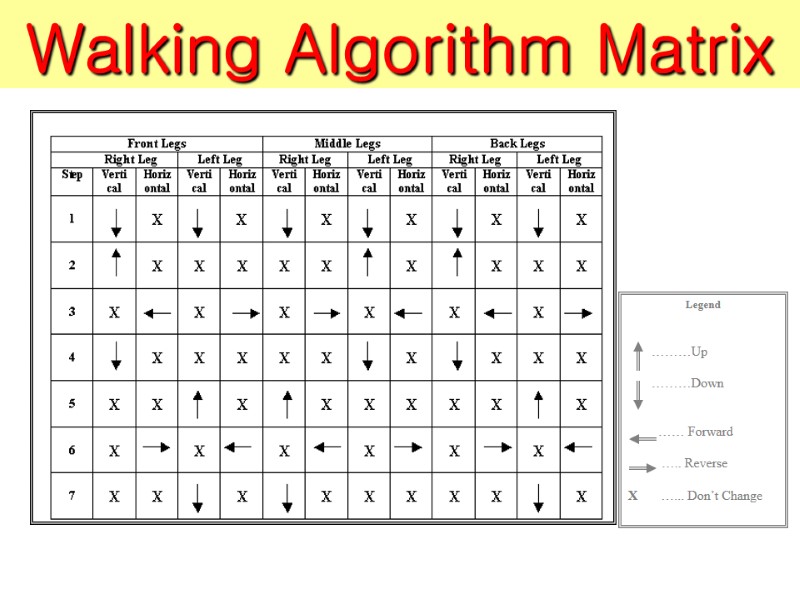
Walking Algorithm Matrix
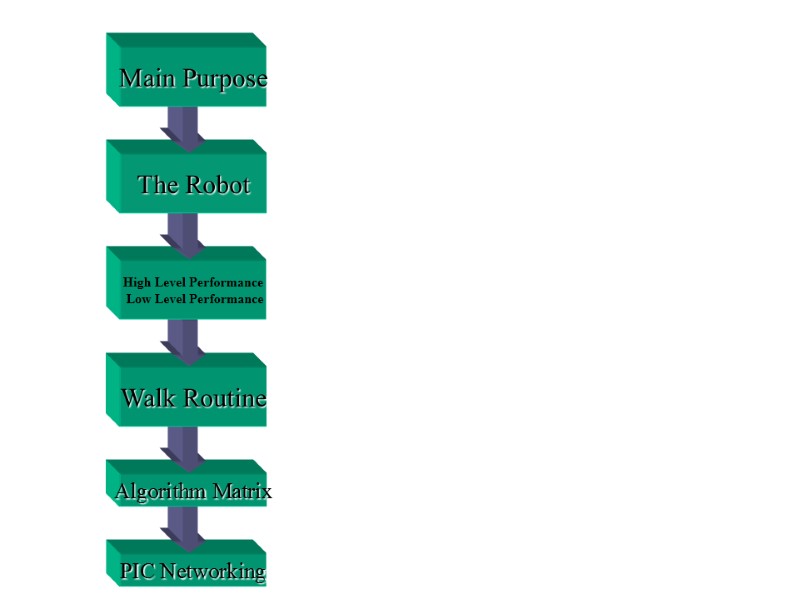
PIC Networking
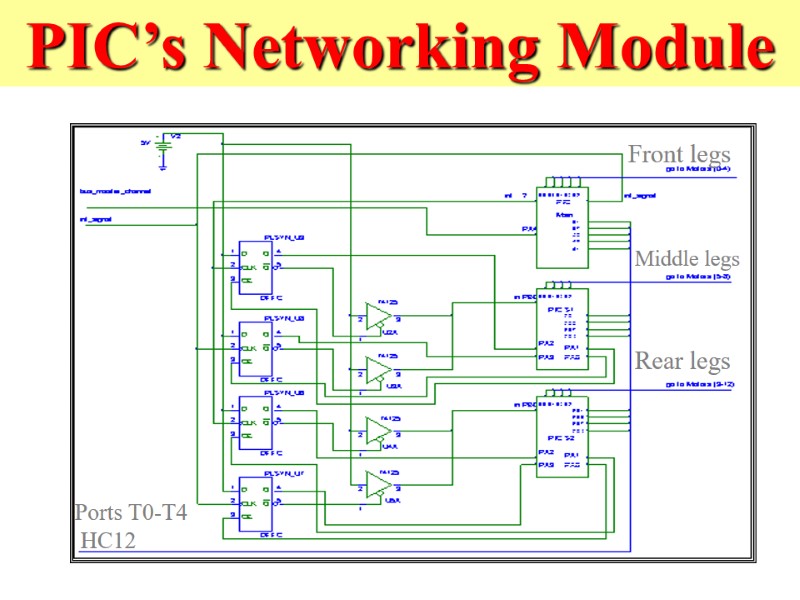
PIC’s Networking Module Front legs Middle legs Rear legs Ports T0-T4 HC12
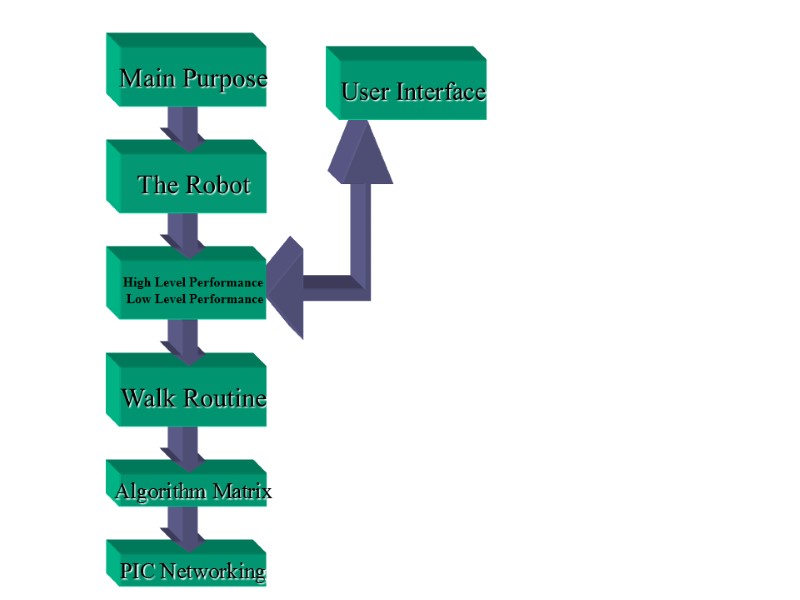
User Interface
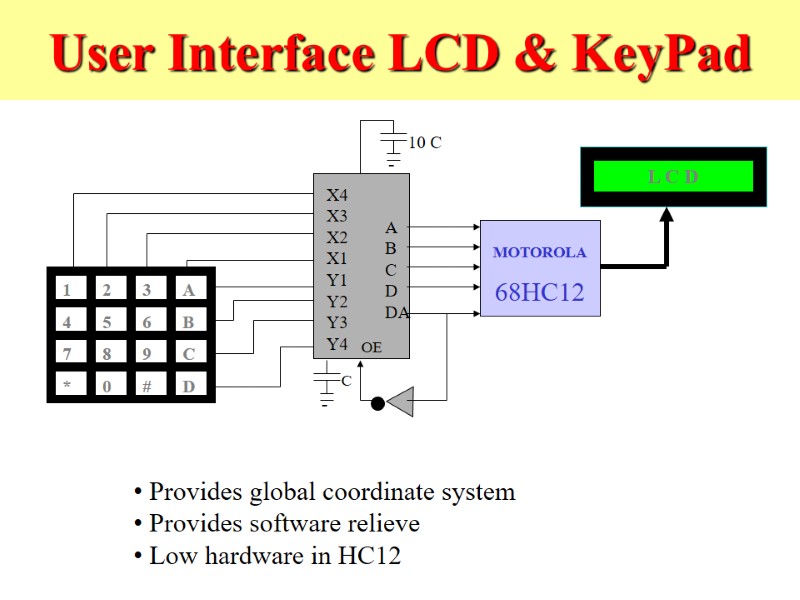
User Interface LCD & KeyPad MOTOROLA 68HC12 Provides global coordinate system Provides software relieve Low hardware in HC12 Asynchronous Data Entry Onto Bus Configuration
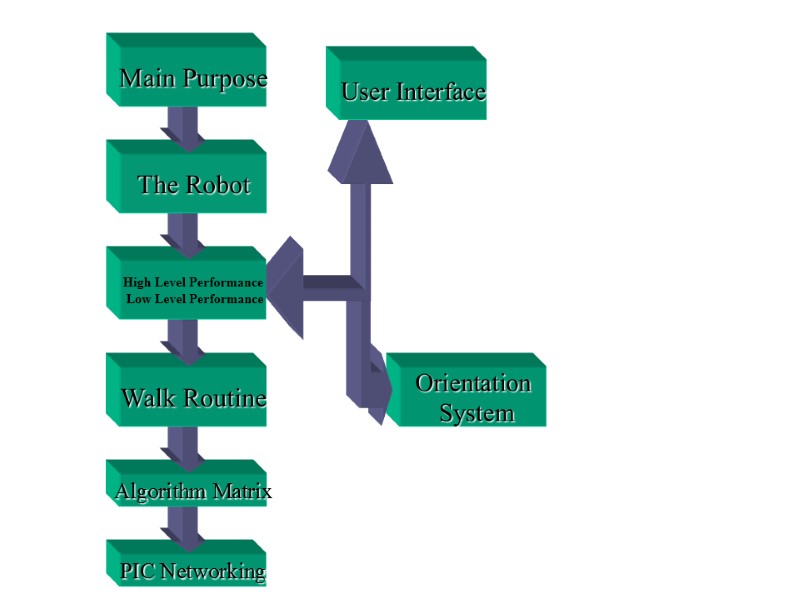
Orientation System User Interface
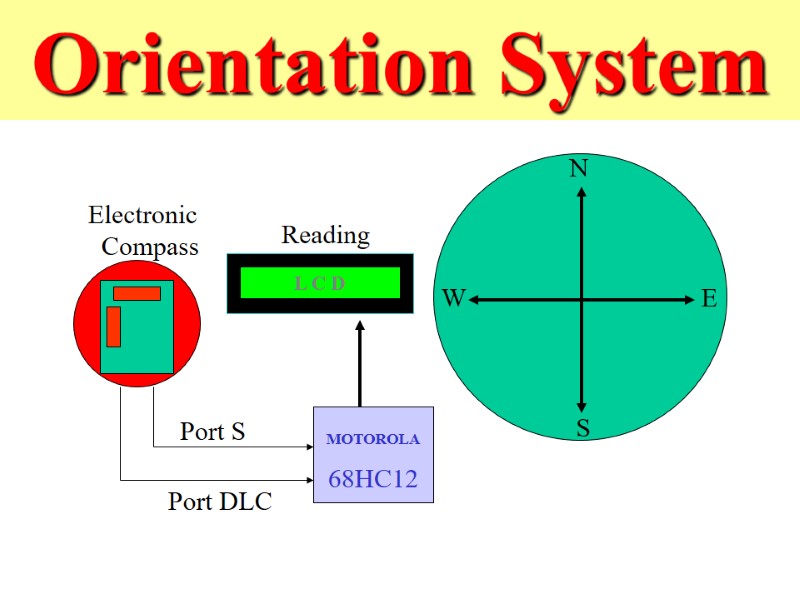
Orientation System Electronic Compass Reading
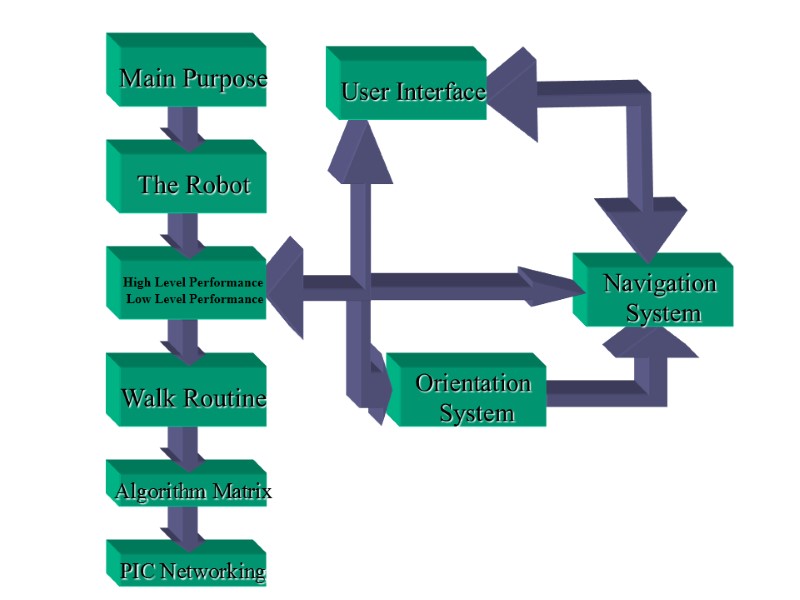
Navigation System Orientation System User Interface
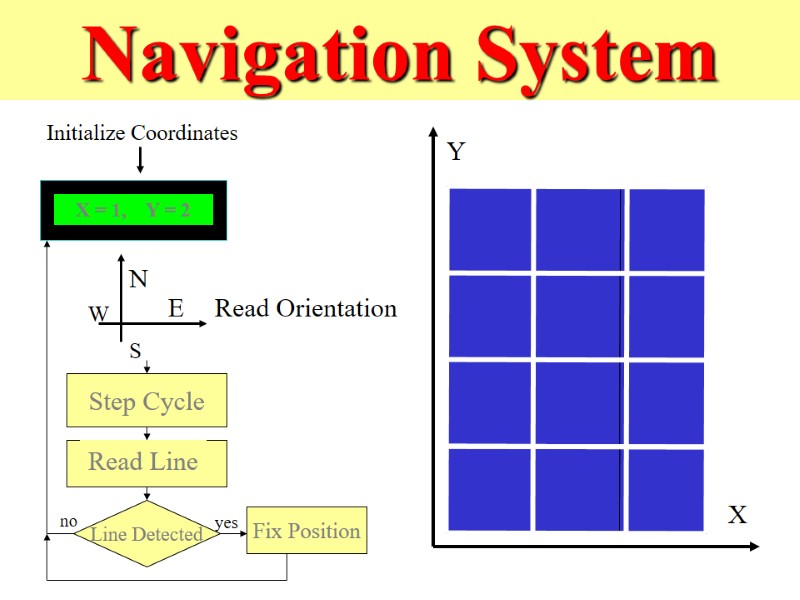
Navigation System X Y Initialize Coordinates N S E W Read Orientation Step Cycle Line Detected Fix Position no yes
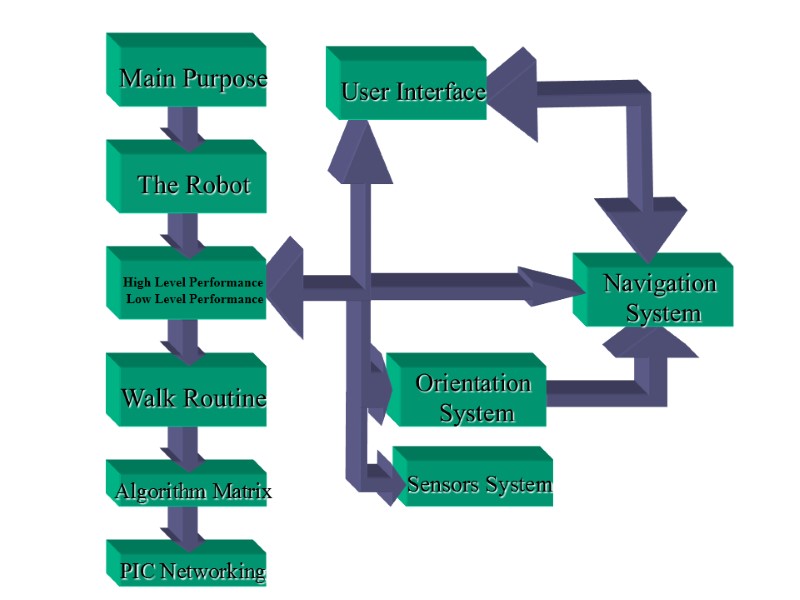
Navigation System Sensors System User Interface
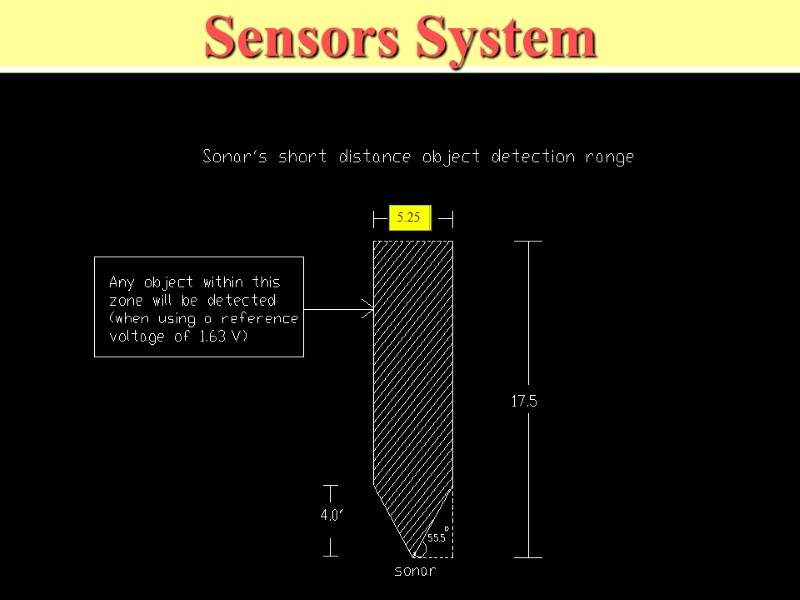
Sensors System
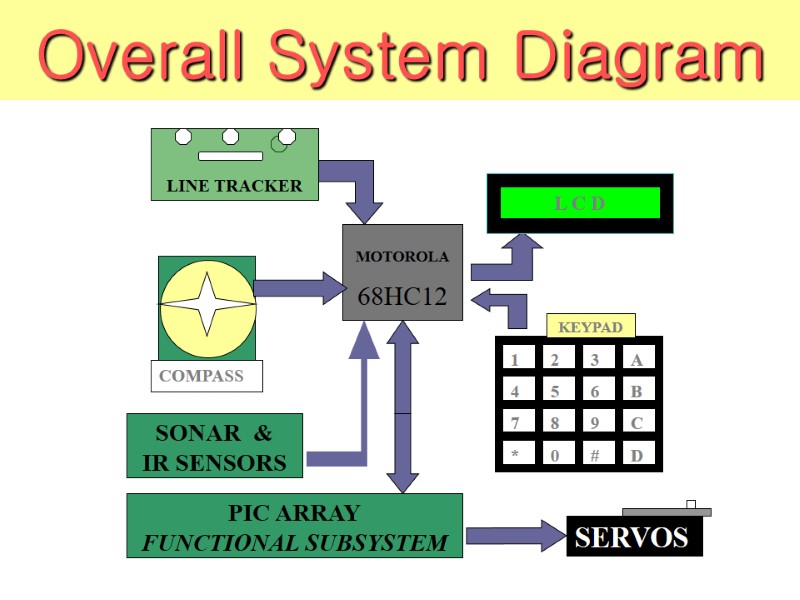
Overall System Diagram SONAR & IR SENSORS MOTOROLA 68HC12 1 2 C 3 6 9 B A 8 5 4 7 * 0 # D KEYPAD LINE TRACKER COMPASS PIC ARRAY FUNCTIONAL SUBSYSTEM

WMC Competition Overview
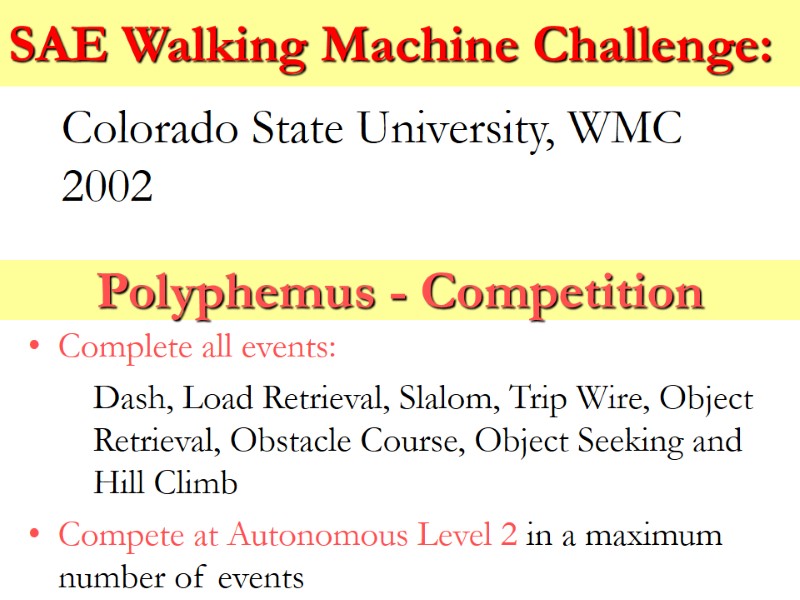
Polyphemus - Competition Complete all events: Dash, Load Retrieval, Slalom, Trip Wire, Object Retrieval, Obstacle Course, Object Seeking and Hill Climb Compete at Autonomous Level 2 in a maximum number of events SAE Walking Machine Challenge: Colorado State University, WMC 2002
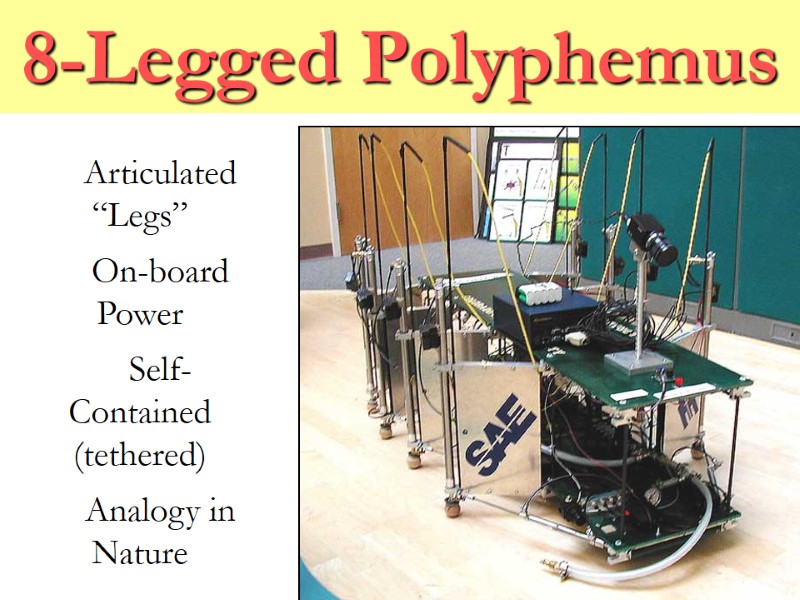
8-Legged Polyphemus Articulated “Legs” On-board Power Self-Contained (tethered) Analogy in Nature
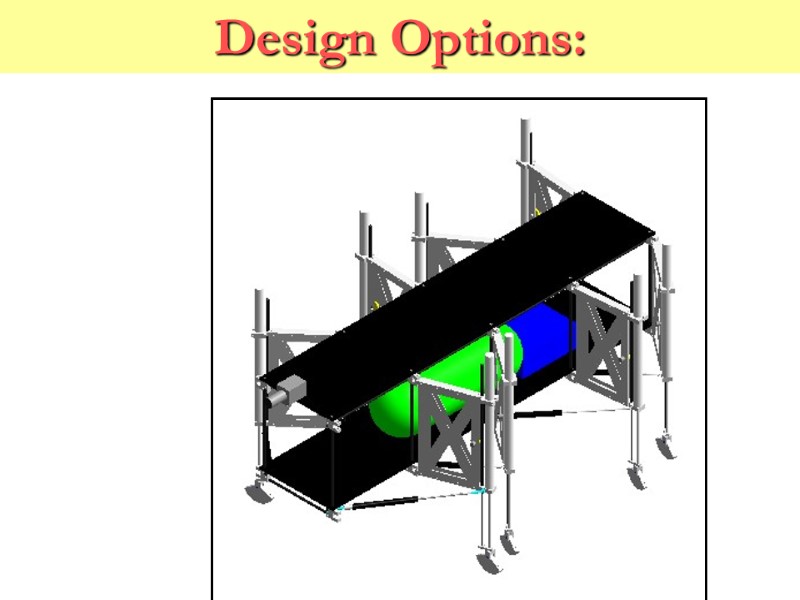
Design Options:
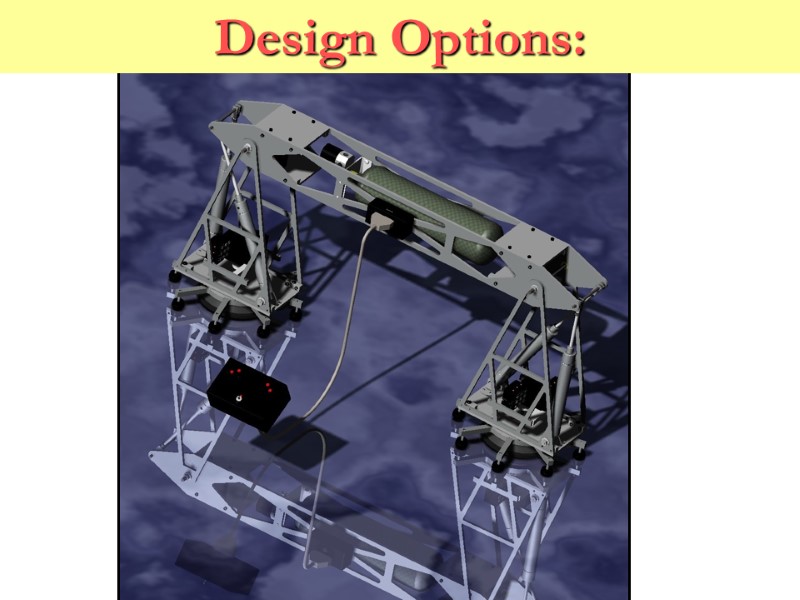
Design Options:
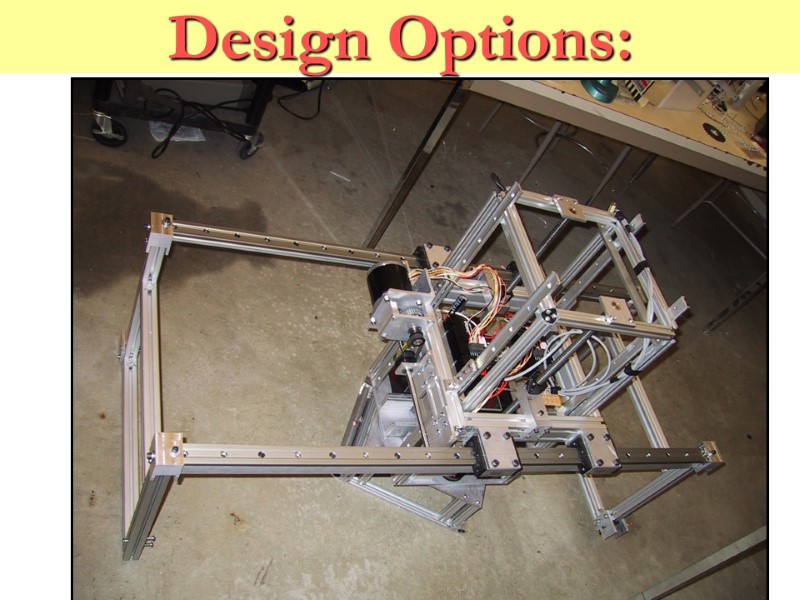
Design Options:
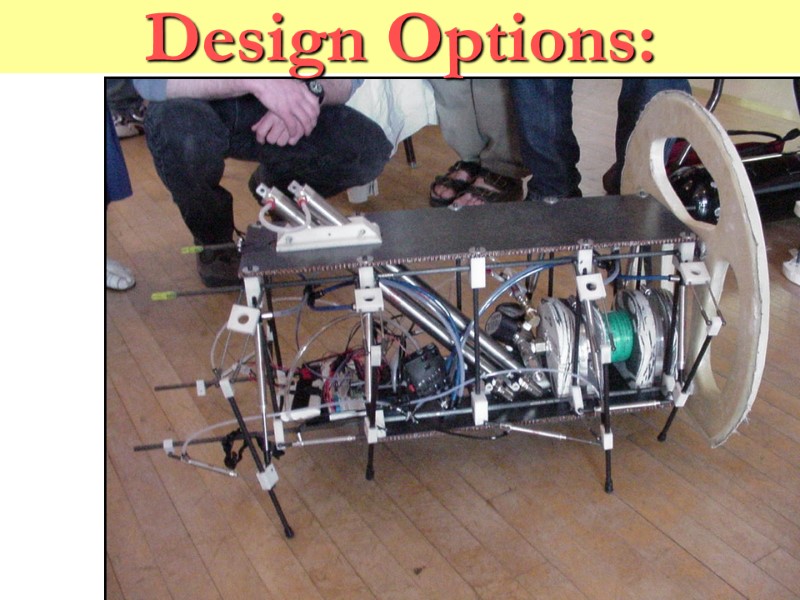
Design Options:
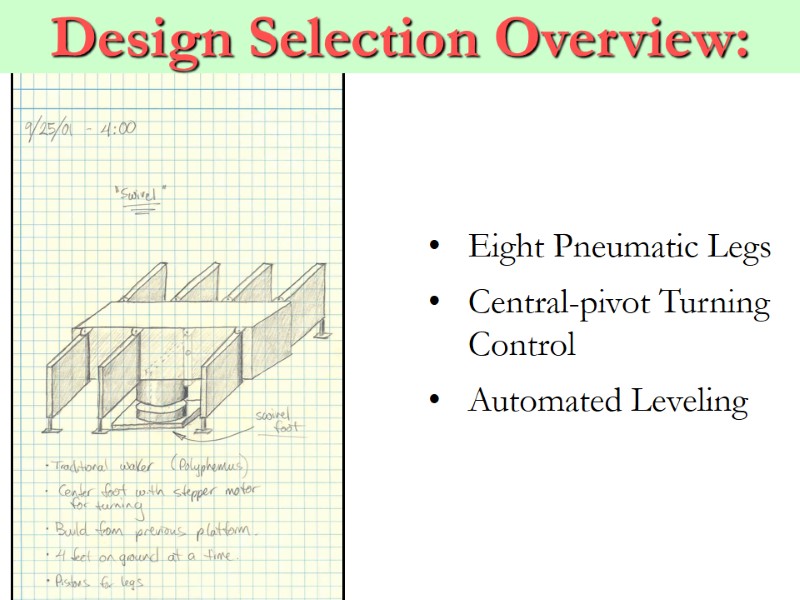
Design Selection Overview: Eight Pneumatic Legs Central-pivot Turning Control Automated Leveling
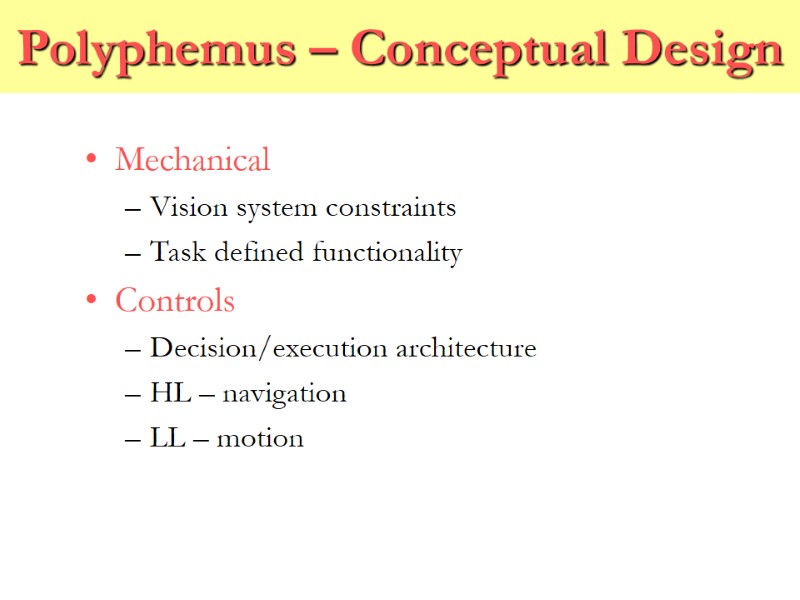
Polyphemus – Conceptual Design Mechanical Vision system constraints Task defined functionality Controls Decision/execution architecture HL – navigation LL – motion
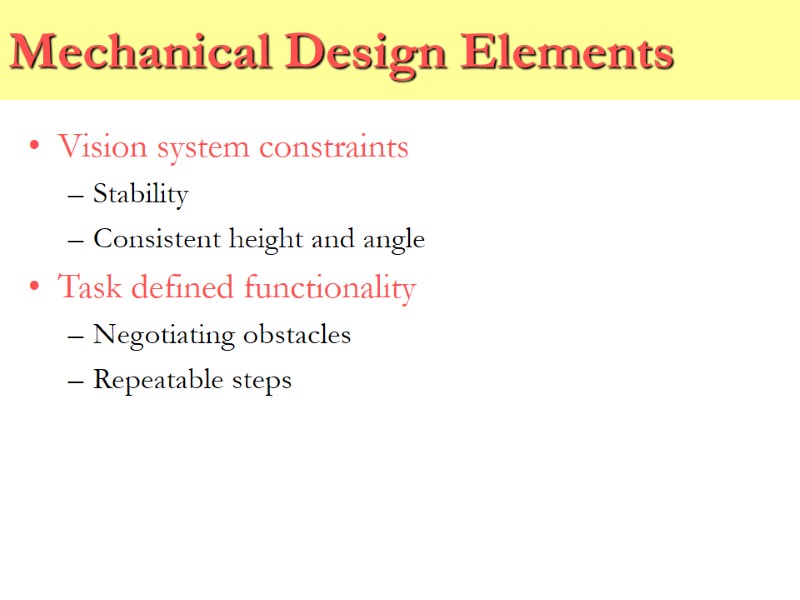
Mechanical Design Elements Vision system constraints Stability Consistent height and angle Task defined functionality Negotiating obstacles Repeatable steps
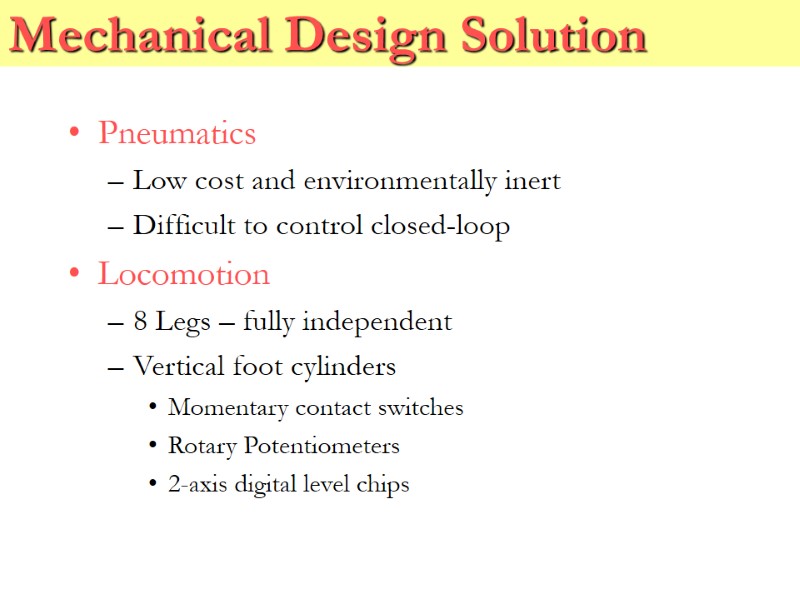
Mechanical Design Solution Pneumatics Low cost and environmentally inert Difficult to control closed-loop Locomotion 8 Legs – fully independent Vertical foot cylinders Momentary contact switches Rotary Potentiometers 2-axis digital level chips
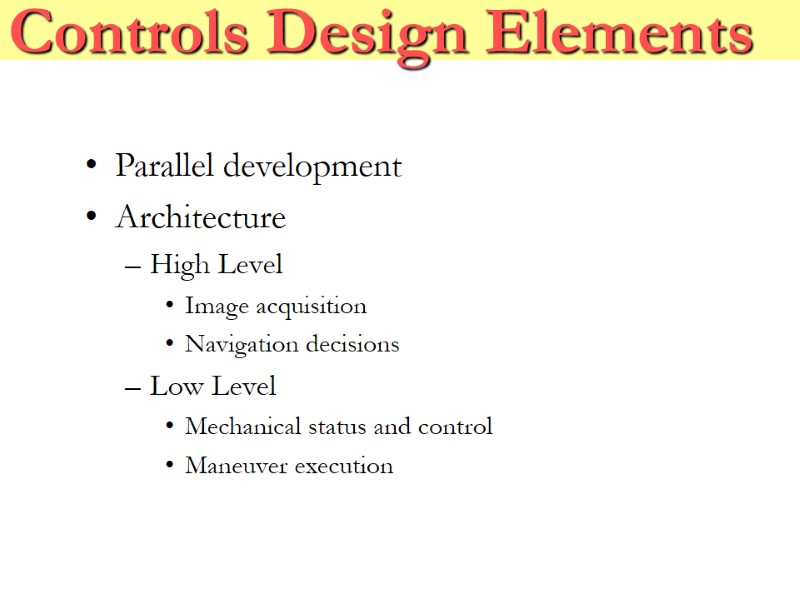
Controls Design Elements Parallel development Architecture High Level Image acquisition Navigation decisions Low Level Mechanical status and control Maneuver execution
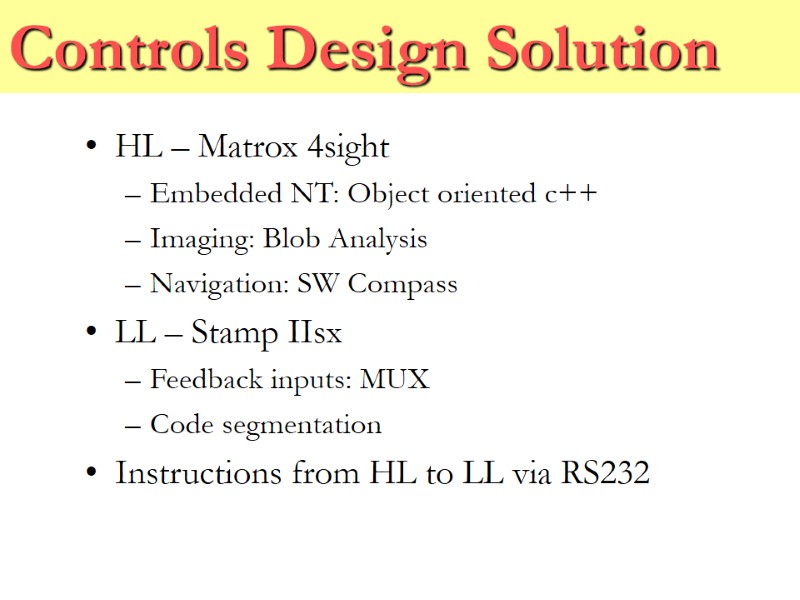
Controls Design Solution HL – Matrox 4sight Embedded NT: Object oriented c++ Imaging: Blob Analysis Navigation: SW Compass LL – Stamp IIsx Feedback inputs: MUX Code segmentation Instructions from HL to LL via RS232
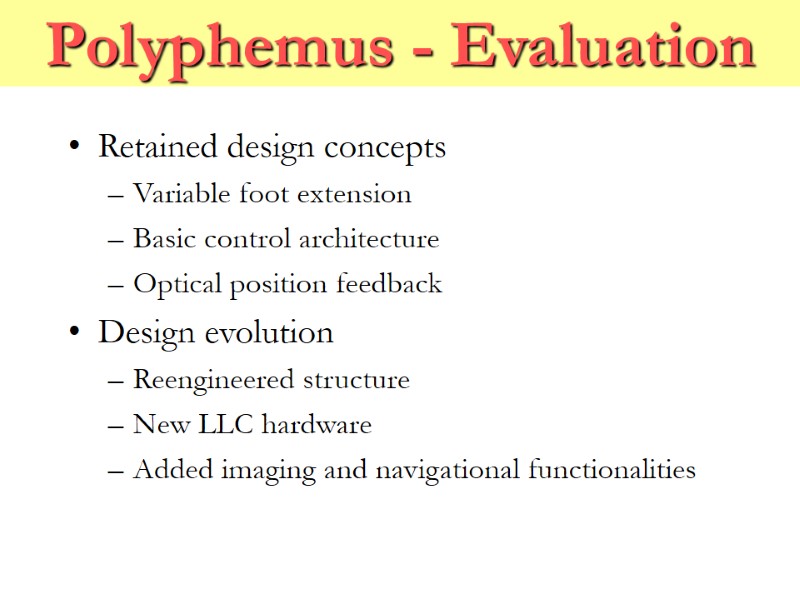
Polyphemus - Evaluation Retained design concepts Variable foot extension Basic control architecture Optical position feedback Design evolution Reengineered structure New LLC hardware Added imaging and navigational functionalities
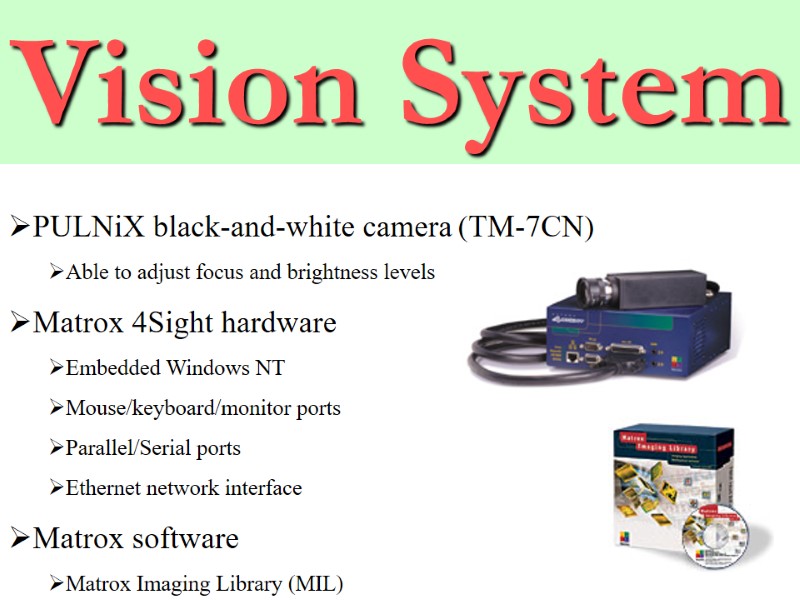
Vision System PULNiX black-and-white camera (TM-7CN) Able to adjust focus and brightness levels Matrox 4Sight hardware Embedded Windows NT Mouse/keyboard/monitor ports Parallel/Serial ports Ethernet network interface Matrox software Matrox Imaging Library (MIL)
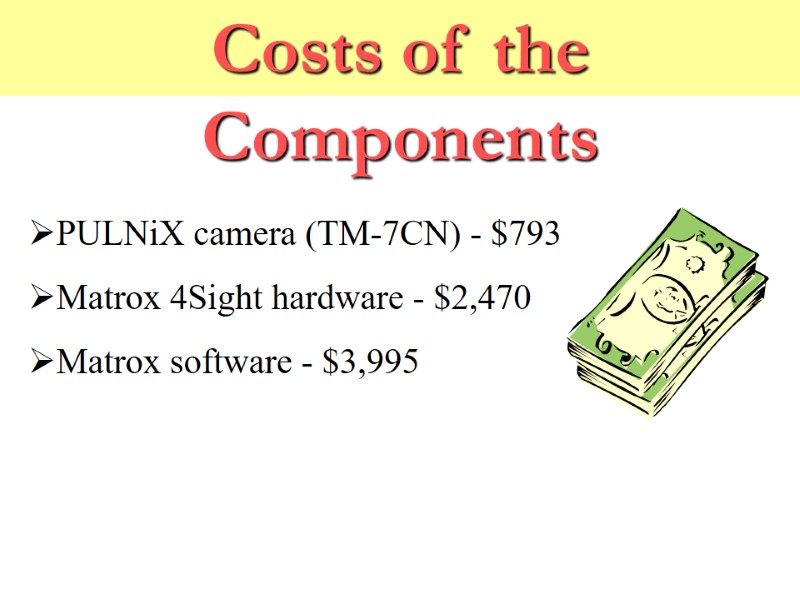
Costs of the Components PULNiX camera (TM-7CN) - $793 Matrox 4Sight hardware - $2,470 Matrox software - $3,995
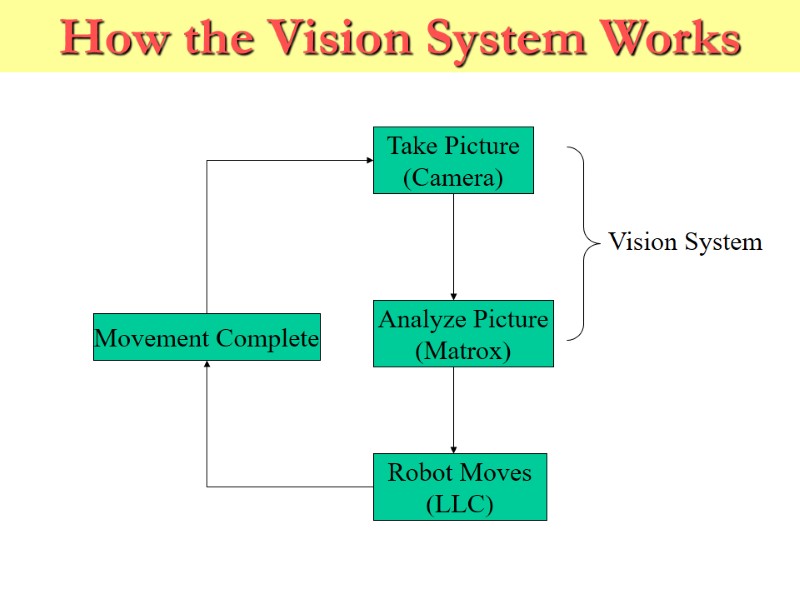
How the Vision System Works Vision System

Existing Code C++ Microsoft Visual C++ Coding done in classes More than one person can work on code at a time
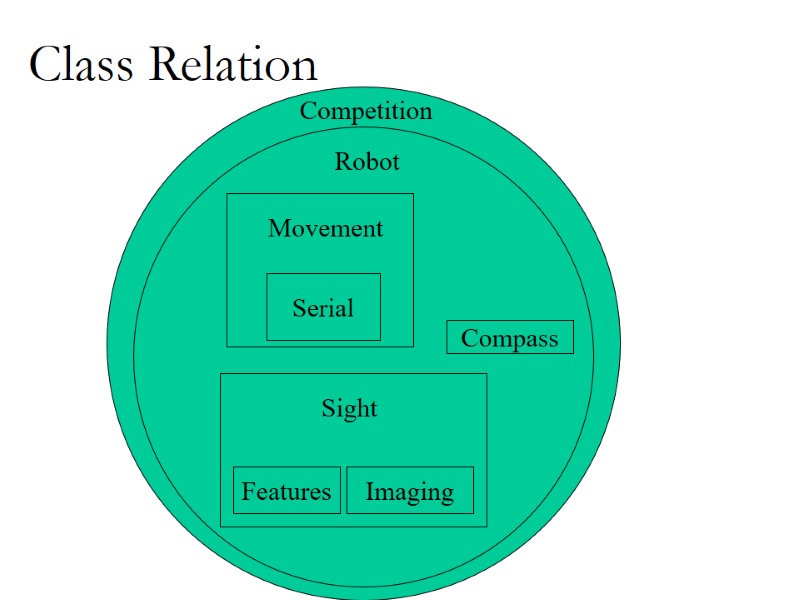
Class Relation Competition Robot Compass Features Imaging Sight
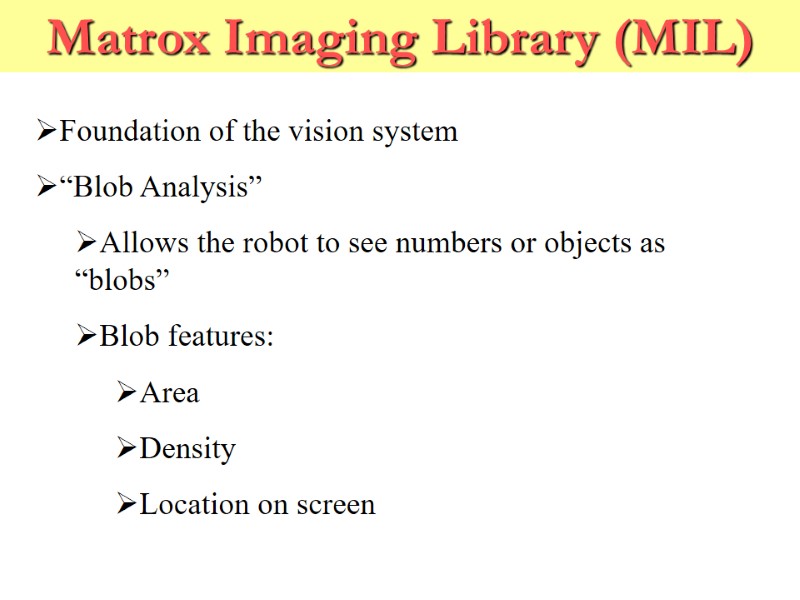
Matrox Imaging Library (MIL) Foundation of the vision system “Blob Analysis” Allows the robot to see numbers or objects as “blobs” Blob features: Area Density Location on screen
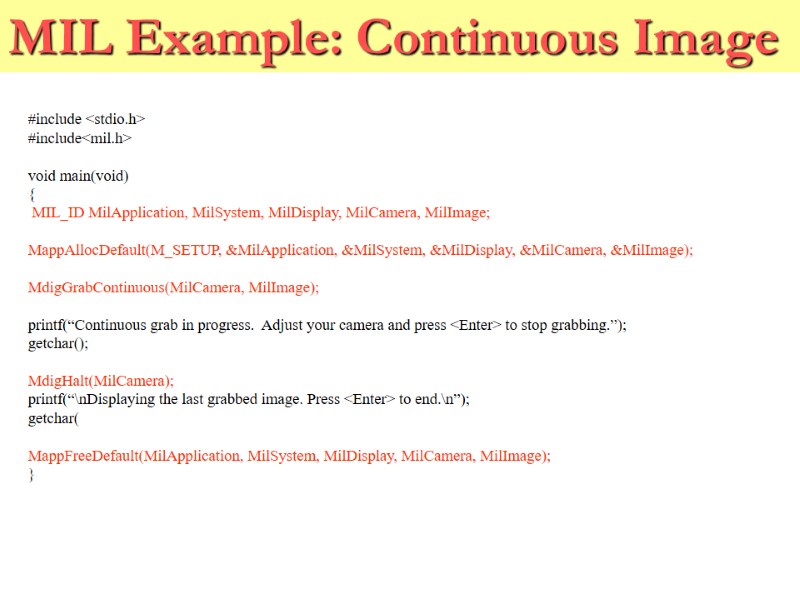
MIL Example: Continuous Image #include
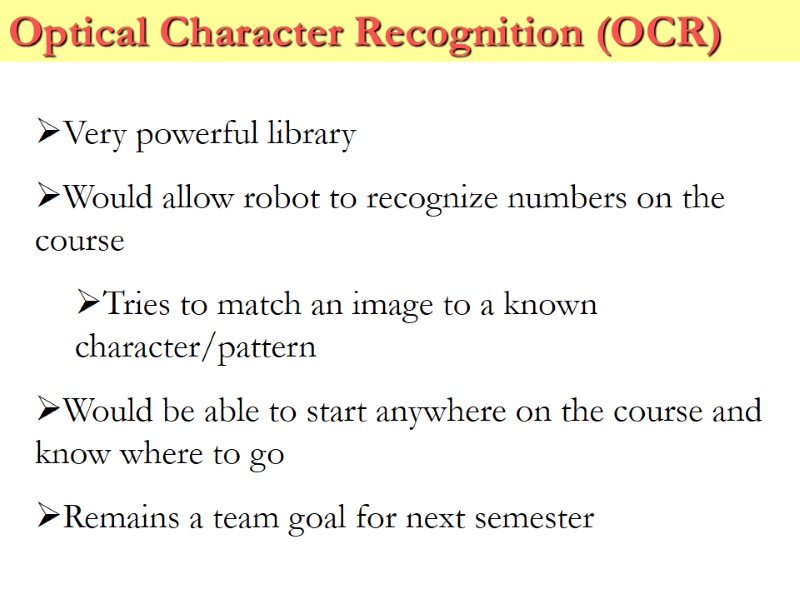
Optical Character Recognition (OCR) Very powerful library Would allow robot to recognize numbers on the course Tries to match an image to a known character/pattern Would be able to start anywhere on the course and know where to go Remains a team goal for next semester
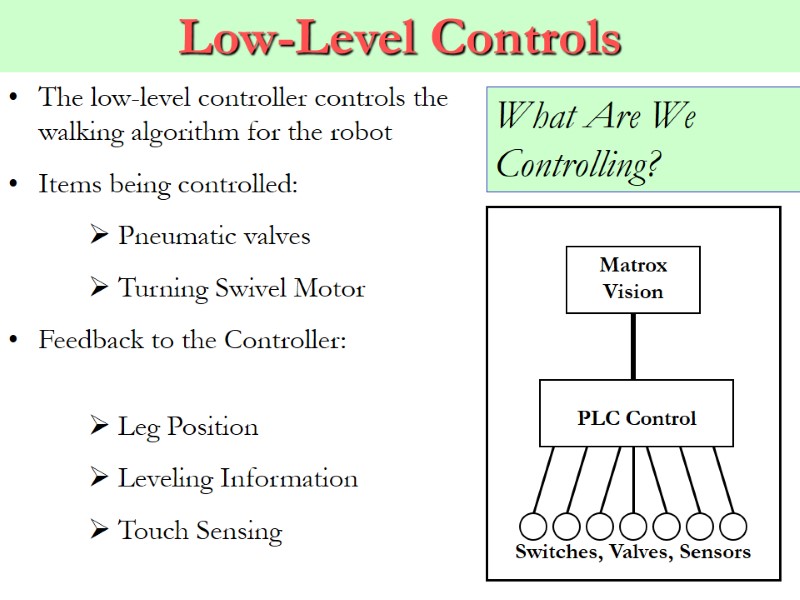
What Are We Controlling? The low-level controller controls the walking algorithm for the robot Items being controlled: Pneumatic valves Turning Swivel Motor Feedback to the Controller: Leg Position Leveling Information Touch Sensing Low-Level Controls
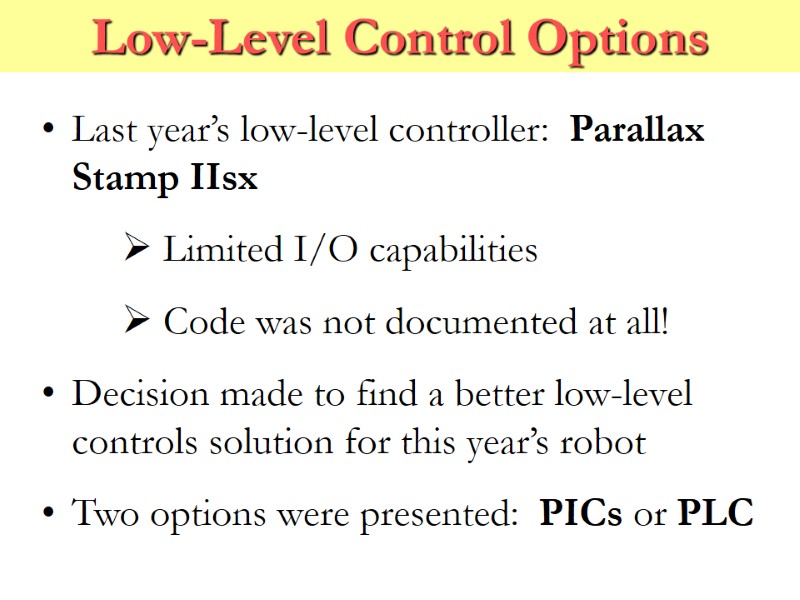
Low-Level Control Options Last year’s low-level controller: Parallax Stamp IIsx Limited I/O capabilities Code was not documented at all! Decision made to find a better low-level controls solution for this year’s robot Two options were presented: PICs or PLC
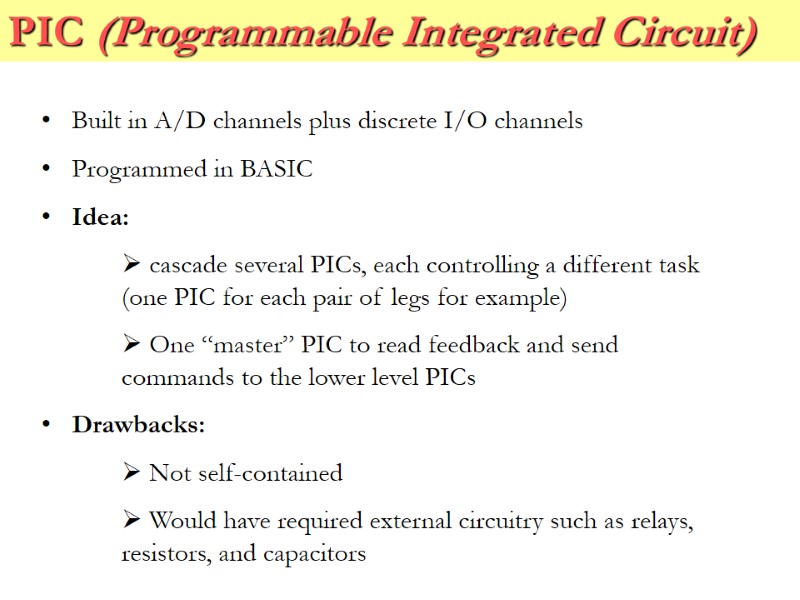
PIC (Programmable Integrated Circuit) Built in A/D channels plus discrete I/O channels Programmed in BASIC Idea: cascade several PICs, each controlling a different task (one PIC for each pair of legs for example) One “master” PIC to read feedback and send commands to the lower level PICs Drawbacks: Not self-contained Would have required external circuitry such as relays, resistors, and capacitors
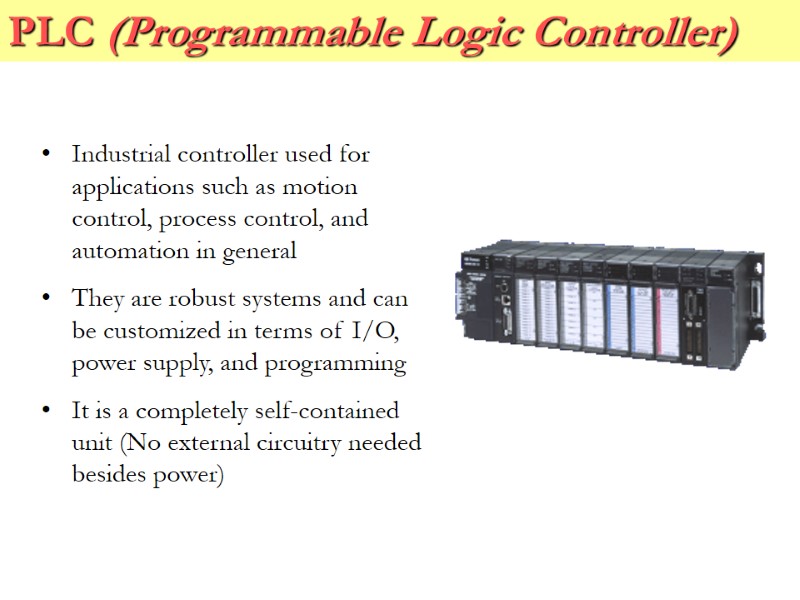
PLC (Programmable Logic Controller) Industrial controller used for applications such as motion control, process control, and automation in general They are robust systems and can be customized in terms of I/O, power supply, and programming It is a completely self-contained unit (No external circuitry needed besides power)
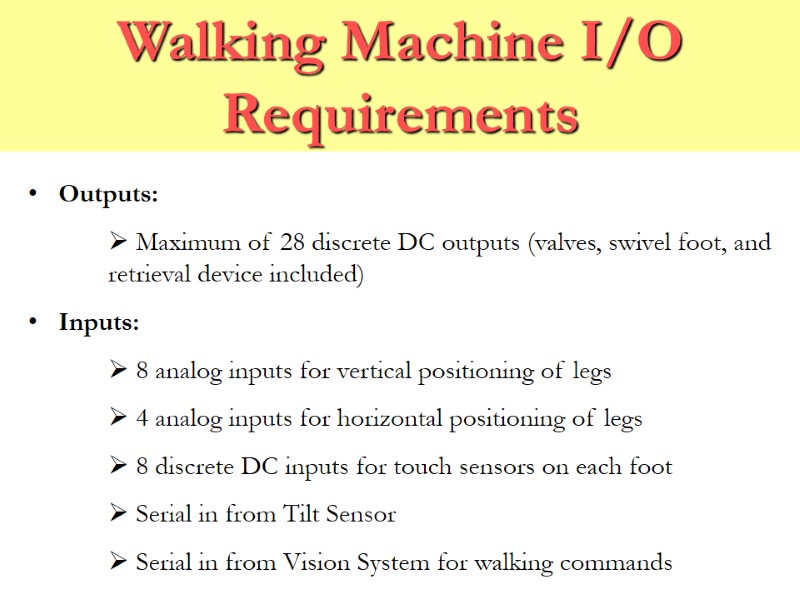
Walking Machine I/O Requirements Outputs: Maximum of 28 discrete DC outputs (valves, swivel foot, and retrieval device included) Inputs: 8 analog inputs for vertical positioning of legs 4 analog inputs for horizontal positioning of legs 8 discrete DC inputs for touch sensors on each foot Serial in from Tilt Sensor Serial in from Vision System for walking commands

GE Fanuc Series 90-30 PLC Main Rack Slot 0: 24 VDC power supply Main Rack Slot 1: Series 90-30 CPU Main Rack Slot 2: Programmable Co-processor (RS-232 compatible) Main Rack Slot 3: 16 Circuit Input Analog Voltage Main Rack Slot 4: 16 Circuit Input 24 VDC Main Rack Slot 5: 16 Circuit Relay Output Main Rack Slot 6: 16 Circuit Relay Output
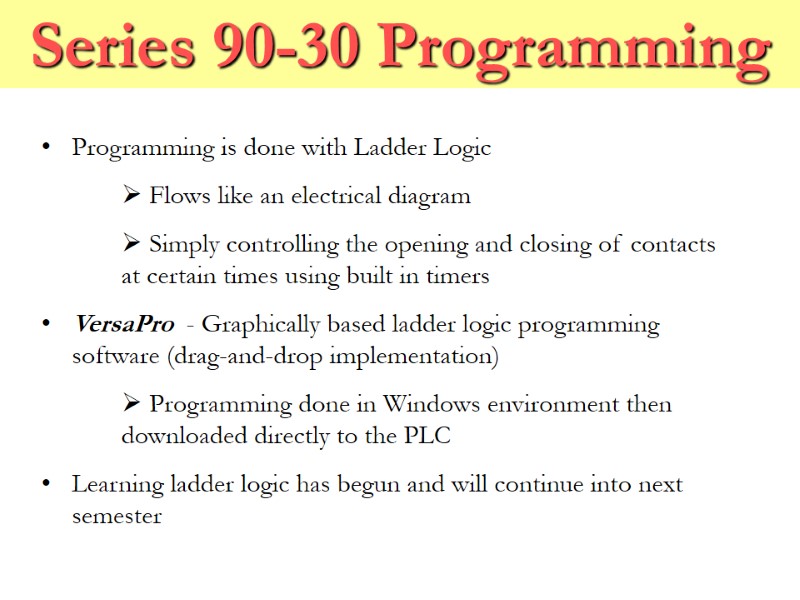
Series 90-30 Programming Programming is done with Ladder Logic Flows like an electrical diagram Simply controlling the opening and closing of contacts at certain times using built in timers VersaPro - Graphically based ladder logic programming software (drag-and-drop implementation) Programming done in Windows environment then downloaded directly to the PLC Learning ladder logic has begun and will continue into next semester
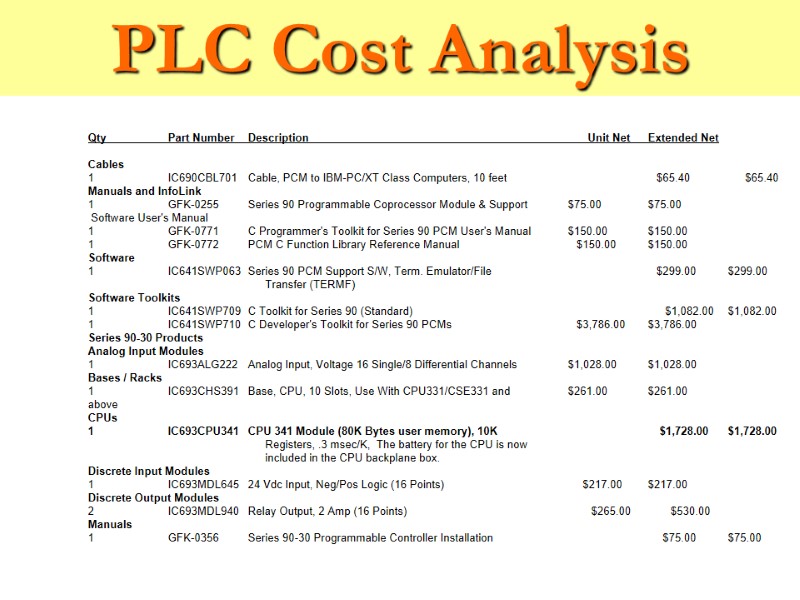
PLC Cost Analysis Qty Part Number Description Unit Net Extended Net Cables 1 IC690CBL701 Cable, PCM to IBM-PC/XT Class Computers, 10 feet $65.40 $65.40 Manuals and InfoLink 1 GFK-0255 Series 90 Programmable Coprocessor Module & Support $75.00 $75.00 Software User's Manual 1 GFK-0771 C Programmer's Toolkit for Series 90 PCM User's Manual $150.00 $150.00 1 GFK-0772 PCM C Function Library Reference Manual $150.00 $150.00 Software 1 IC641SWP063 Series 90 PCM Support S/W, Term. Emulator/File $299.00 $299.00 Transfer (TERMF) Software Toolkits 1 IC641SWP709 C Toolkit for Series 90 (Standard) $1,082.00 $1,082.00 1 IC641SWP710 C Developer's Toolkit for Series 90 PCMs $3,786.00 $3,786.00 Series 90-30 Products Analog Input Modules 1 IC693ALG222 Analog Input, Voltage 16 Single/8 Differential Channels $1,028.00 $1,028.00 Bases / Racks 1 IC693CHS391 Base, CPU, 10 Slots, Use With CPU331/CSE331 and $261.00 $261.00 above CPUs 1 IC693CPU341 CPU 341 Module (80K Bytes user memory), 10K $1,728.00 $1,728.00 Registers, .3 msec/K, The battery for the CPU is now included in the CPU backplane box. Discrete Input Modules 1 IC693MDL645 24 Vdc Input, Neg/Pos Logic (16 Points) $217.00 $217.00 Discrete Output Modules 2 IC693MDL940 Relay Output, 2 Amp (16 Points) $265.00 $530.00 Manuals 1 GFK-0356 Series 90-30 Programmable Controller Installation $75.00 $75.00
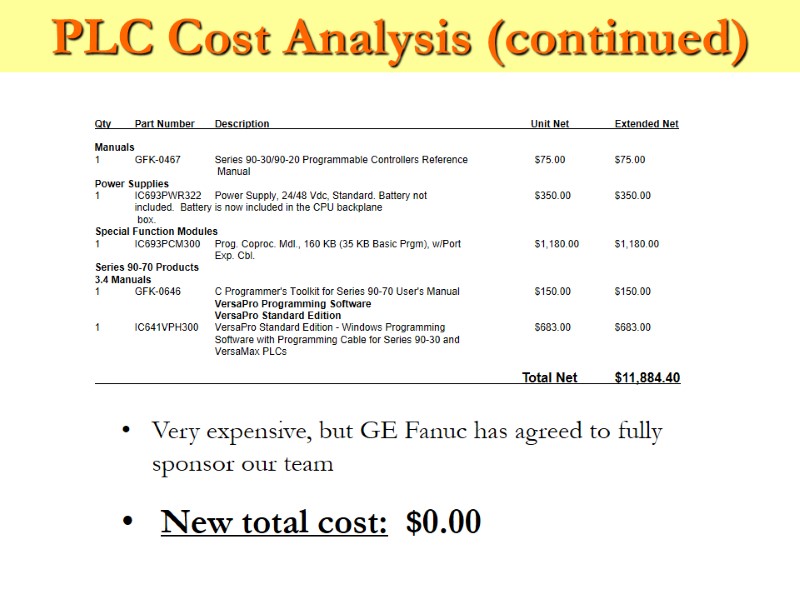
PLC Cost Analysis (continued) Qty Part Number Description Unit Net Extended Net Manuals GFK-0467 Series 90-30/90-20 Programmable Controllers Reference $75.00 $75.00 Manual Power Supplies 1 IC693PWR322 Power Supply, 24/48 Vdc, Standard. Battery not $350.00 $350.00 included. Battery is now included in the CPU backplane box. Special Function Modules 1 IC693PCM300 Prog. Coproc. Mdl., 160 KB (35 KB Basic Prgm), w/Port $1,180.00 $1,180.00 Exp. Cbl. Series 90-70 Products 3.4 Manuals 1 GFK-0646 C Programmer's Toolkit for Series 90-70 User's Manual $150.00 $150.00 VersaPro Programming Software VersaPro Standard Edition 1 IC641VPH300 VersaPro Standard Edition - Windows Programming $683.00 $683.00 Software with Programming Cable for Series 90-30 and VersaMax PLCs Total Net $11,884.40 Very expensive, but GE Fanuc has agreed to fully sponsor our team New total cost: $0.00
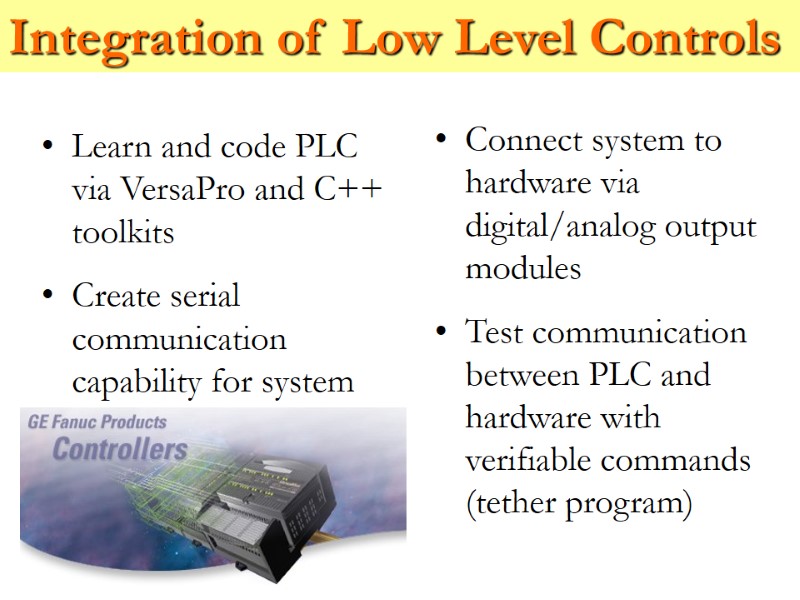
Integration of Low Level Controls Connect system to hardware via digital/analog output modules Test communication between PLC and hardware with verifiable commands (tether program)
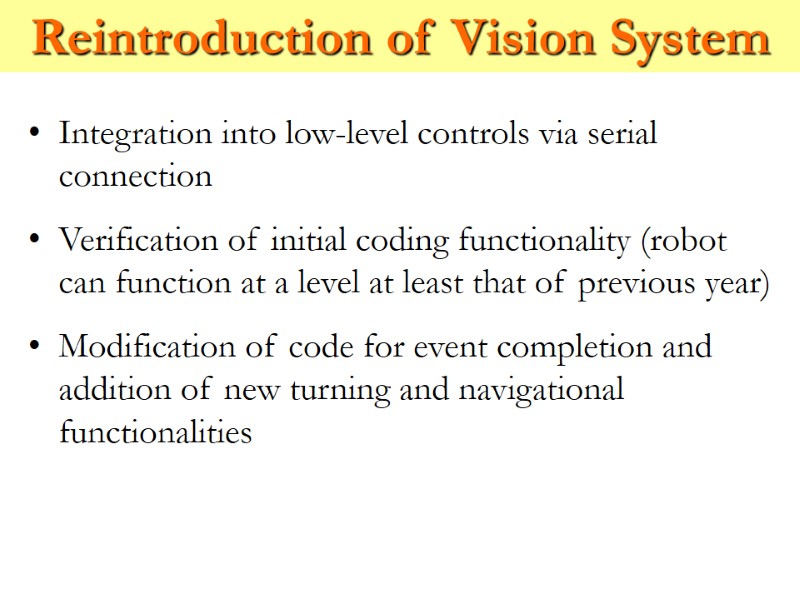
Reintroduction of Vision System Integration into low-level controls via serial connection Verification of initial coding functionality (robot can function at a level at least that of previous year) Modification of code for event completion and addition of new turning and navigational functionalities
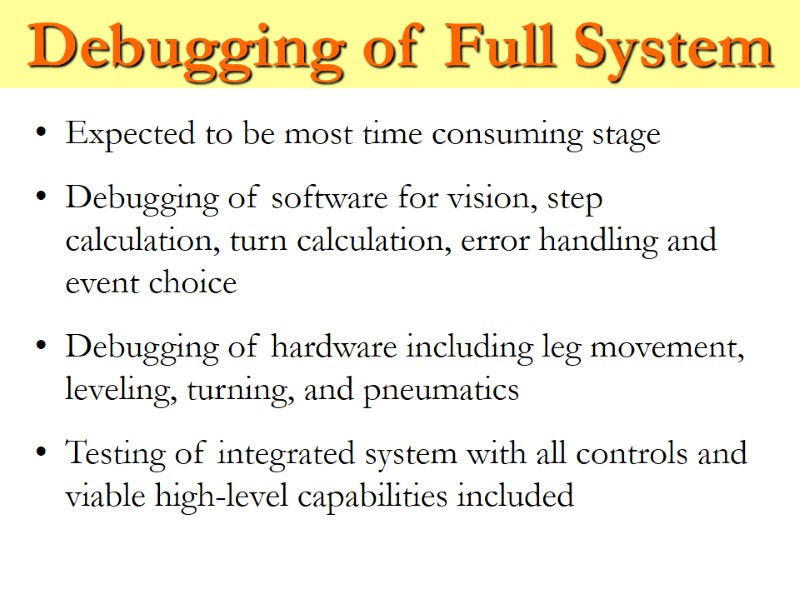
Debugging of Full System Expected to be most time consuming stage Debugging of software for vision, step calculation, turn calculation, error handling and event choice Debugging of hardware including leg movement, leveling, turning, and pneumatics Testing of integrated system with all controls and viable high-level capabilities included
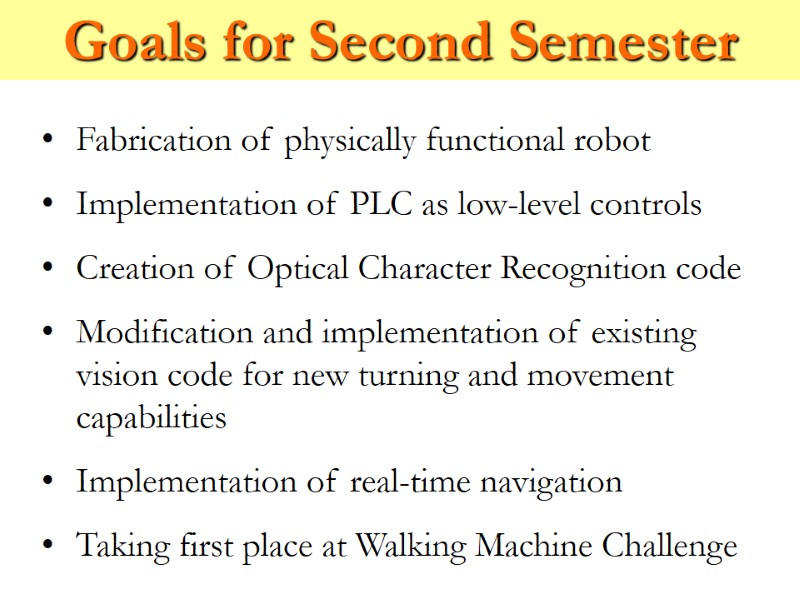
Goals for Second Semester Fabrication of physically functional robot Implementation of PLC as low-level controls Creation of Optical Character Recognition code Modification and implementation of existing vision code for new turning and movement capabilities Implementation of real-time navigation Taking first place at Walking Machine Challenge
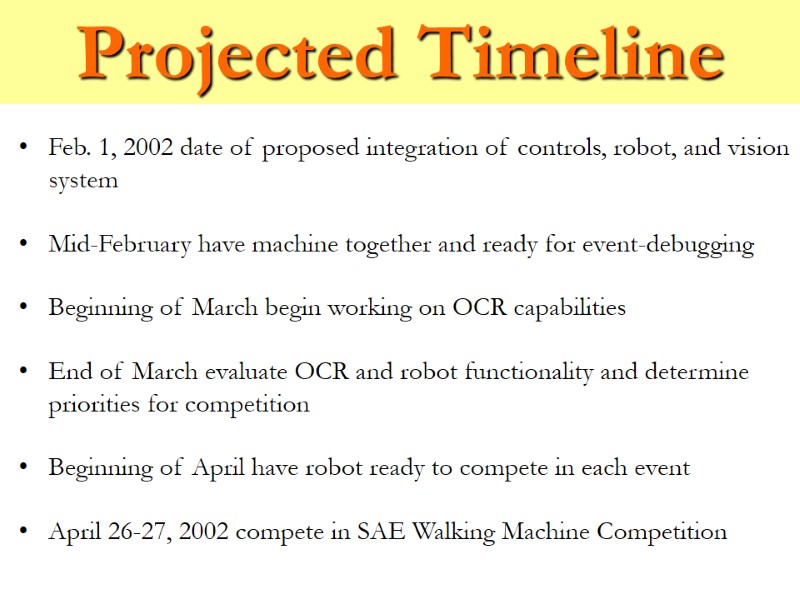
Projected Timeline Feb. 1, 2002 date of proposed integration of controls, robot, and vision system Mid-February have machine together and ready for event-debugging Beginning of March begin working on OCR capabilities End of March evaluate OCR and robot functionality and determine priorities for competition Beginning of April have robot ready to compete in each event April 26-27, 2002 compete in SAE Walking Machine Competition
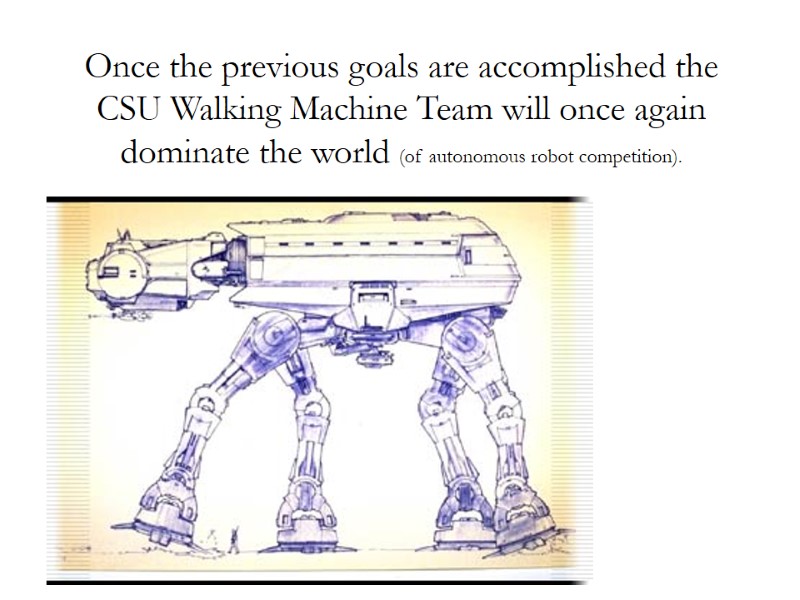
Once the previous goals are accomplished the CSU Walking Machine Team will once again dominate the world (of autonomous robot competition).

Problems to Solve for PSU class 1. Give examples of each of the following joints in real-life mechanisms: pins, hinges, bearings, bushings, sliders. 2. Give examples of robots using each of the above joints. If you do not recall a robot with them, invent a robot with such joints. 3. Give examples of pivots and cranks.
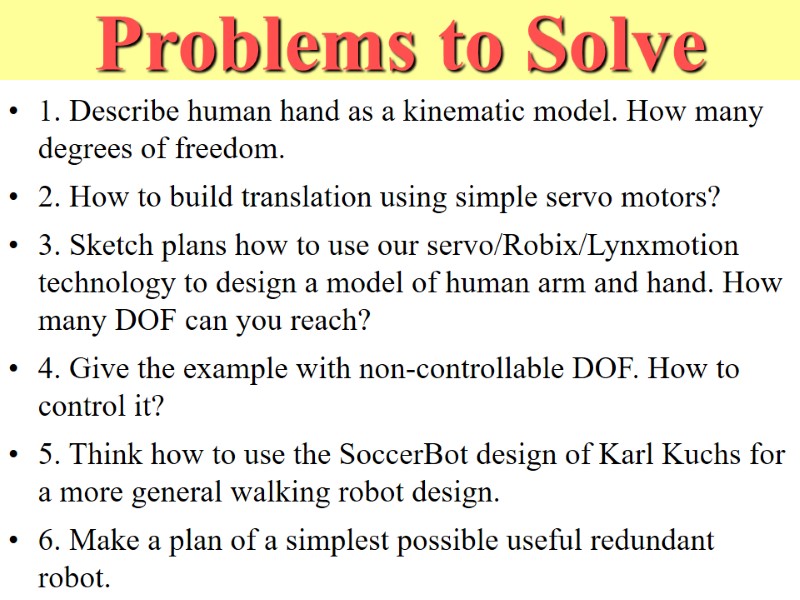
Problems to Solve 1. Describe human hand as a kinematic model. How many degrees of freedom. 2. How to build translation using simple servo motors? 3. Sketch plans how to use our servo/Robix/Lynxmotion technology to design a model of human arm and hand. How many DOF can you reach? 4. Give the example with non-controllable DOF. How to control it? 5. Think how to use the SoccerBot design of Karl Kuchs for a more general walking robot design. 6. Make a plan of a simplest possible useful redundant robot.
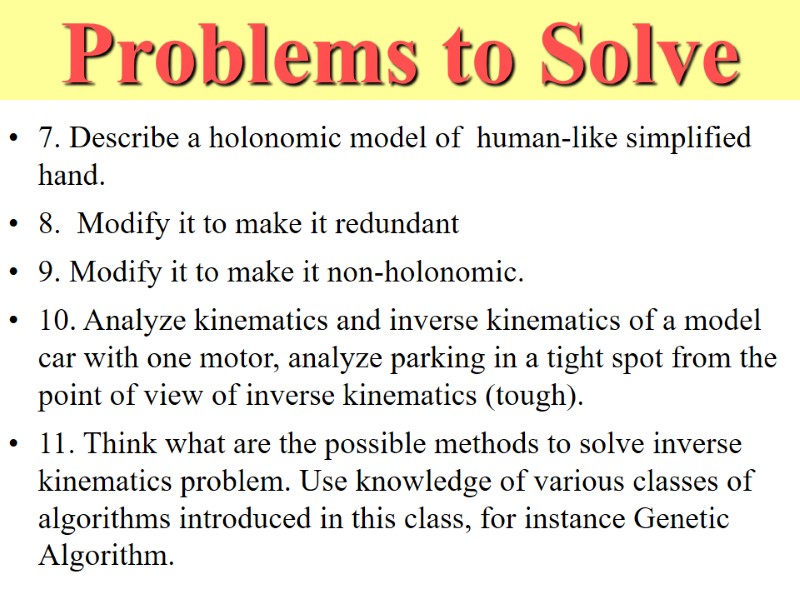
Problems to Solve 7. Describe a holonomic model of human-like simplified hand. 8. Modify it to make it redundant 9. Modify it to make it non-holonomic. 10. Analyze kinematics and inverse kinematics of a model car with one motor, analyze parking in a tight spot from the point of view of inverse kinematics (tough). 11. Think what are the possible methods to solve inverse kinematics problem. Use knowledge of various classes of algorithms introduced in this class, for instance Genetic Algorithm.
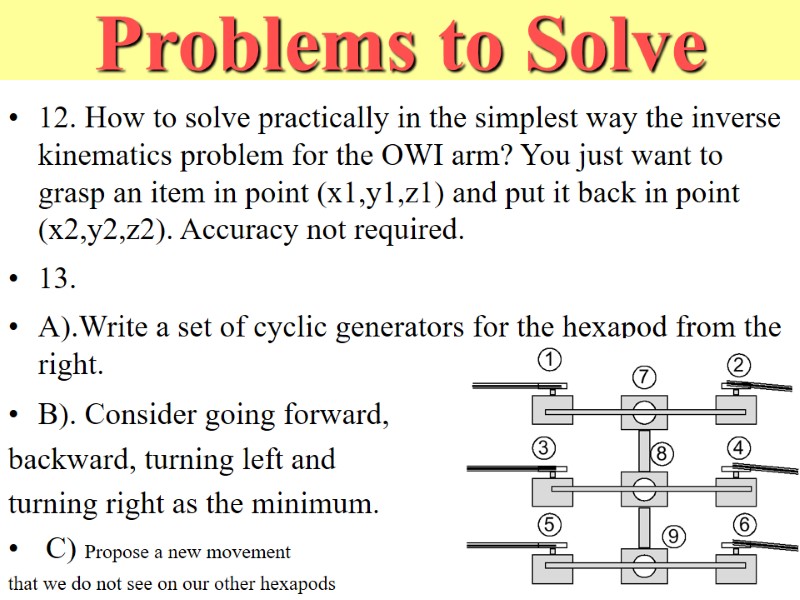
Problems to Solve 12. How to solve practically in the simplest way the inverse kinematics problem for the OWI arm? You just want to grasp an item in point (x1,y1,z1) and put it back in point (x2,y2,z2). Accuracy not required. 13. A).Write a set of cyclic generators for the hexapod from the right. B). Consider going forward, backward, turning left and turning right as the minimum. C) Propose a new movement that we do not see on our other hexapods
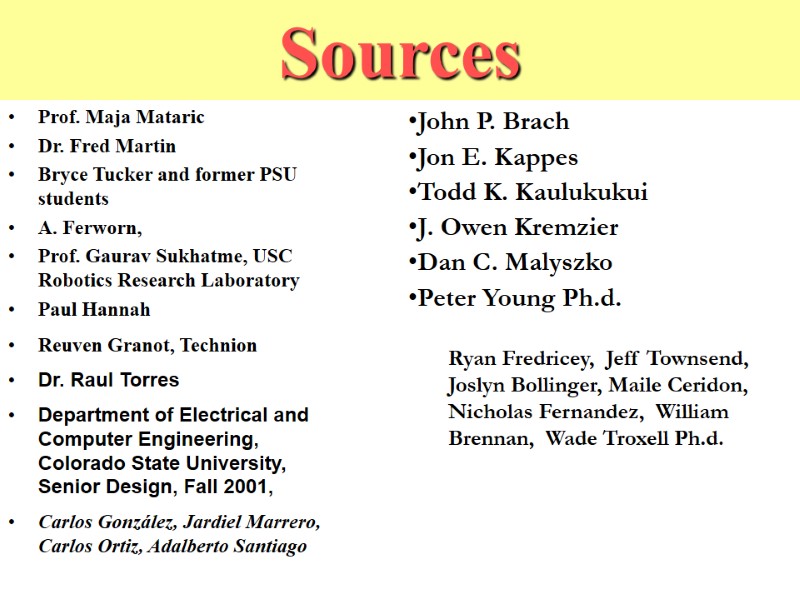
Sources Prof. Maja Mataric Dr. Fred Martin Bryce Tucker and former PSU students A. Ferworn, Prof. Gaurav Sukhatme, USC Robotics Research Laboratory Paul Hannah Reuven Granot, Technion Dr. Raul Torres Department of Electrical and Computer Engineering, Colorado State University, Senior Design, Fall 2001, Carlos González, Jardiel Marrero, Carlos Ortiz, Adalberto Santiago John P. Brach Jon E. Kappes Todd K. Kaulukukui J. Owen Kremzier Dan C. Malyszko Peter Young Ph.d. Ryan Fredricey, Jeff Townsend, Joslyn Bollinger, Maile Ceridon, Nicholas Fernandez, William Brennan, Wade Troxell Ph.d.
20244-026.cont..walking-robots-design.ppt
- Количество слайдов: 152

